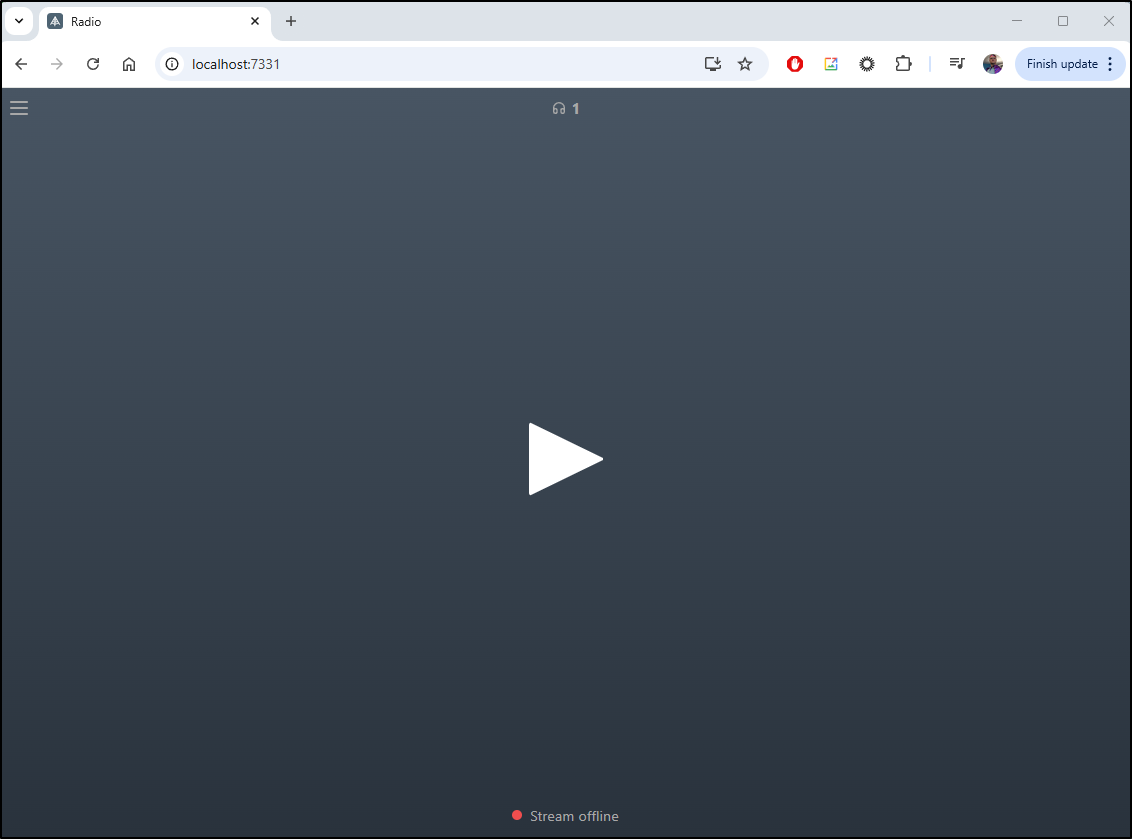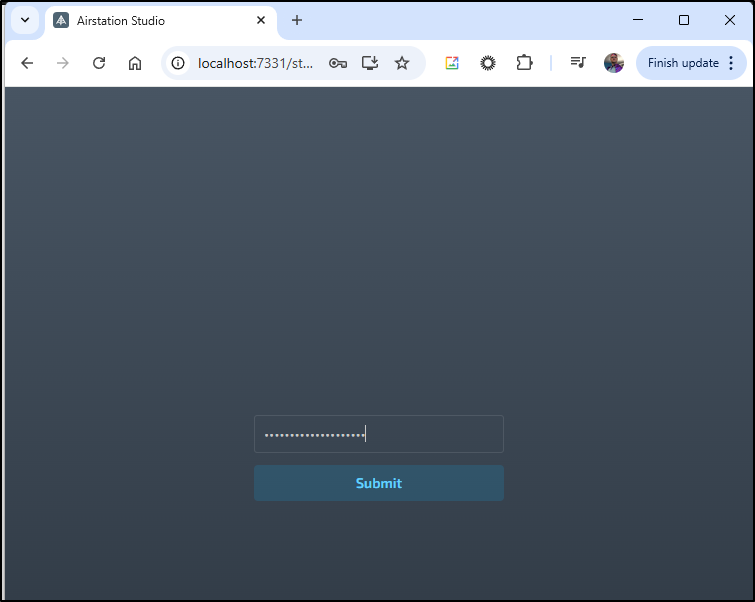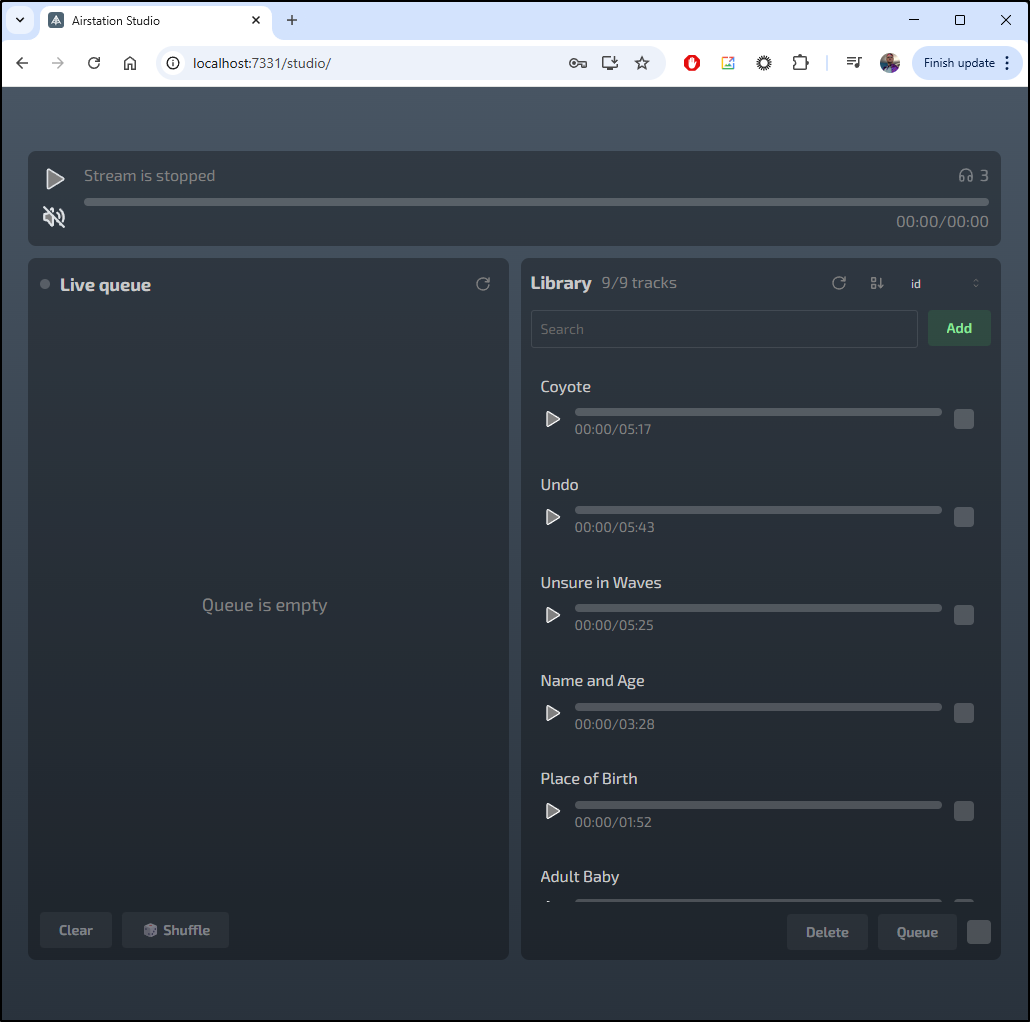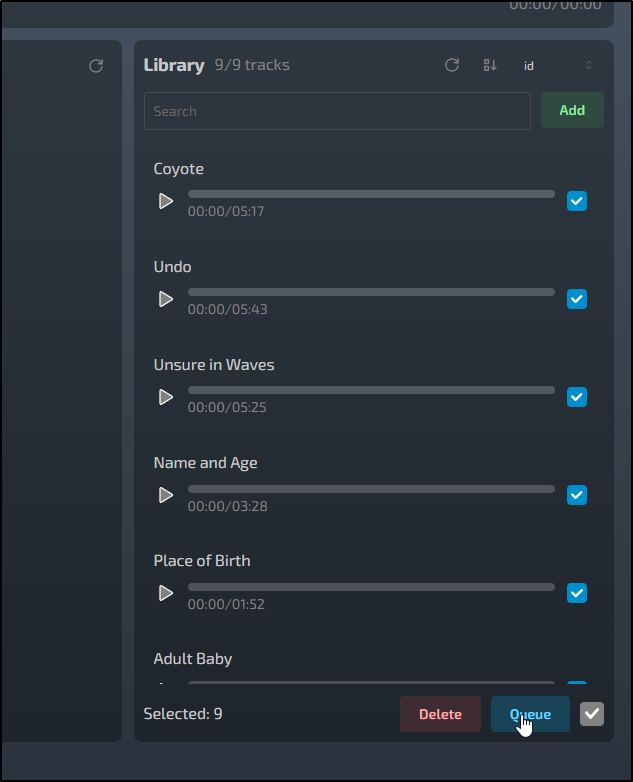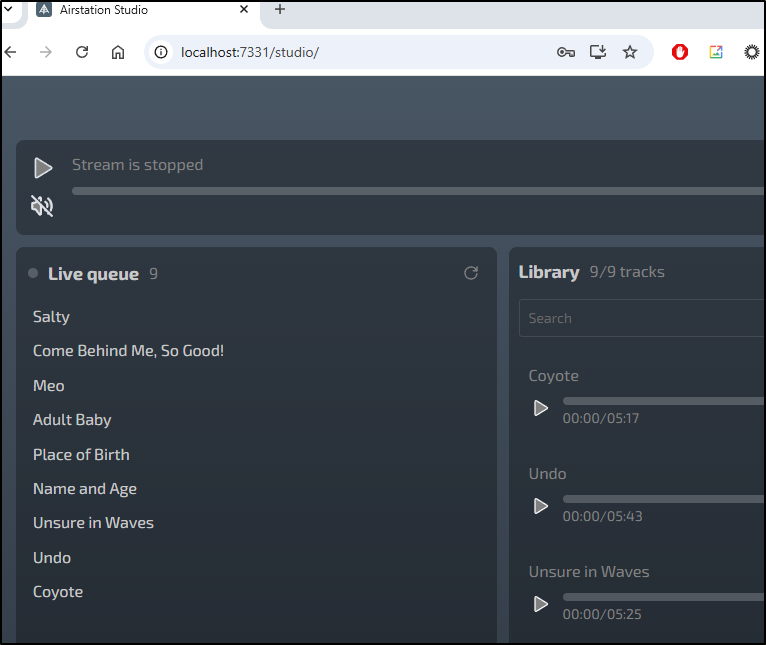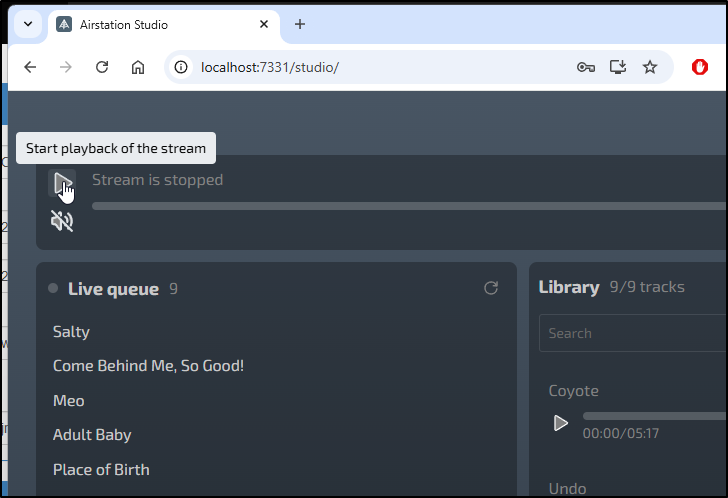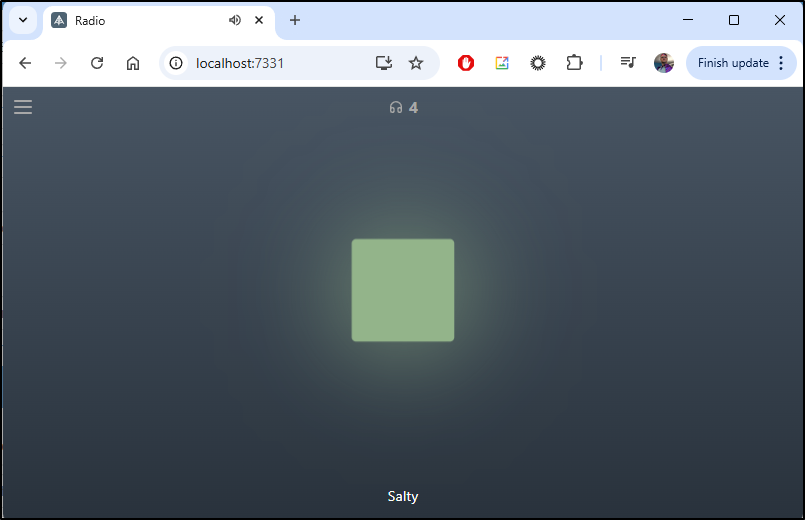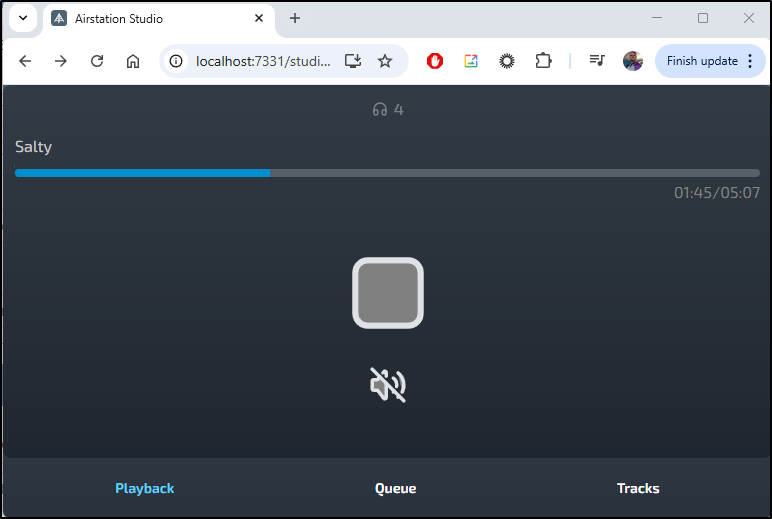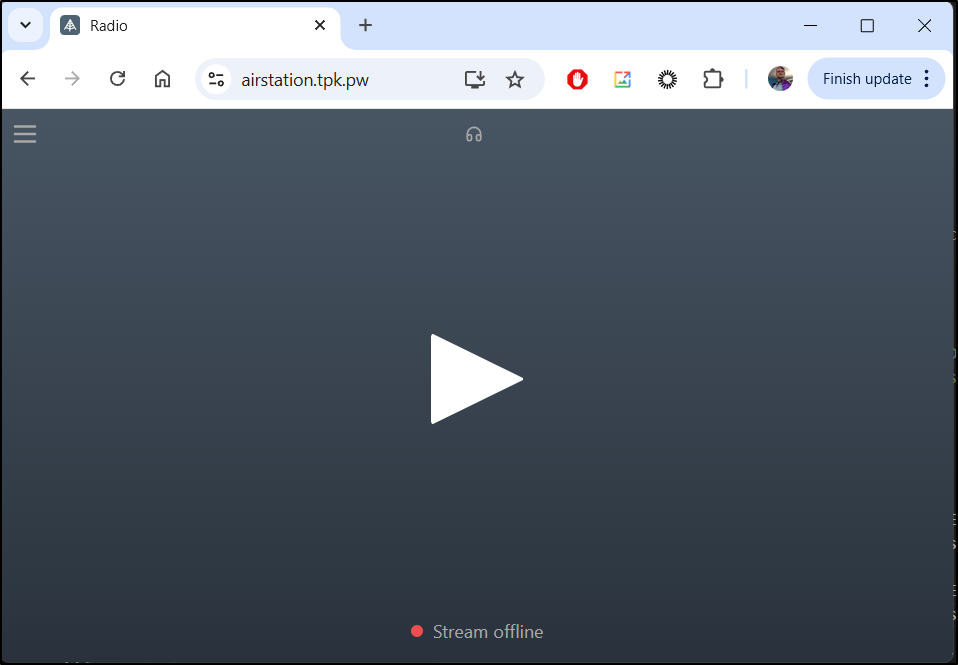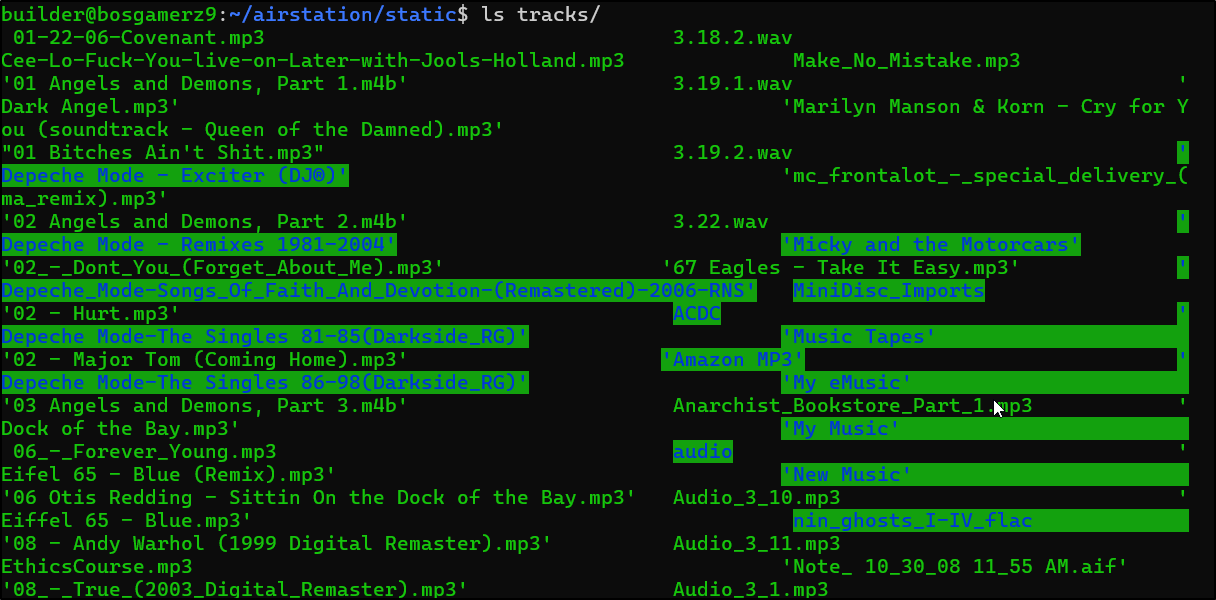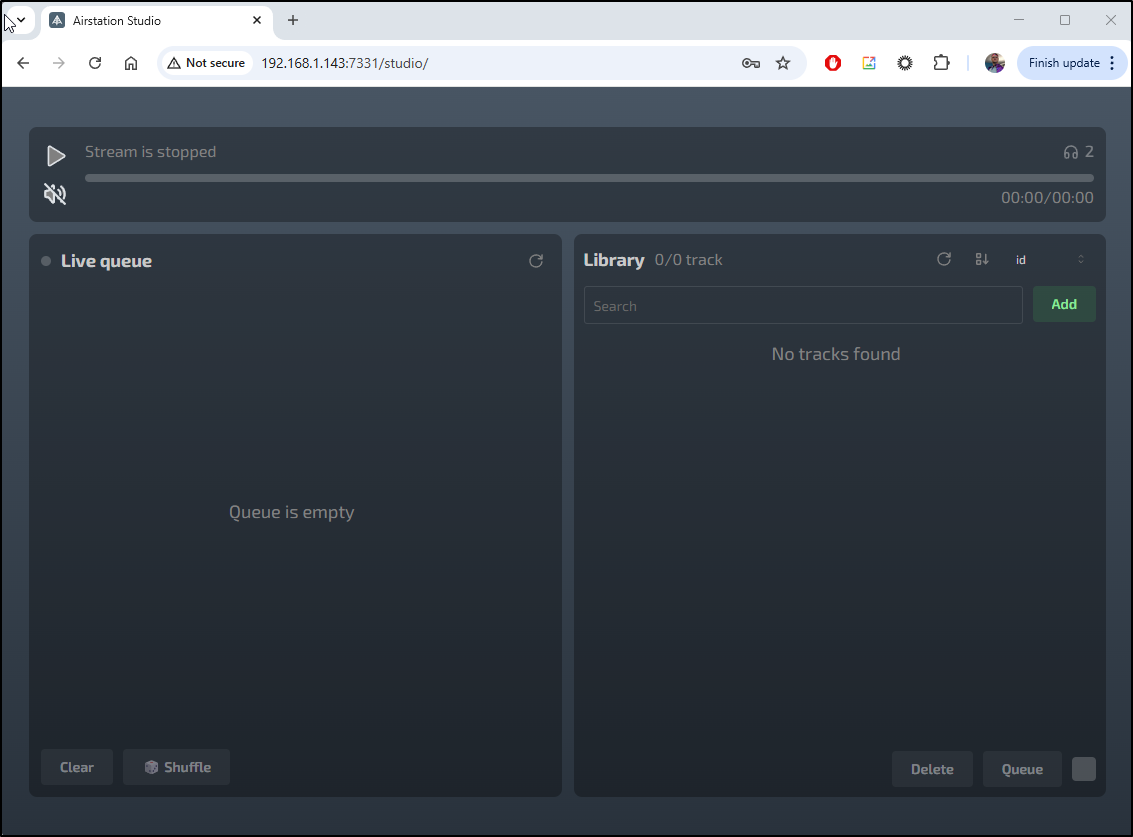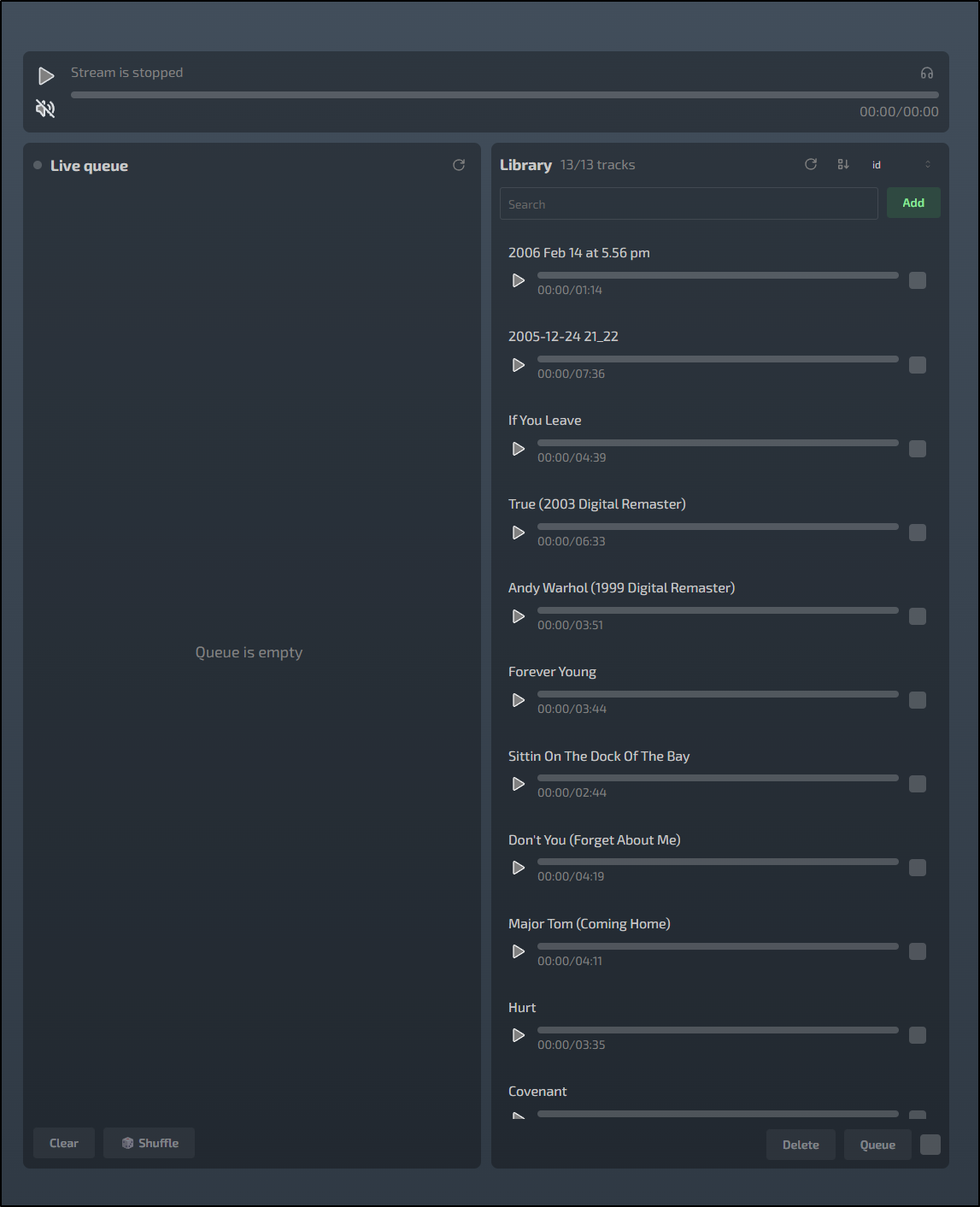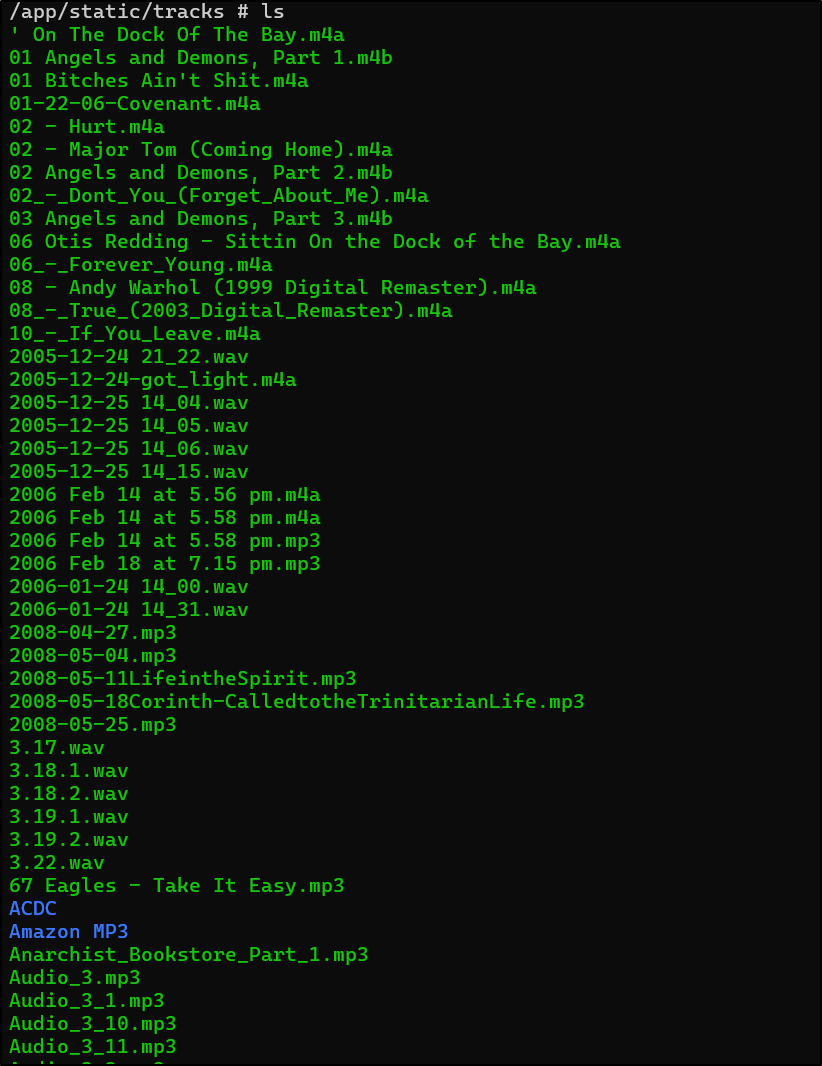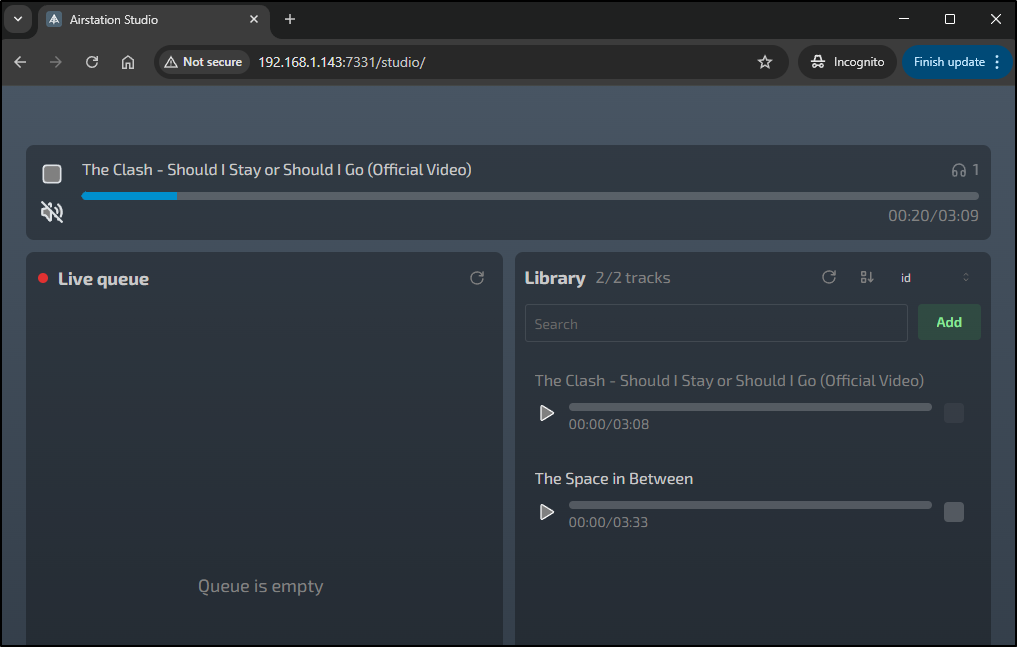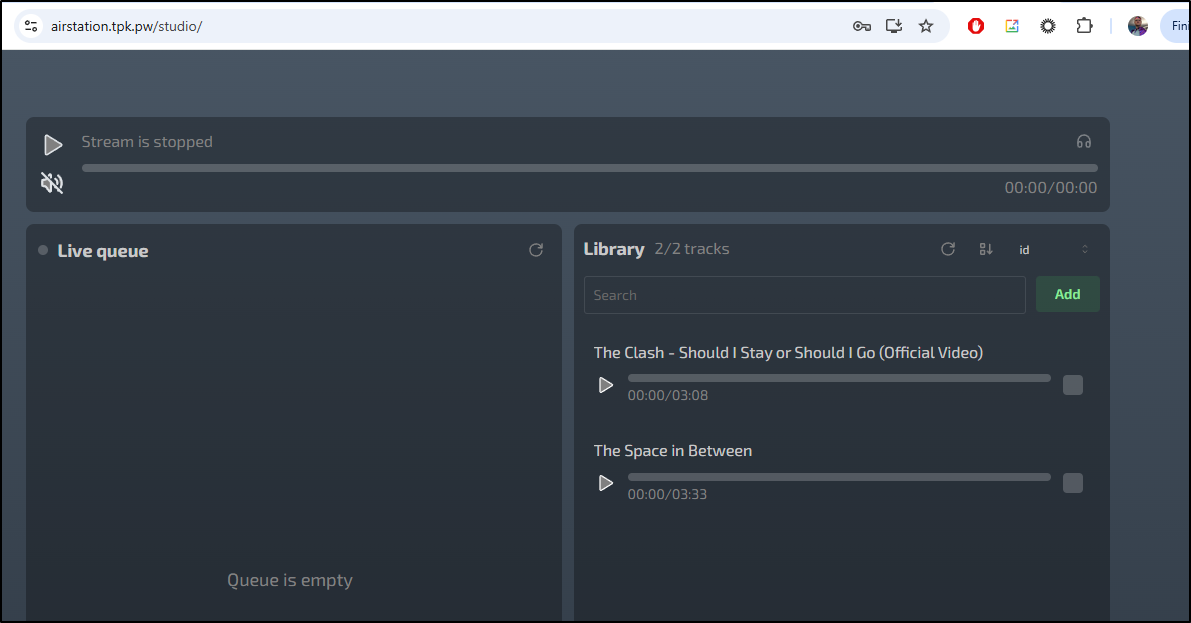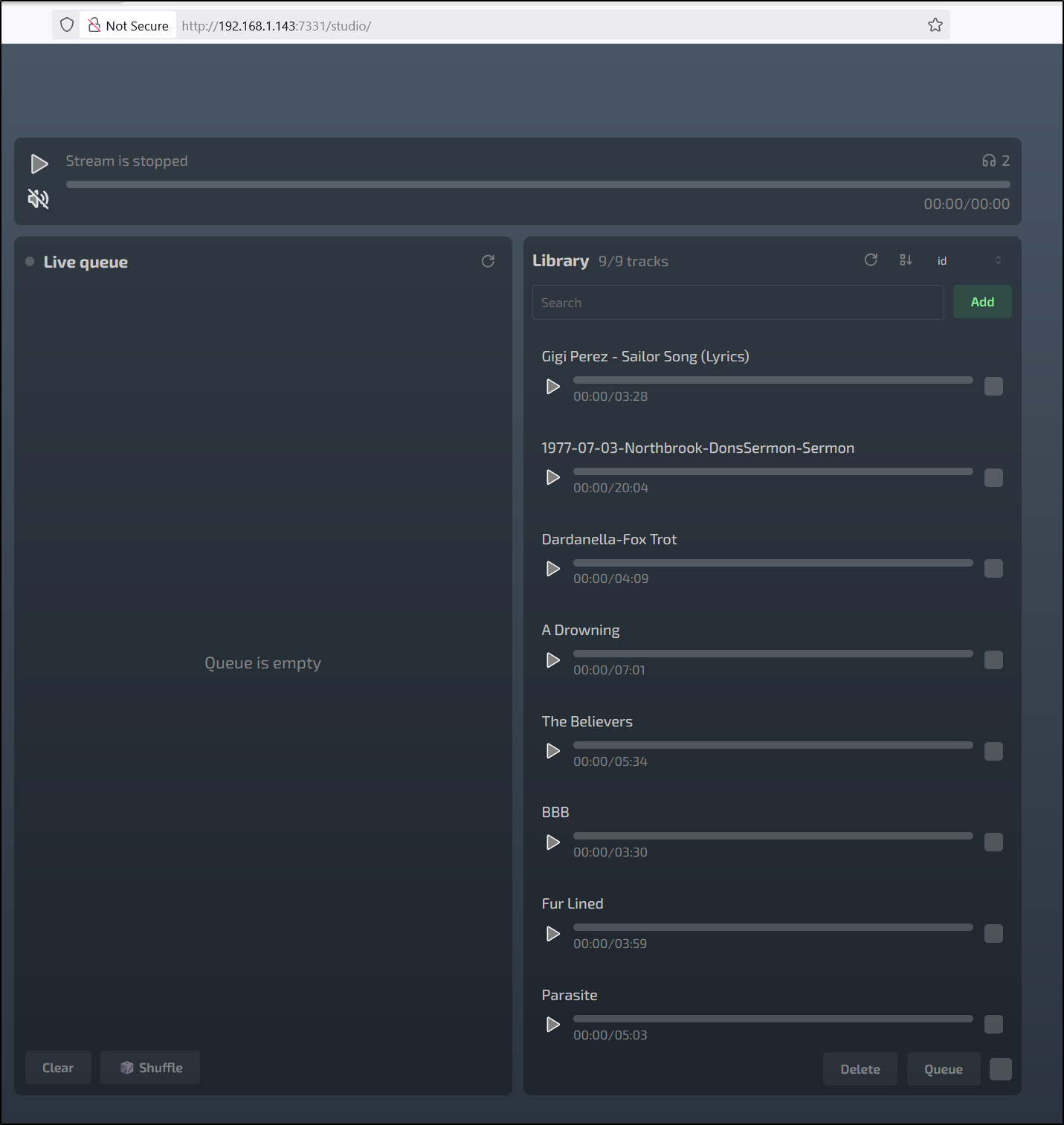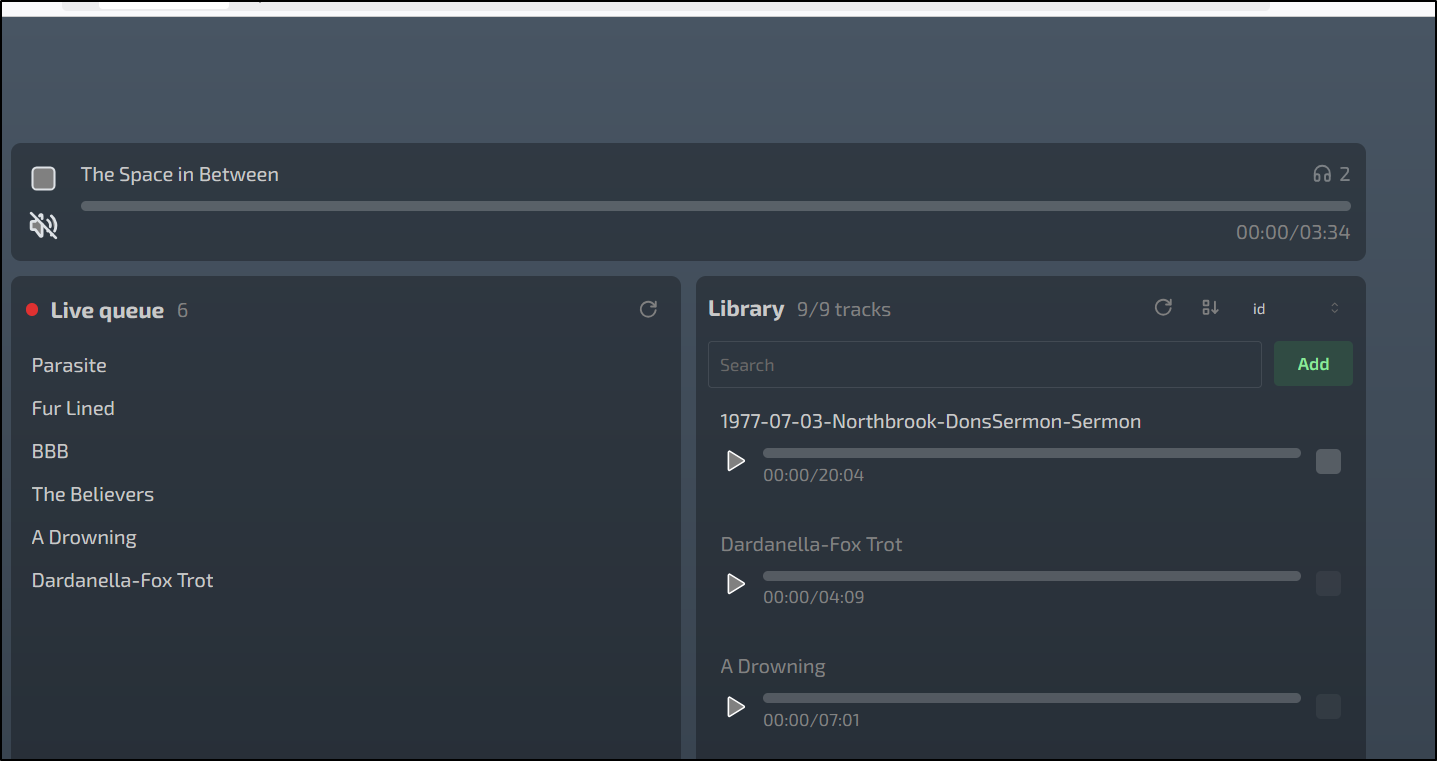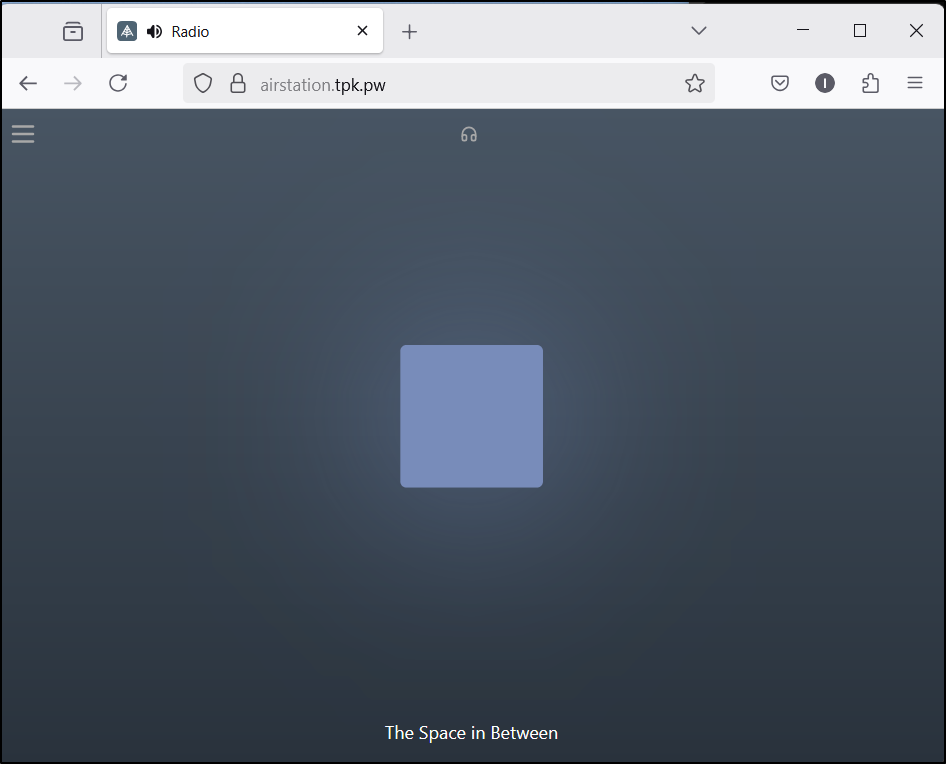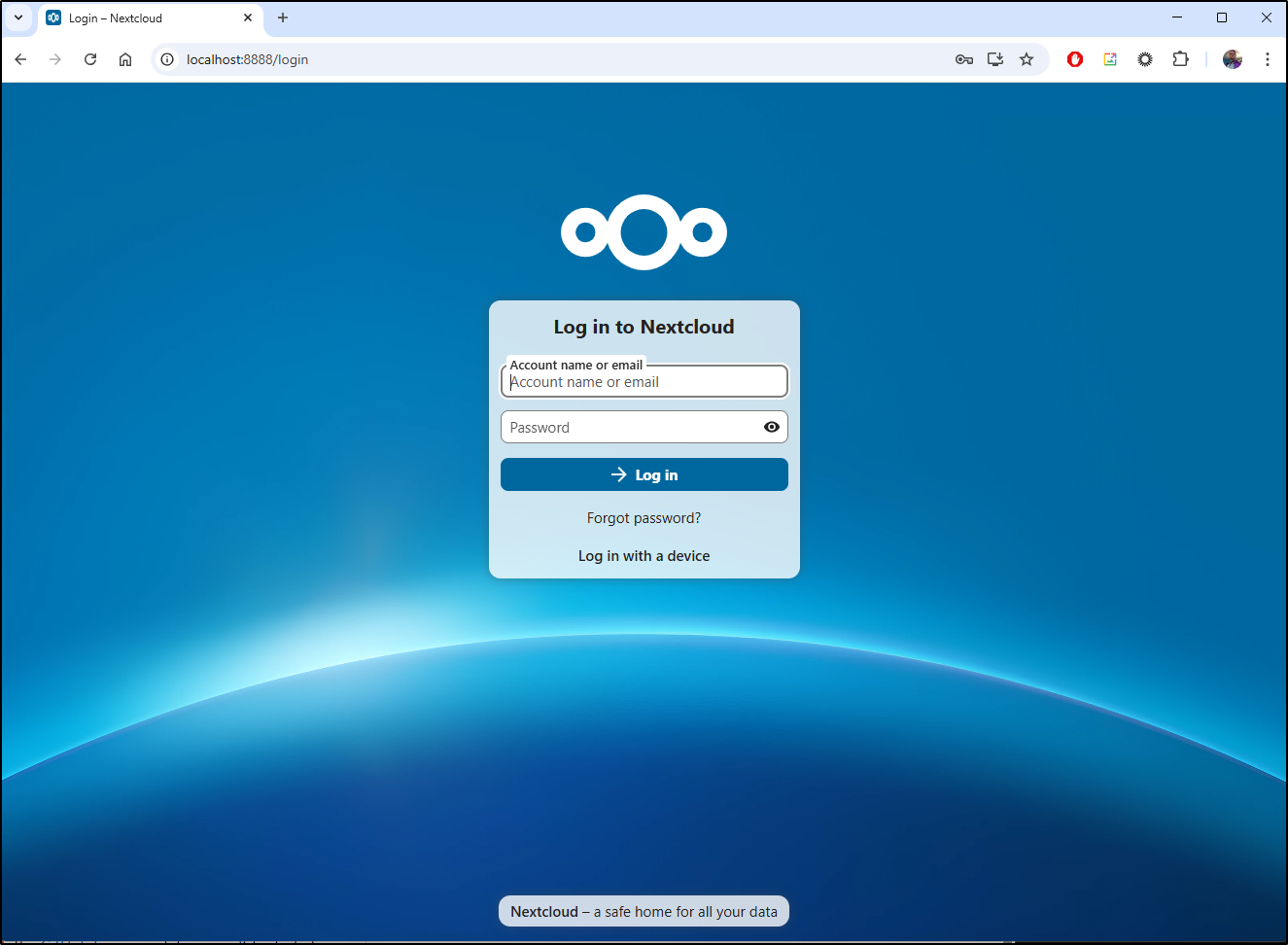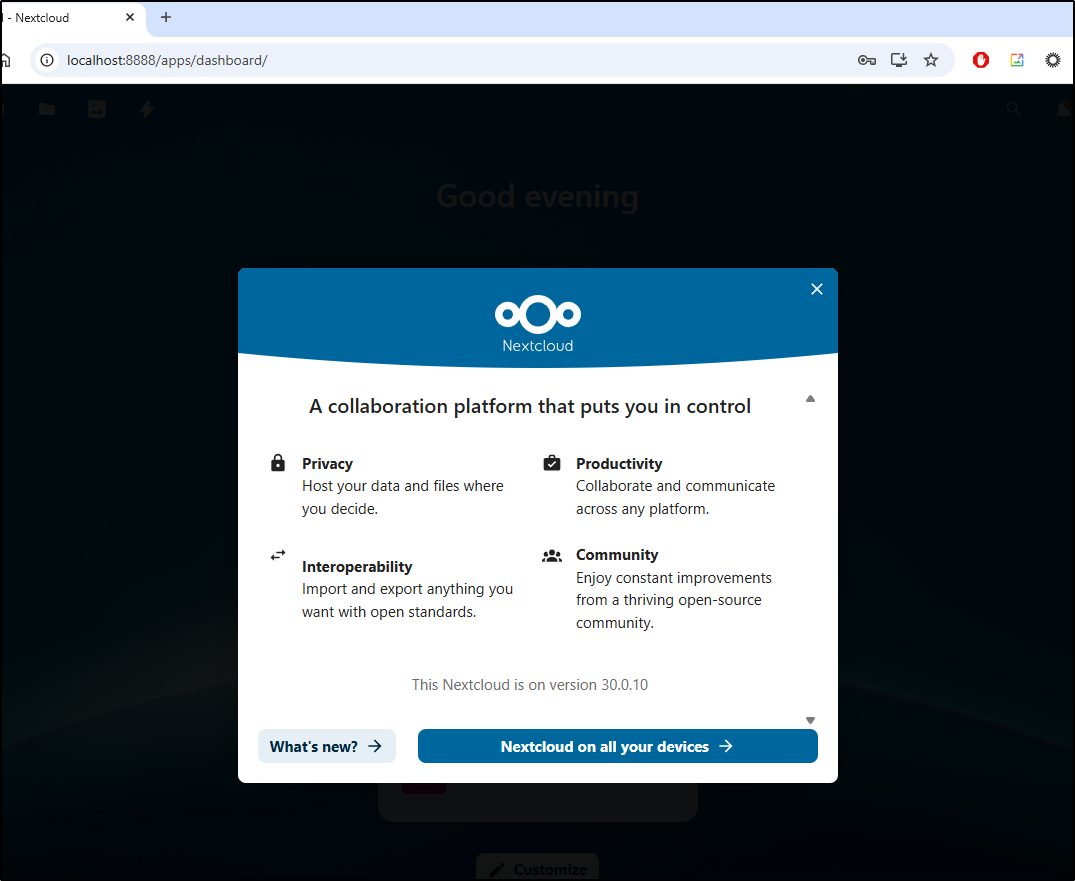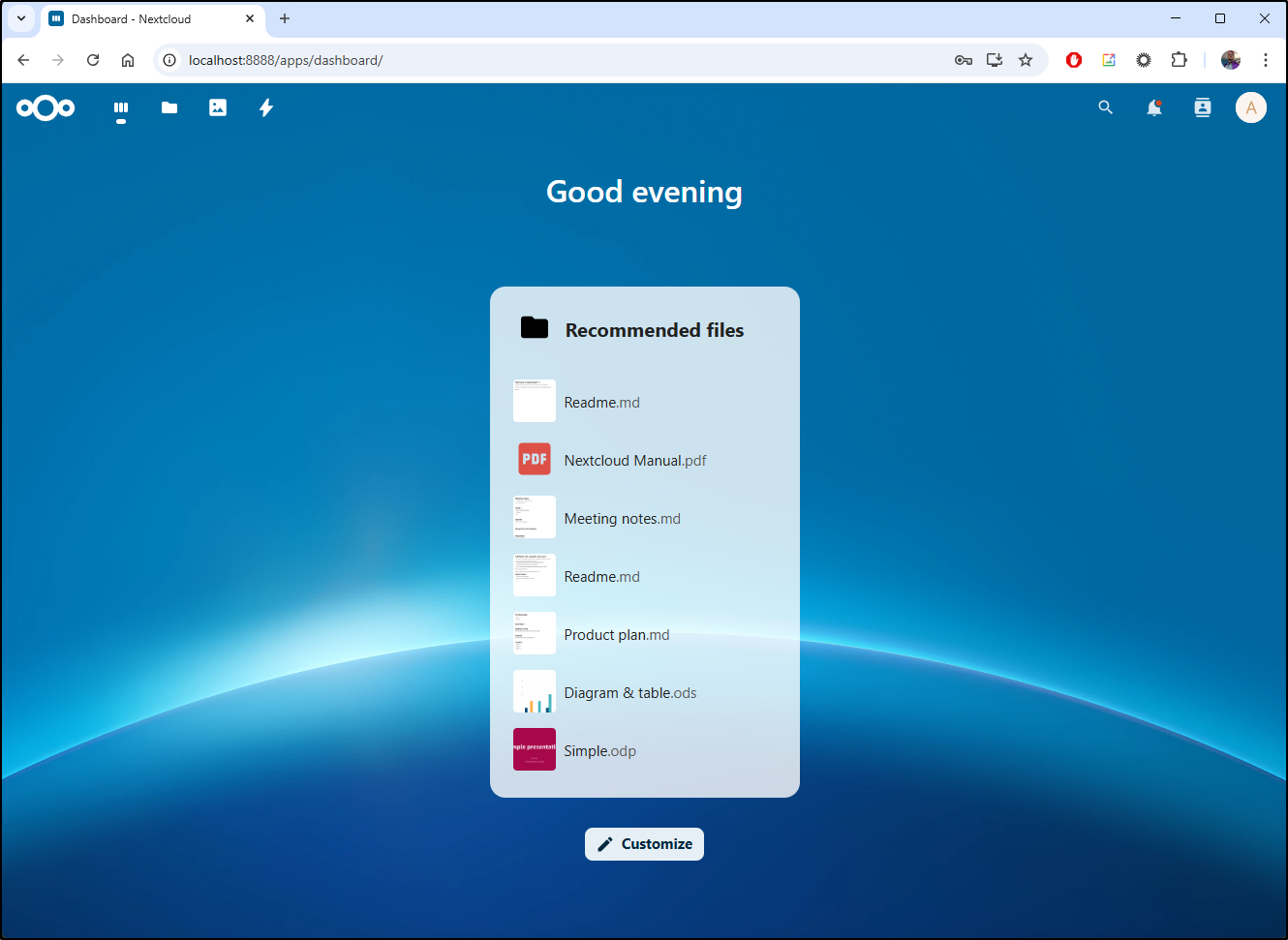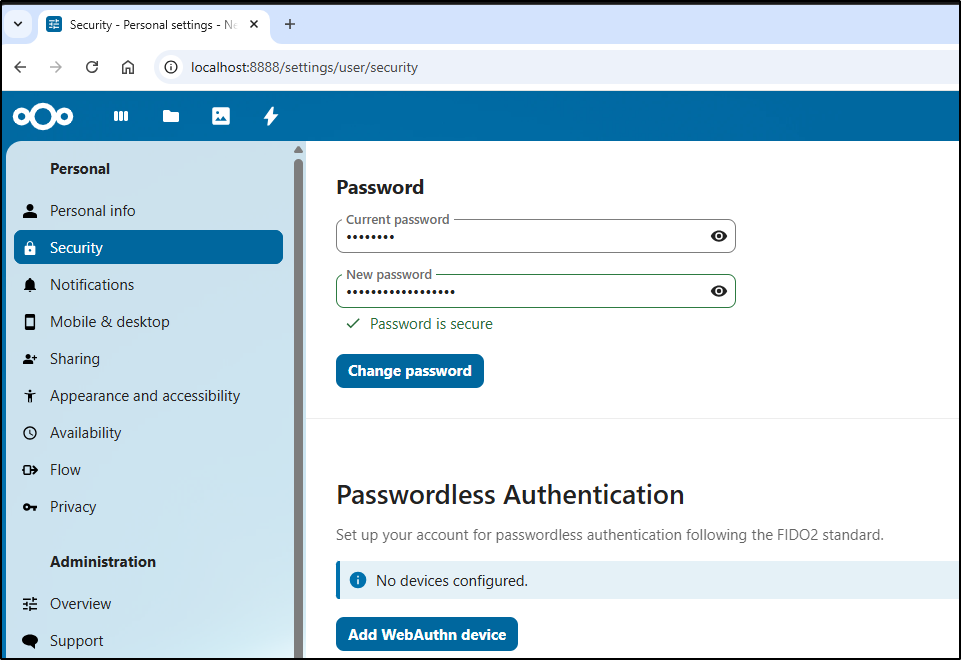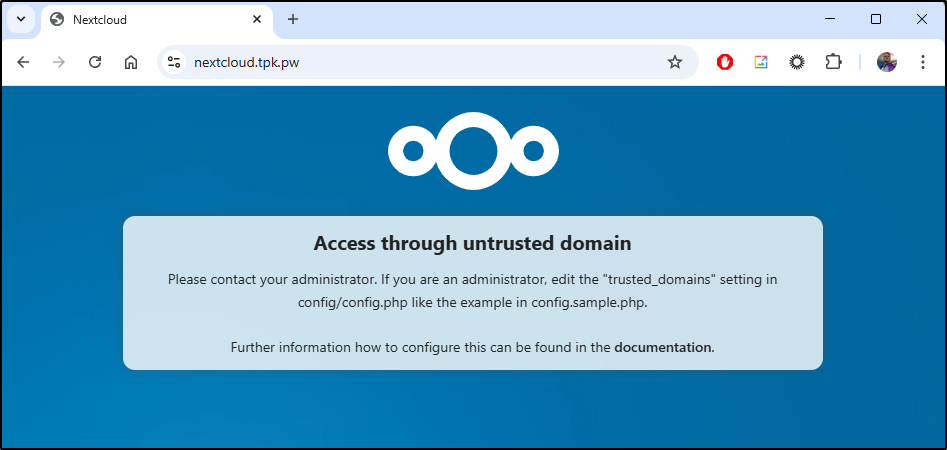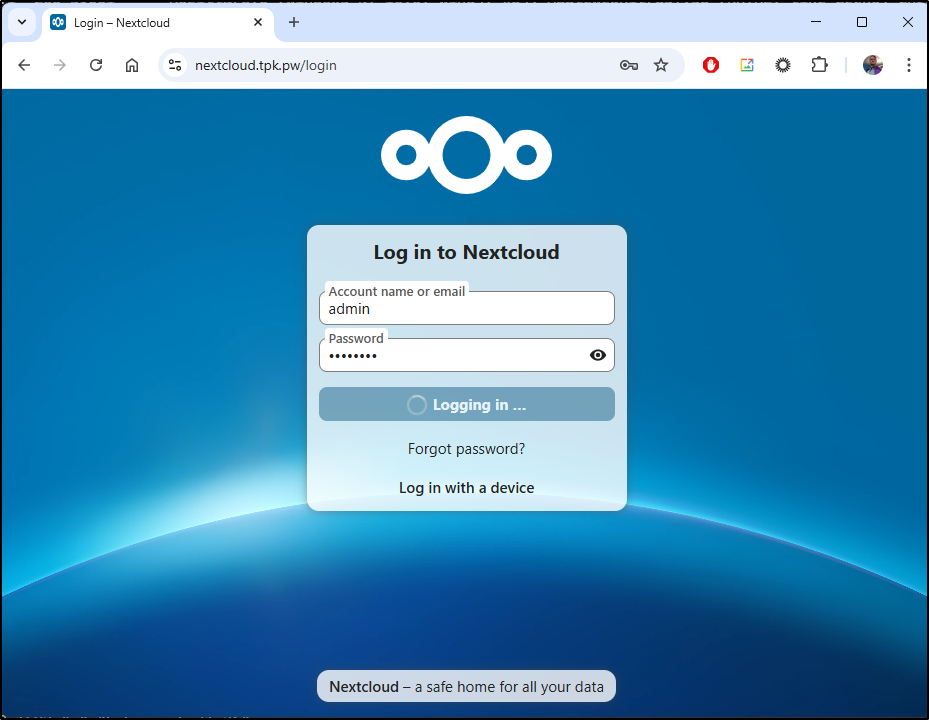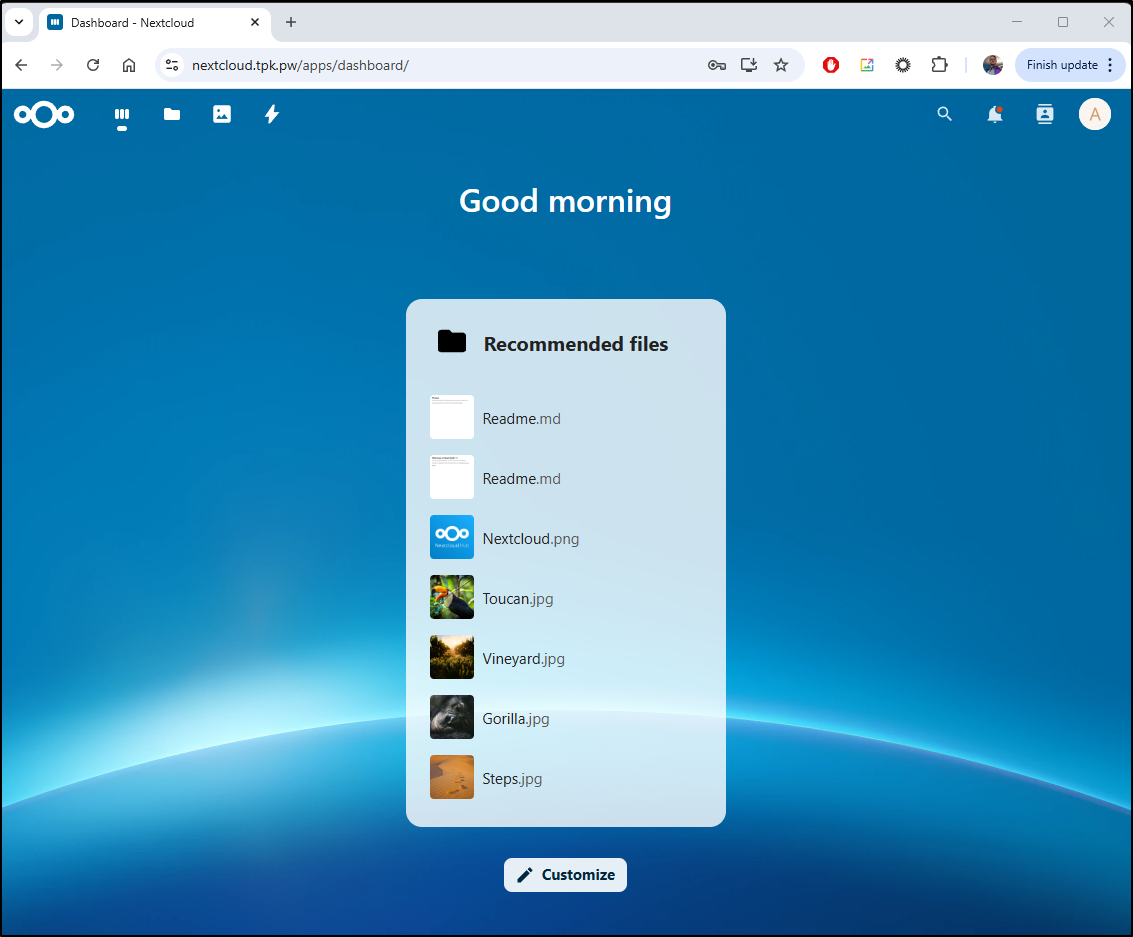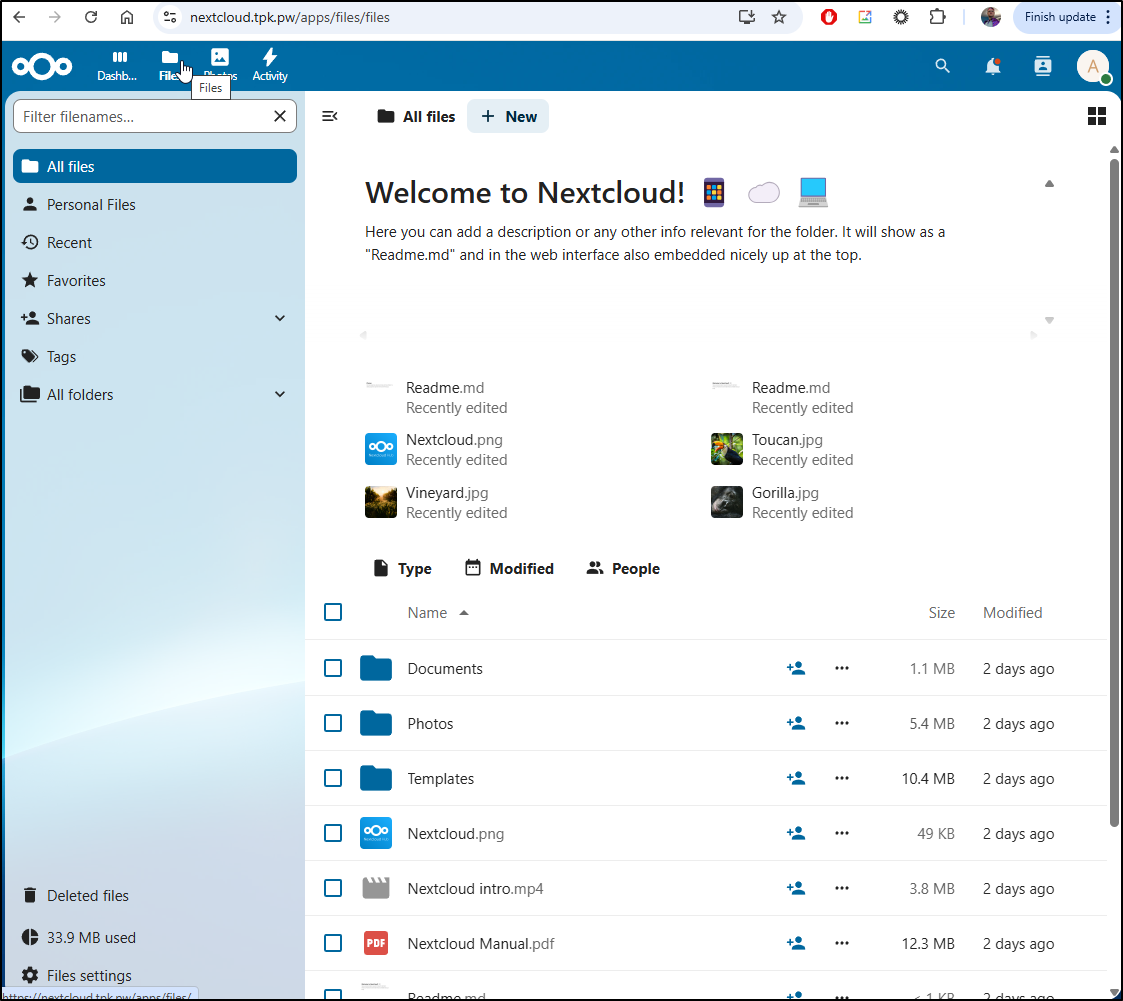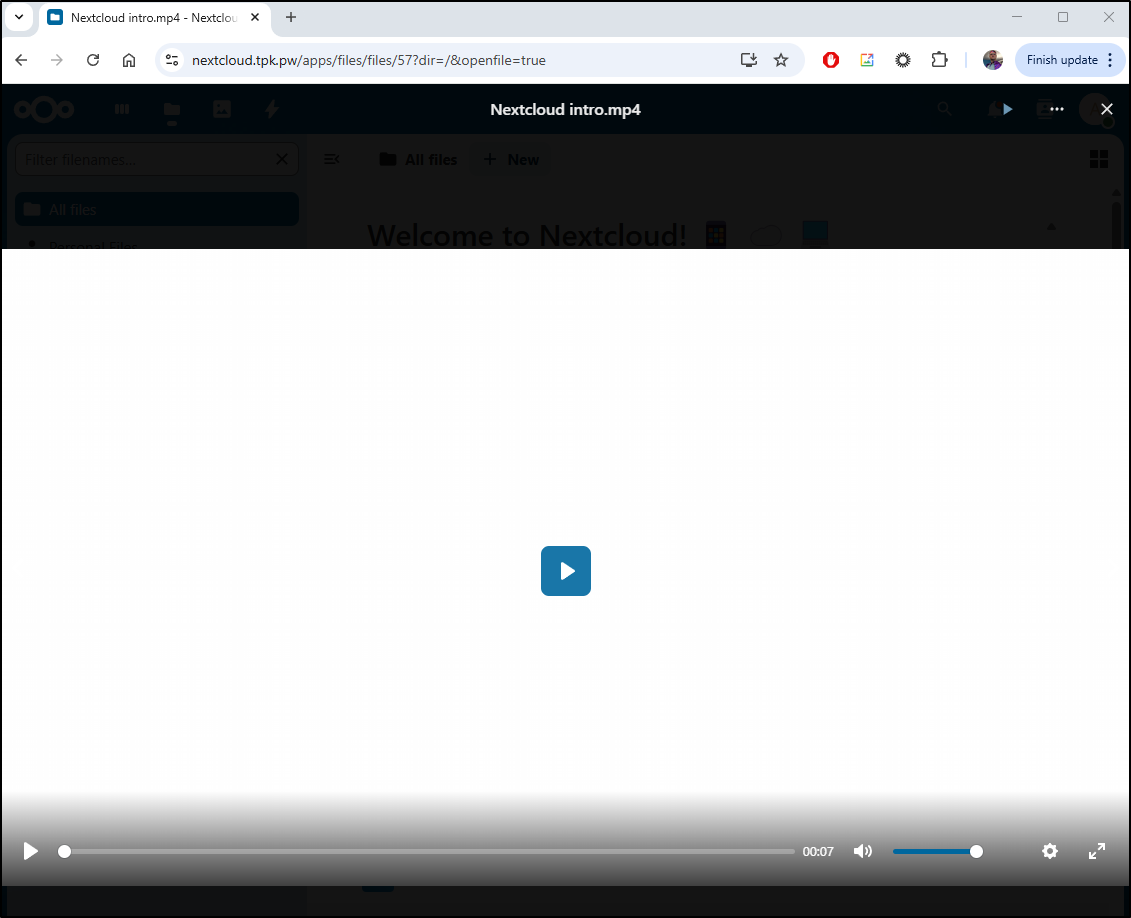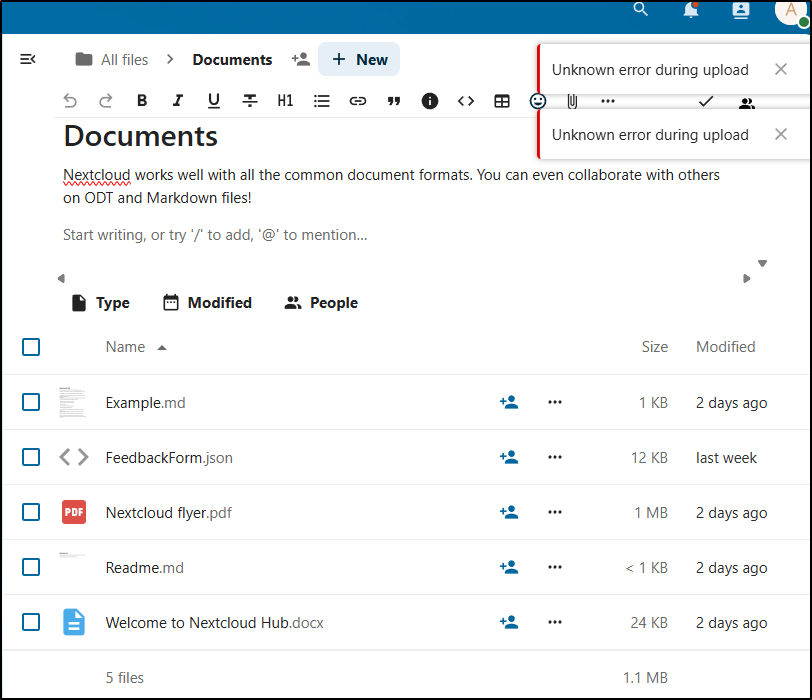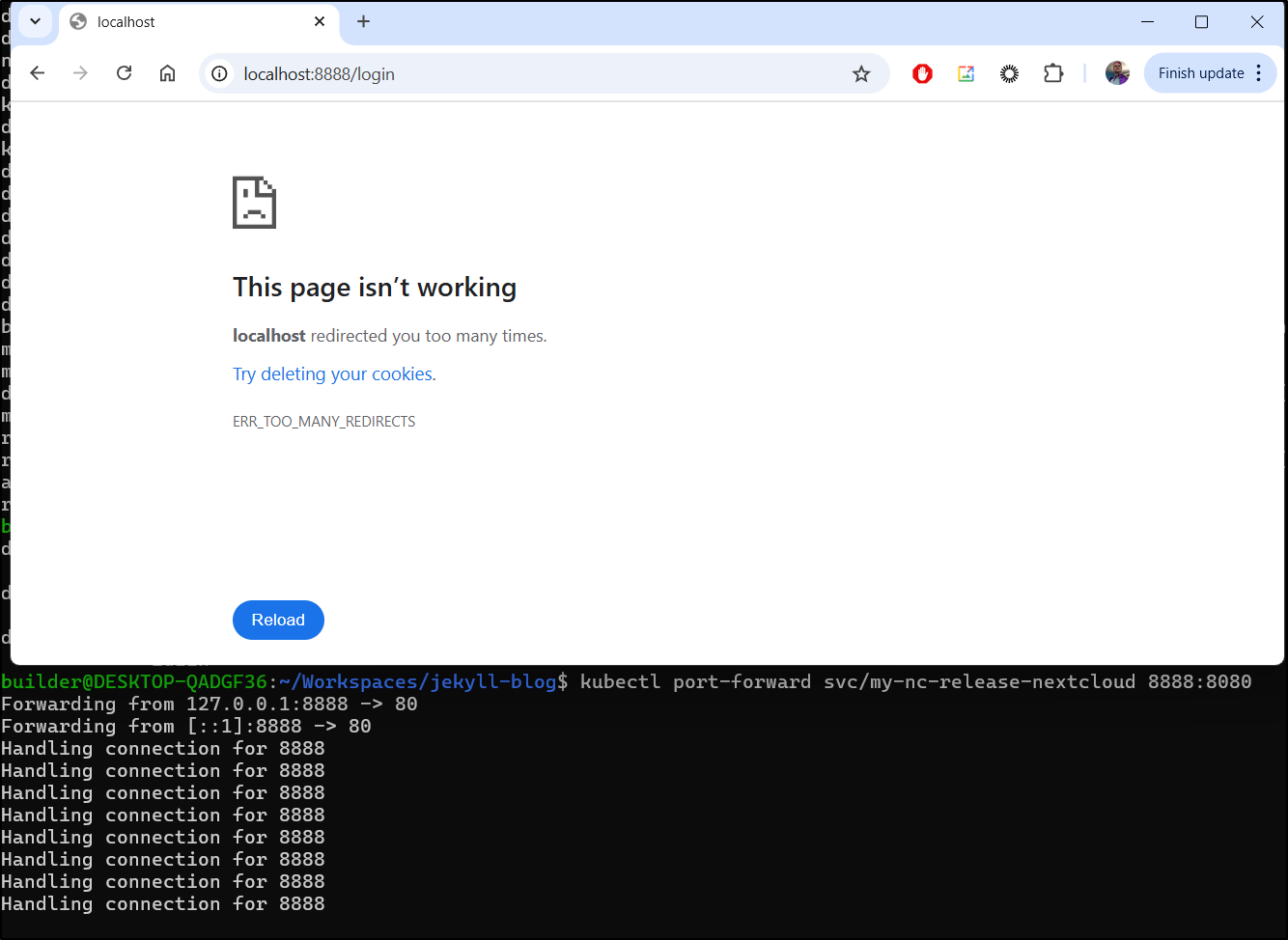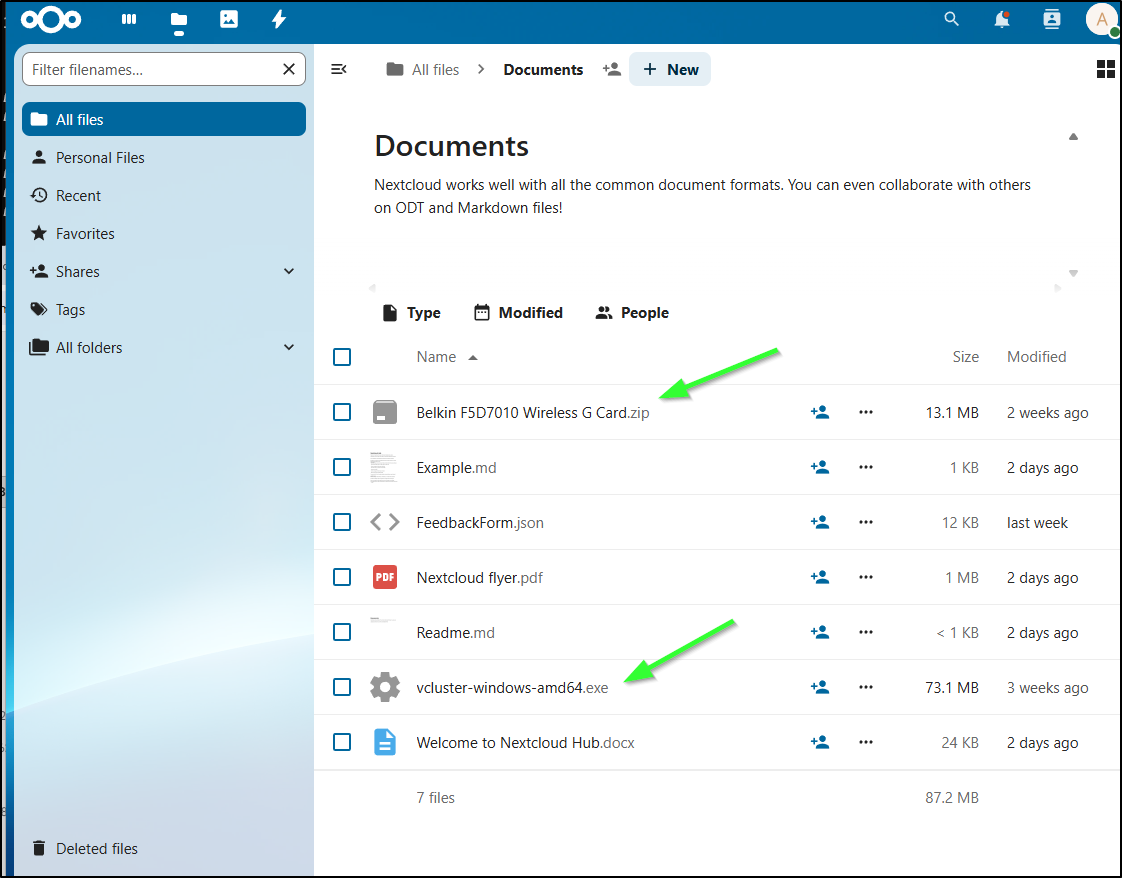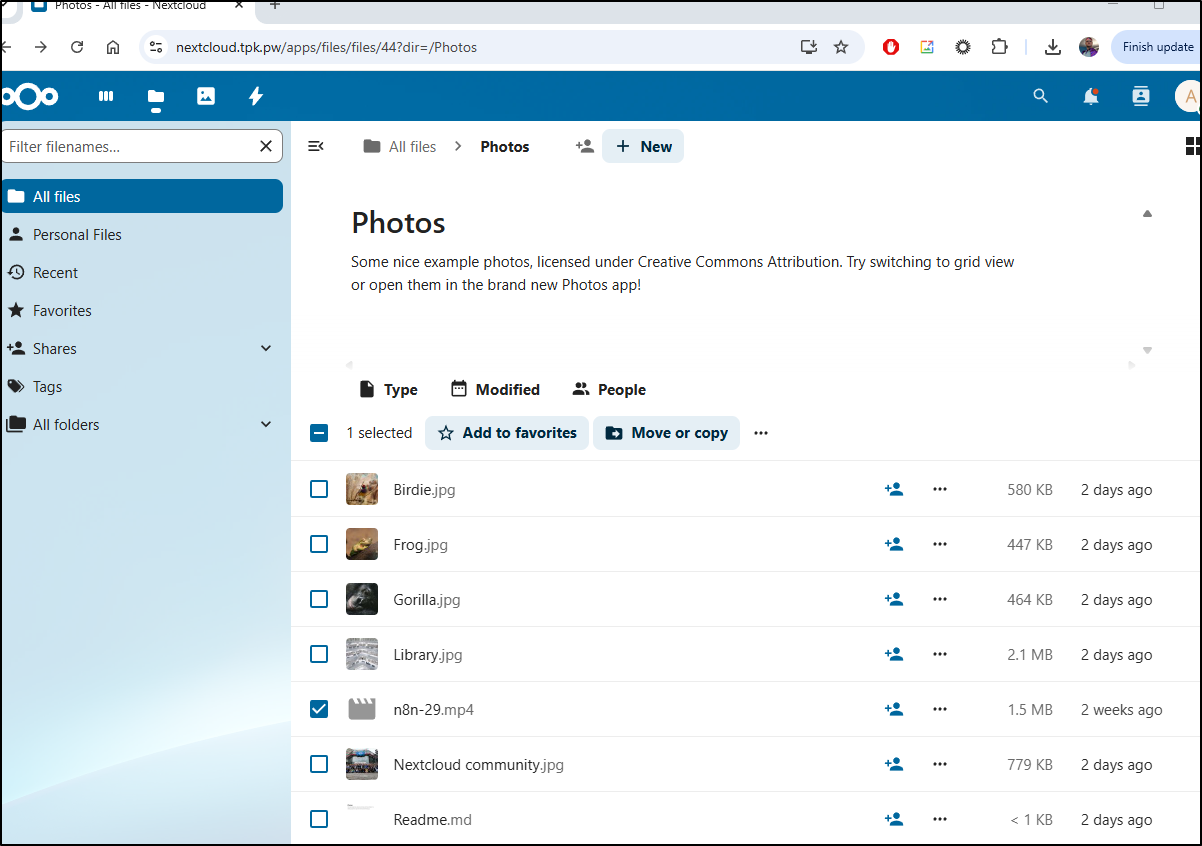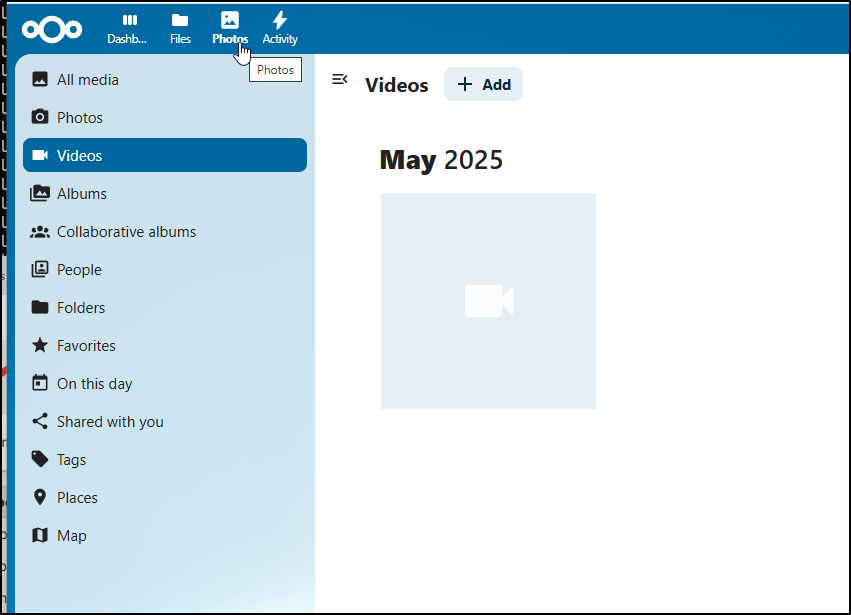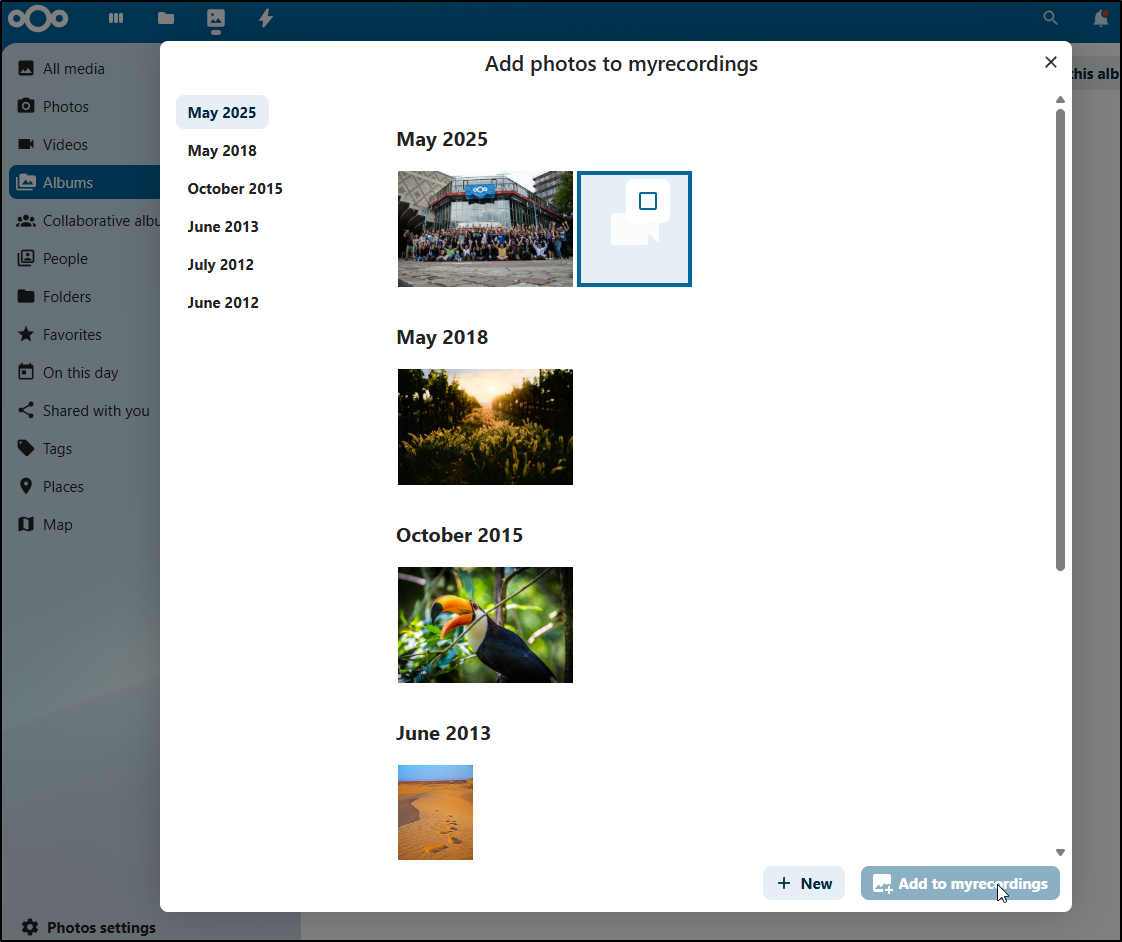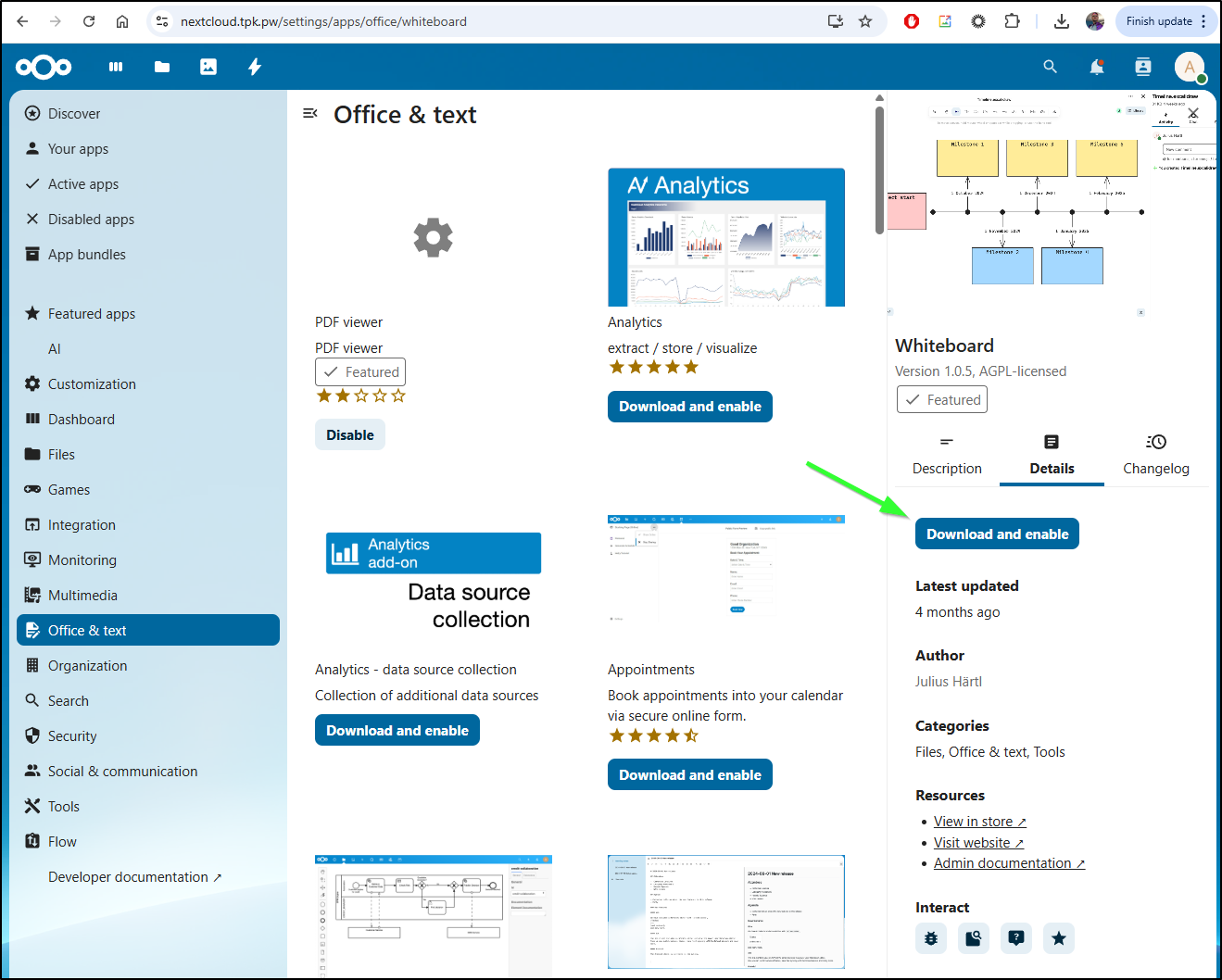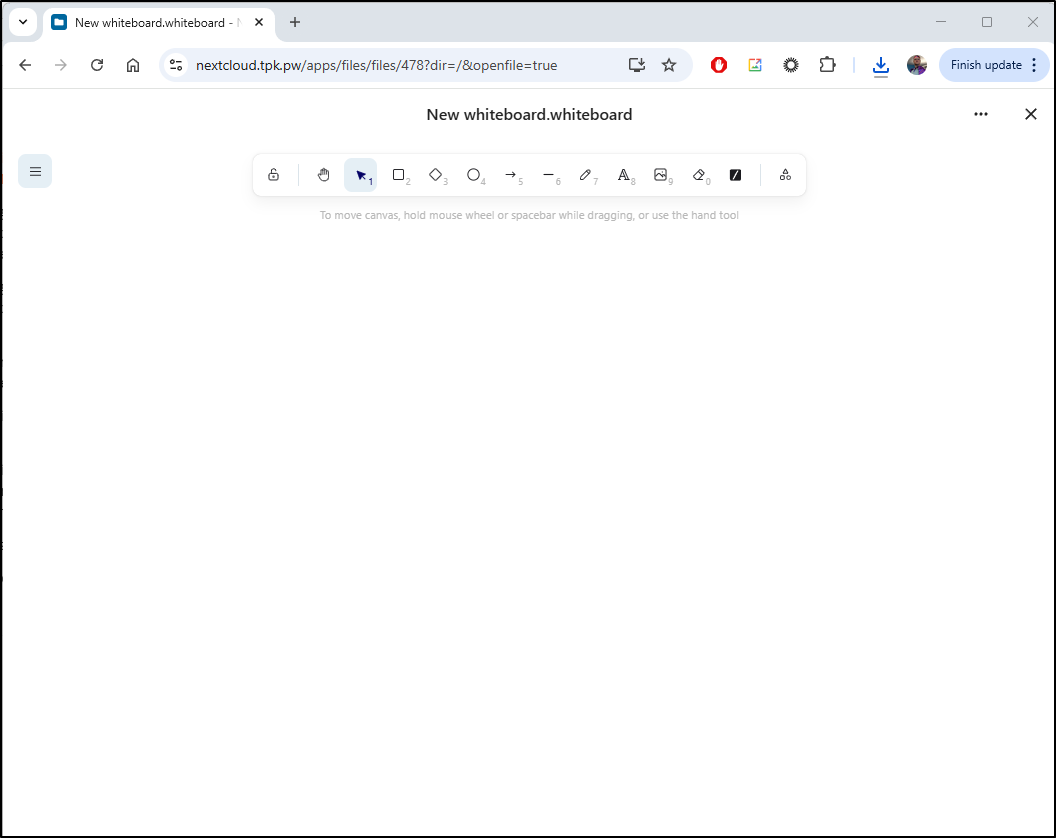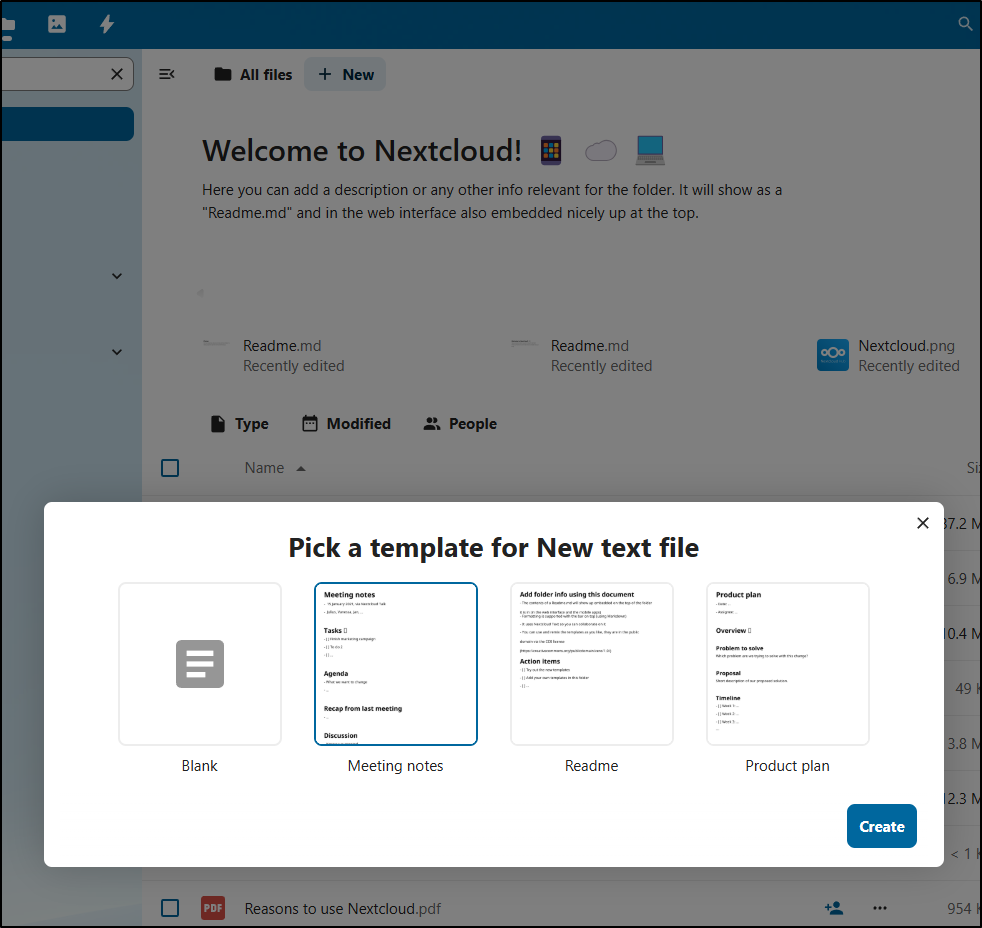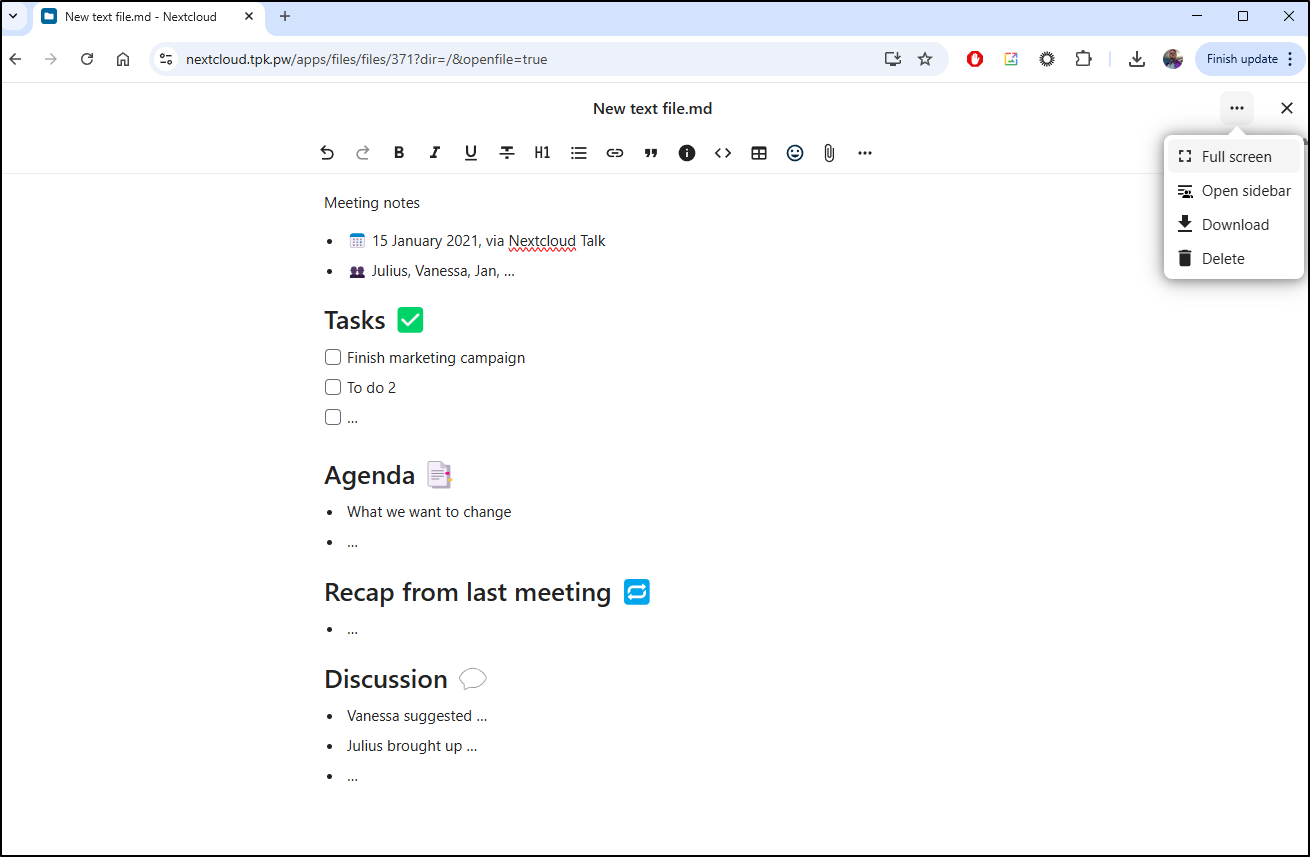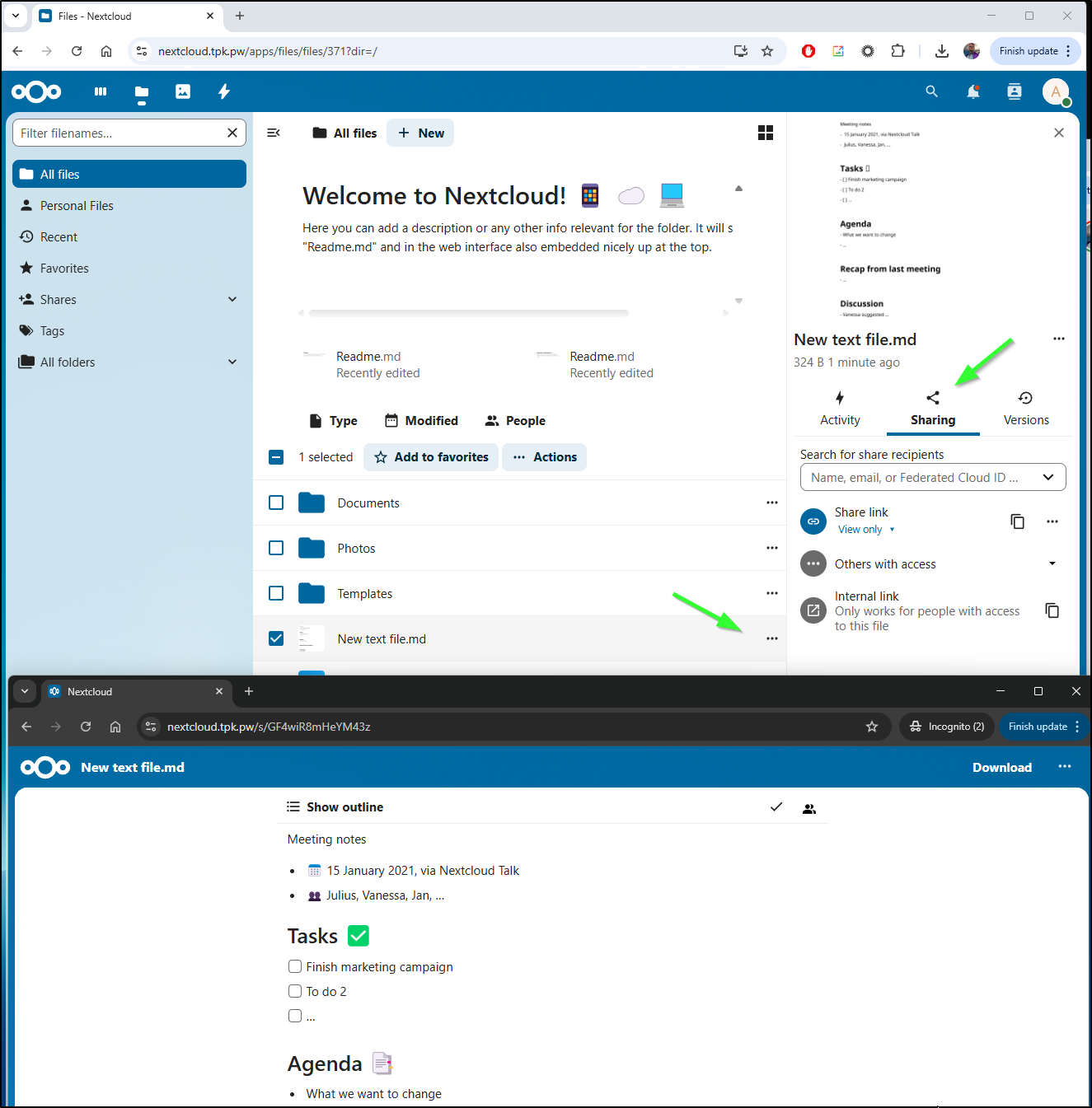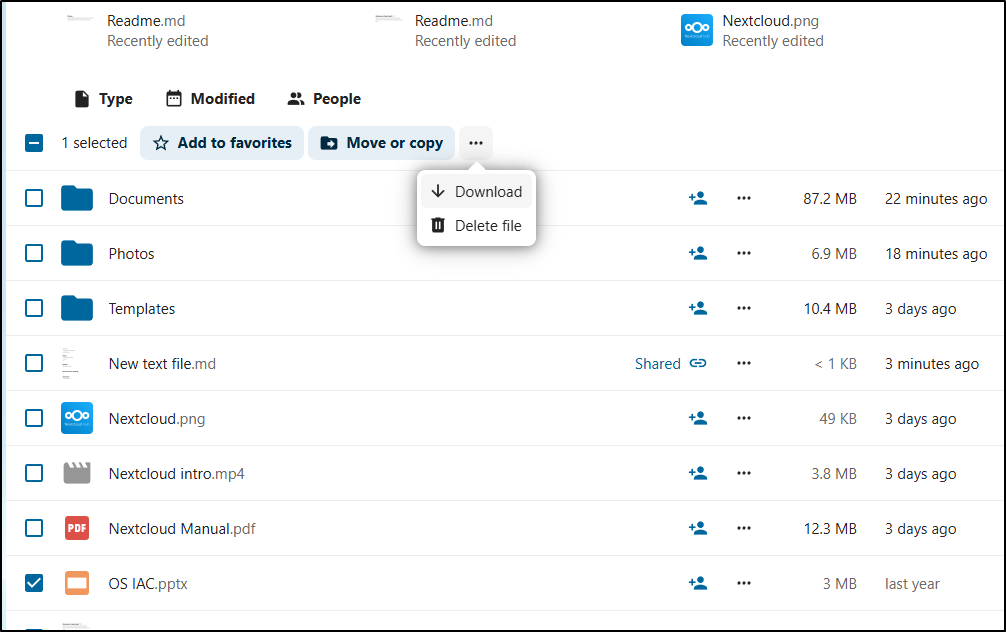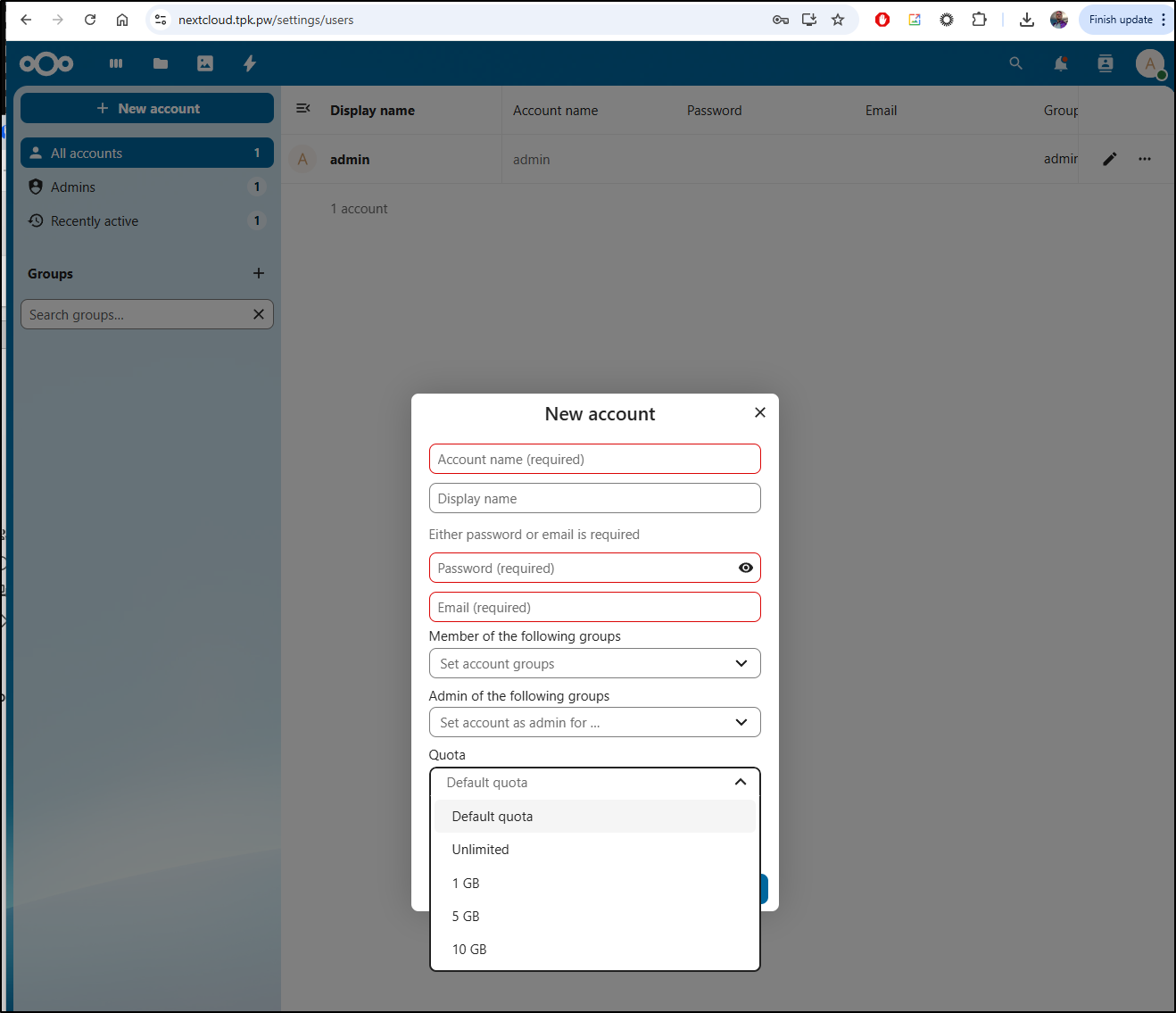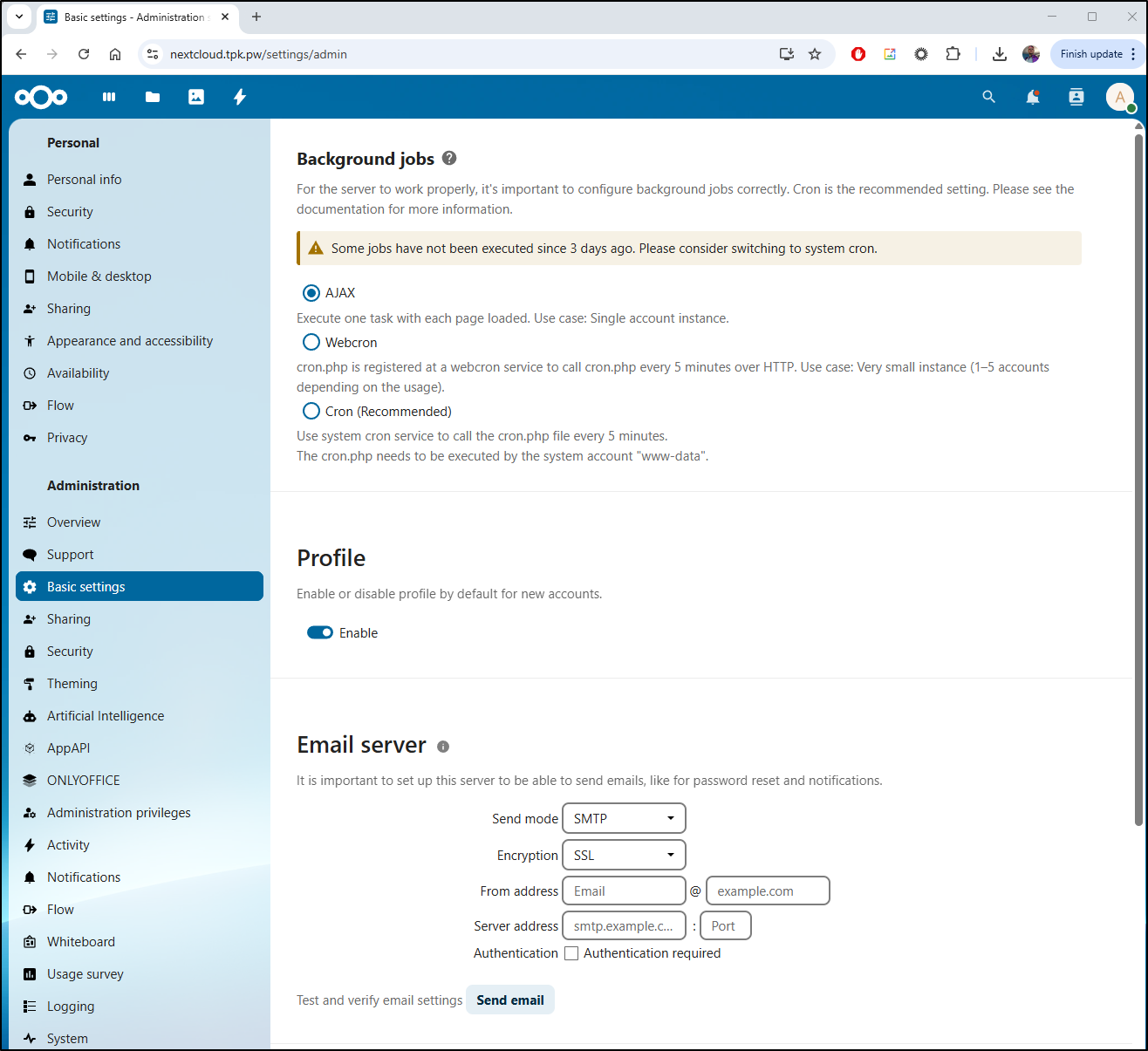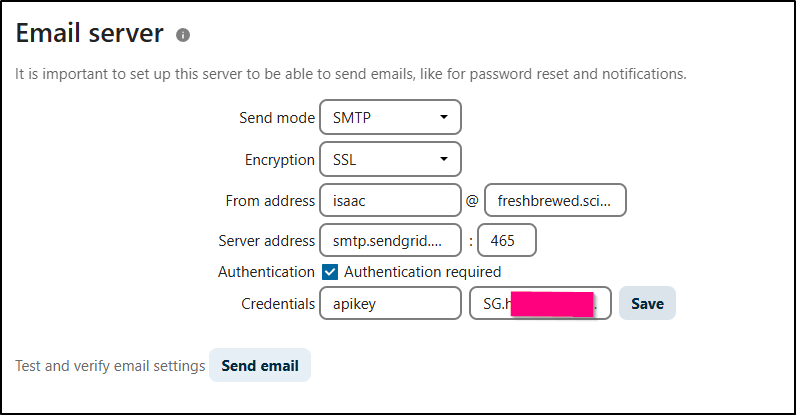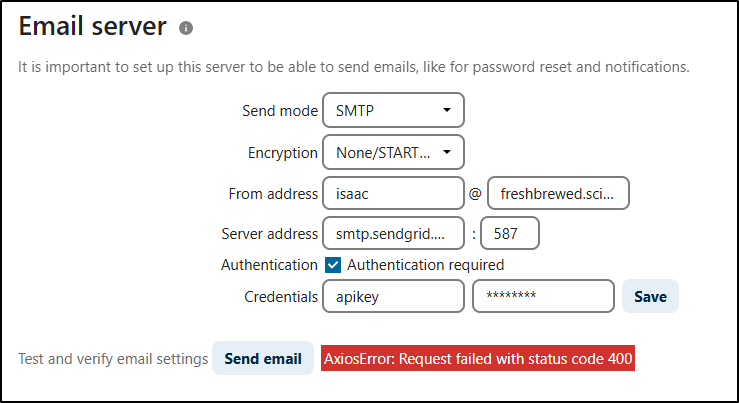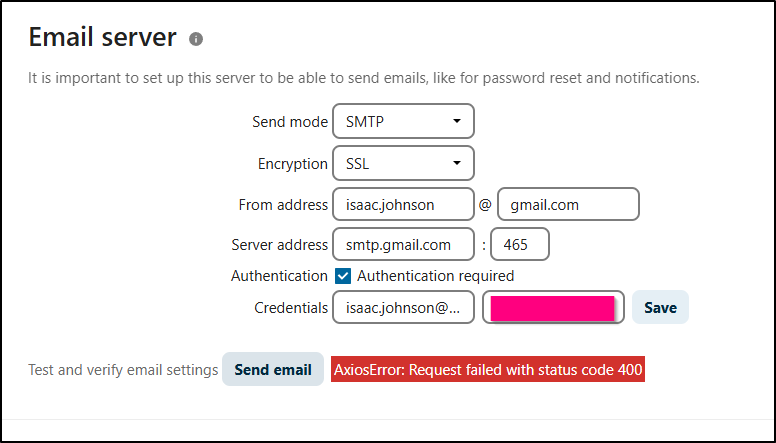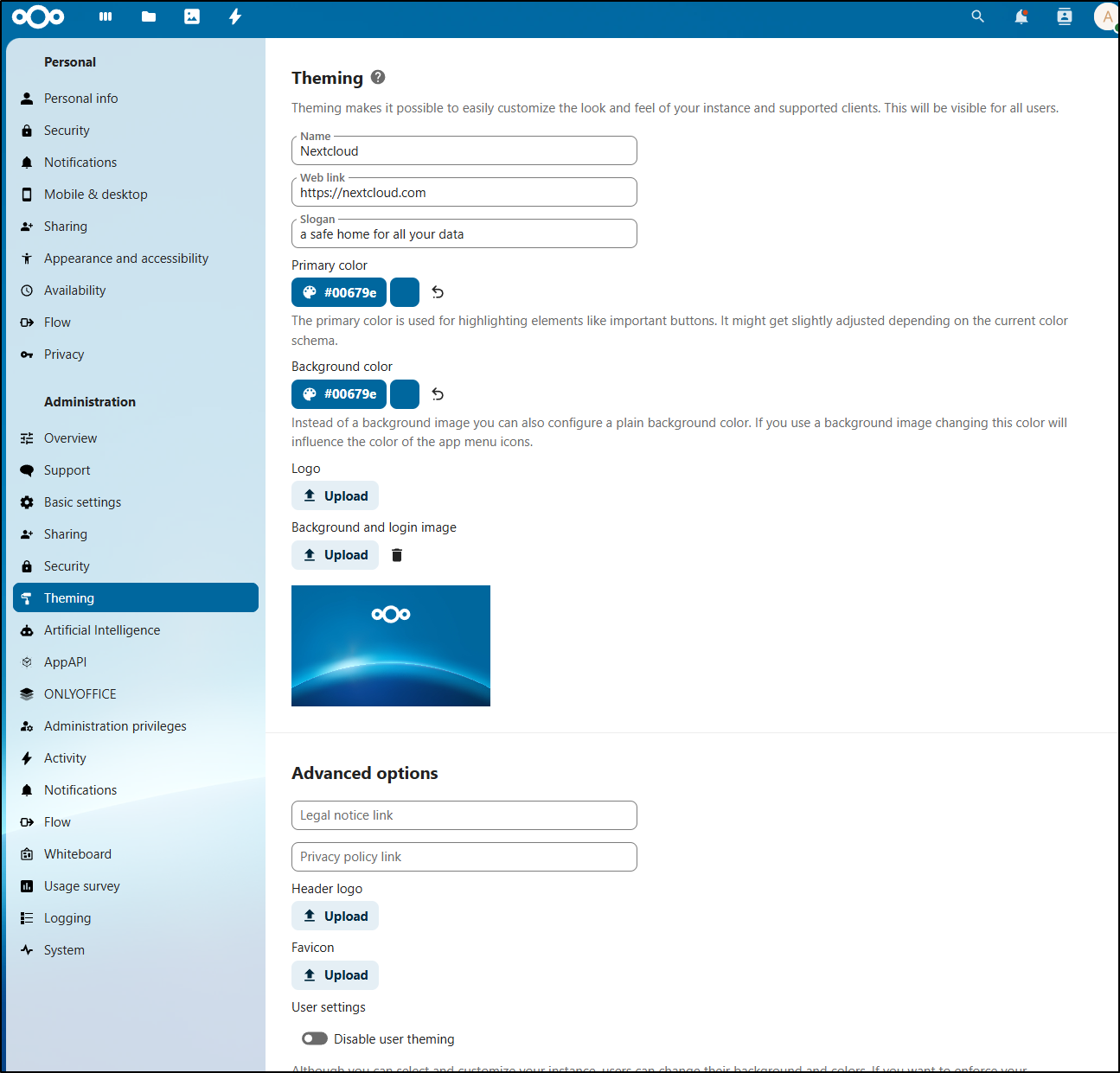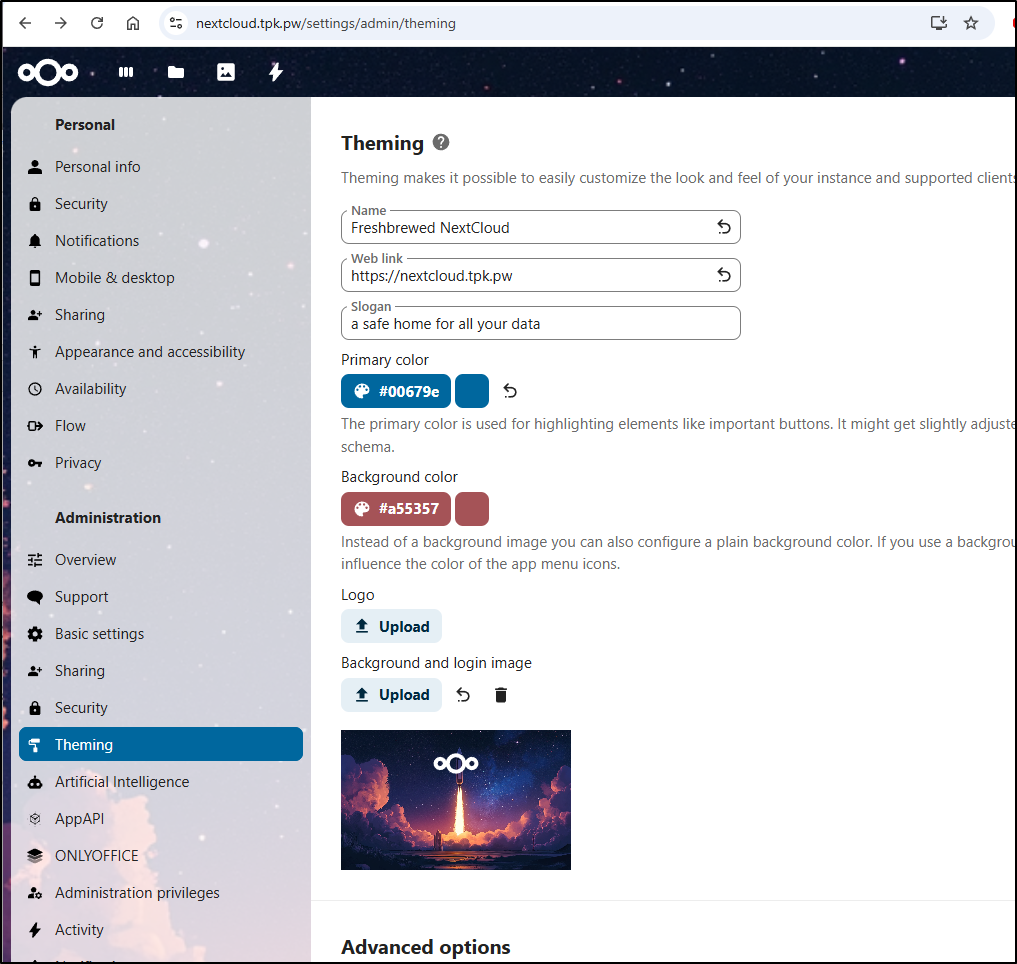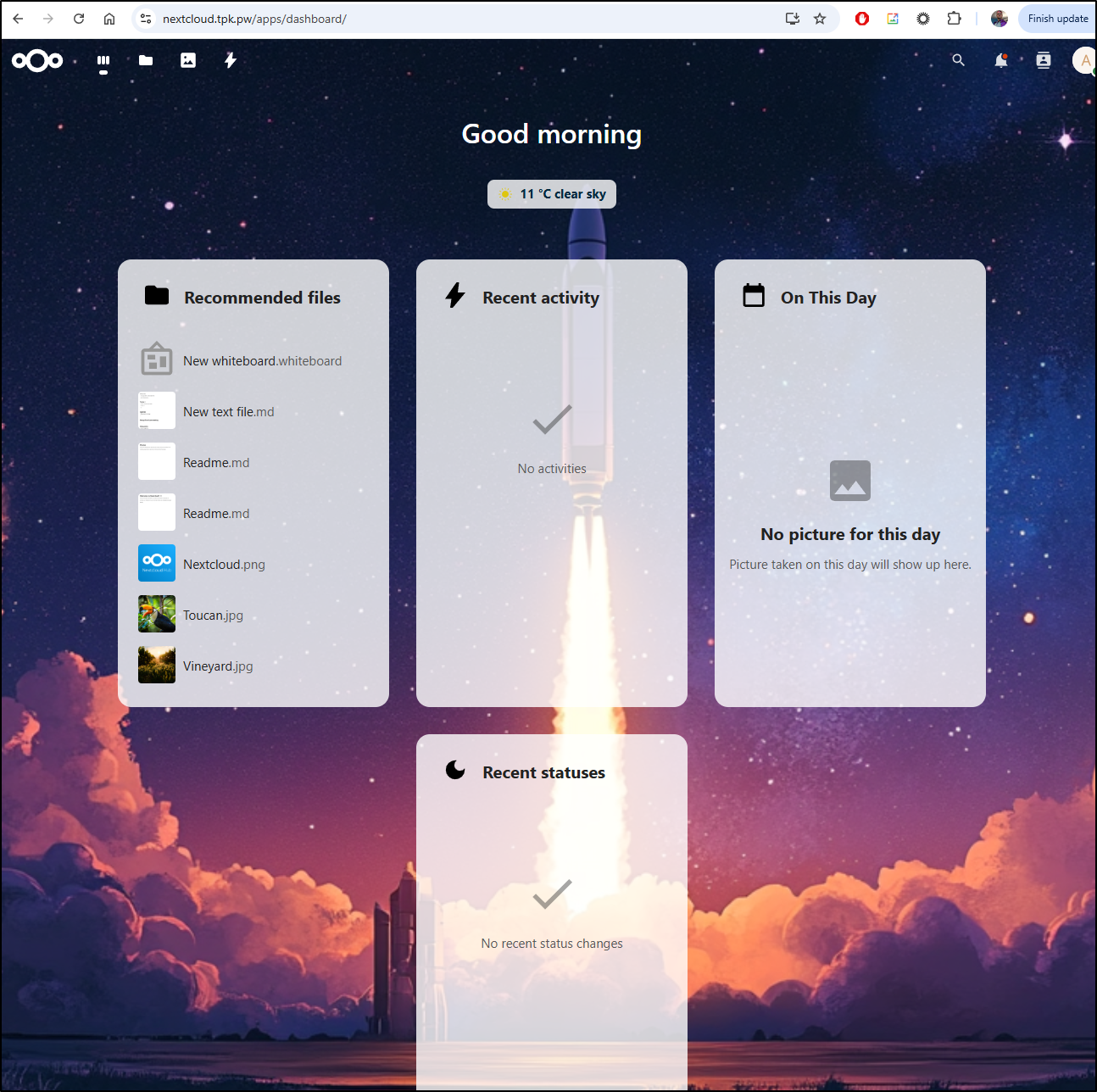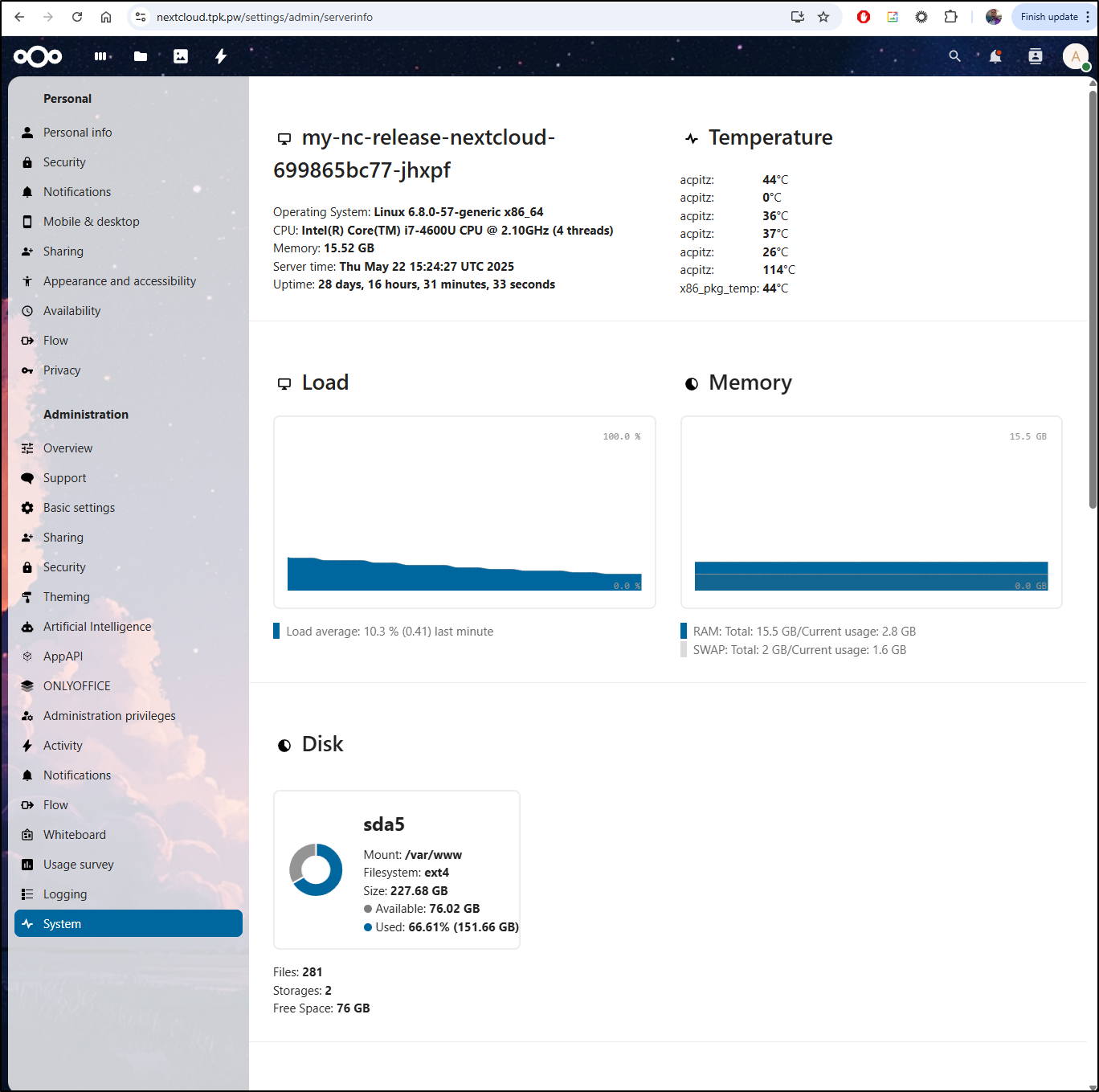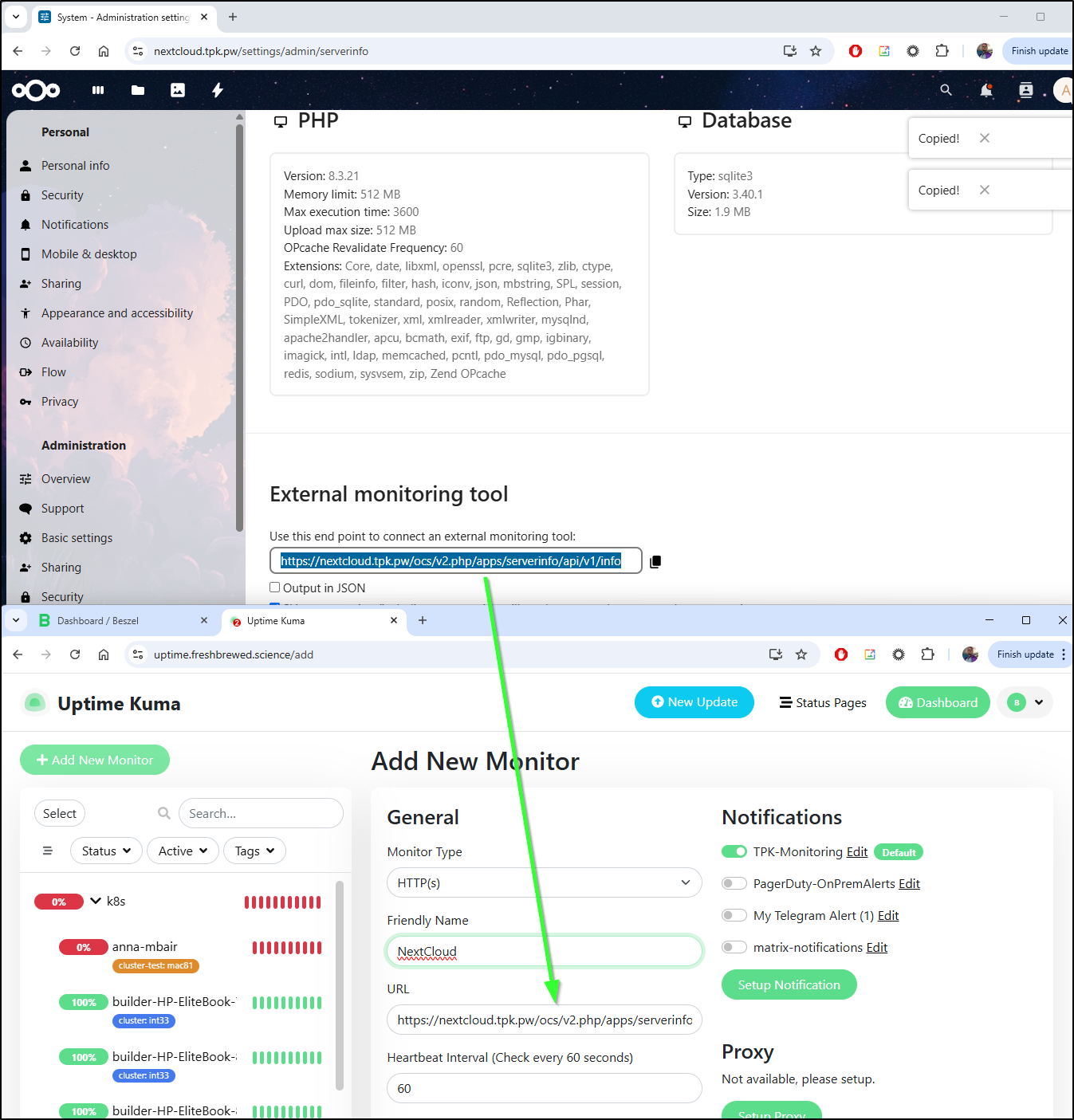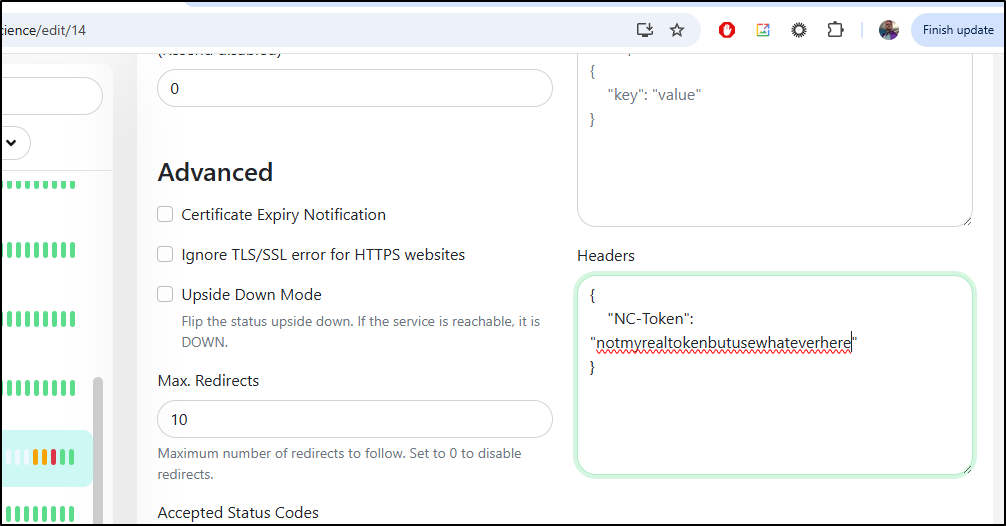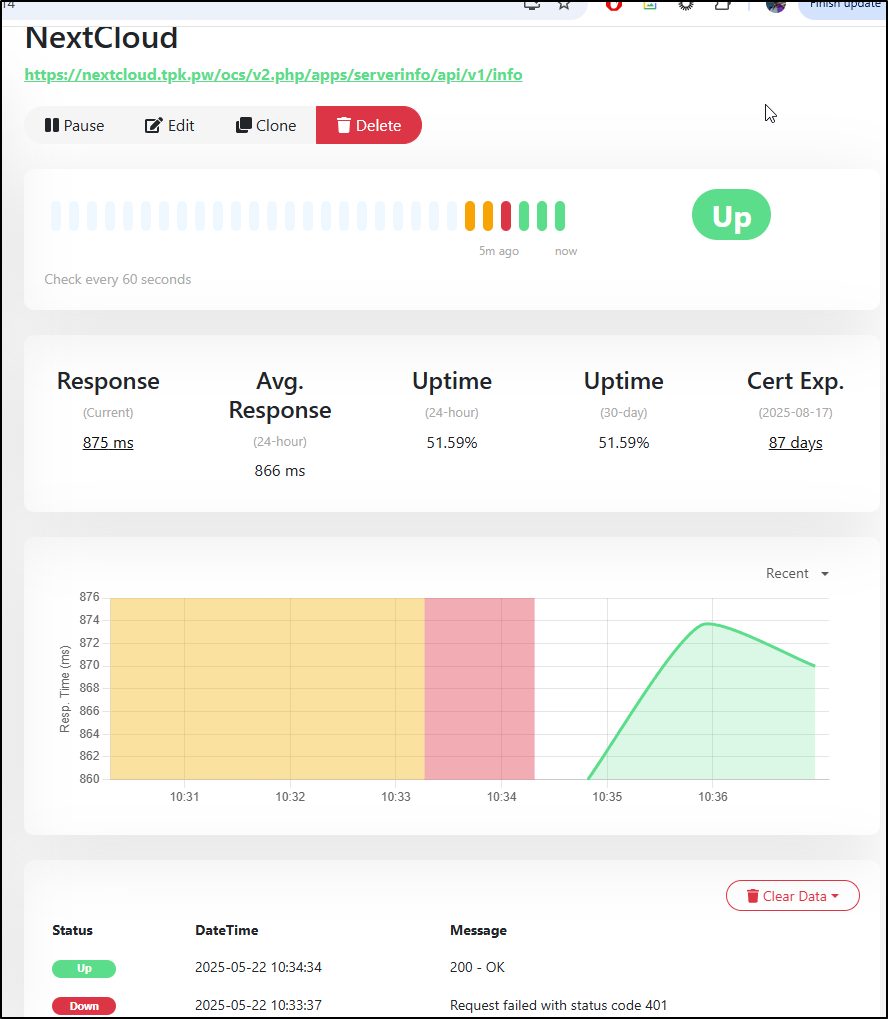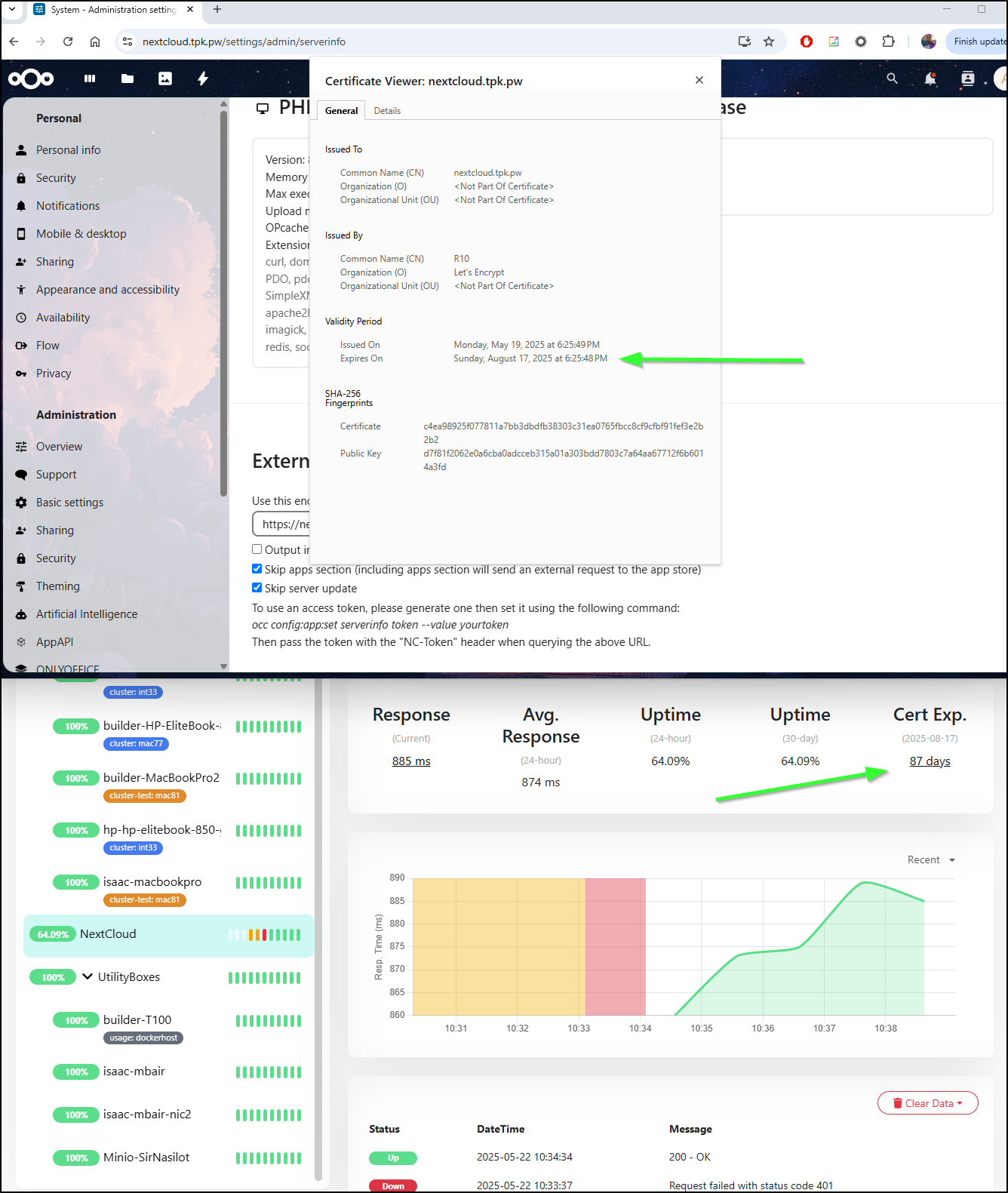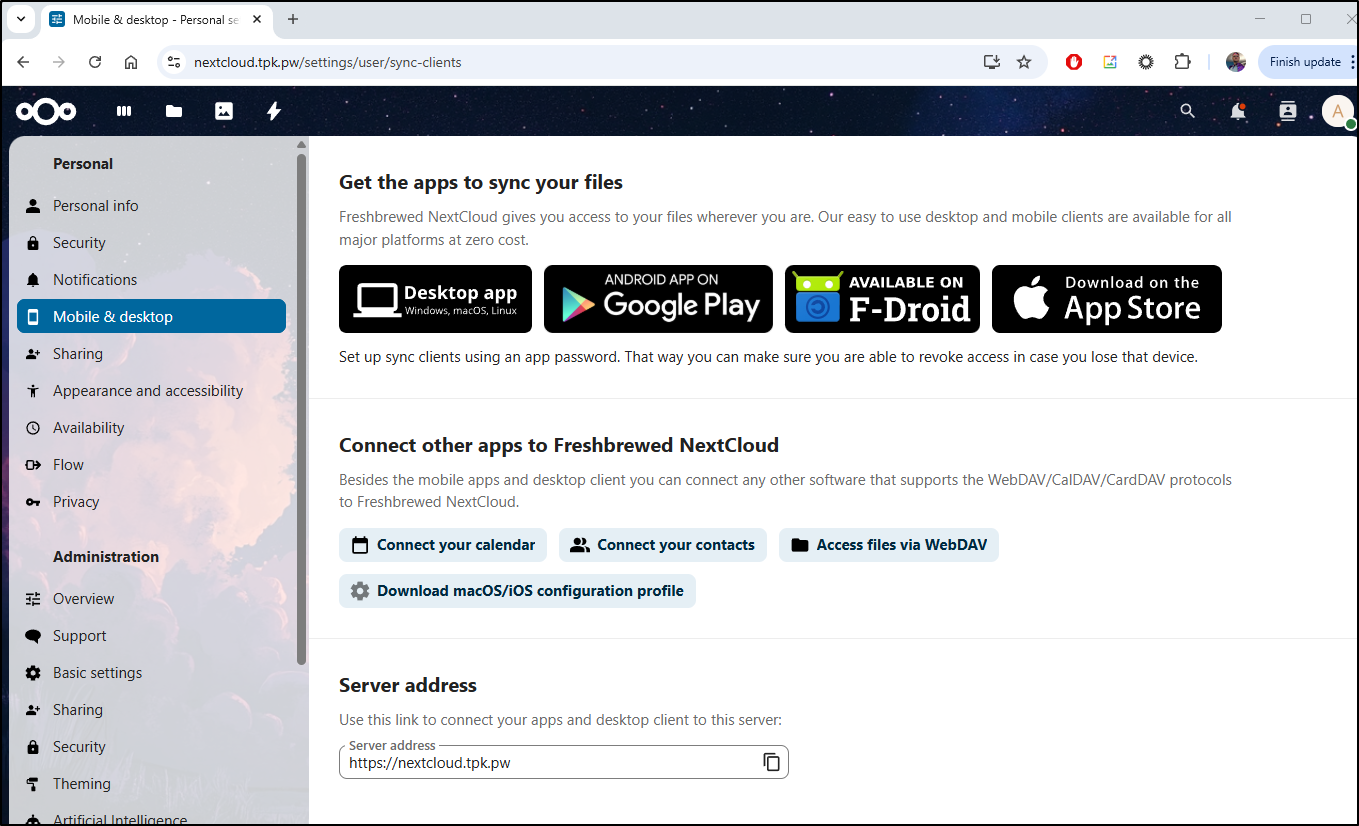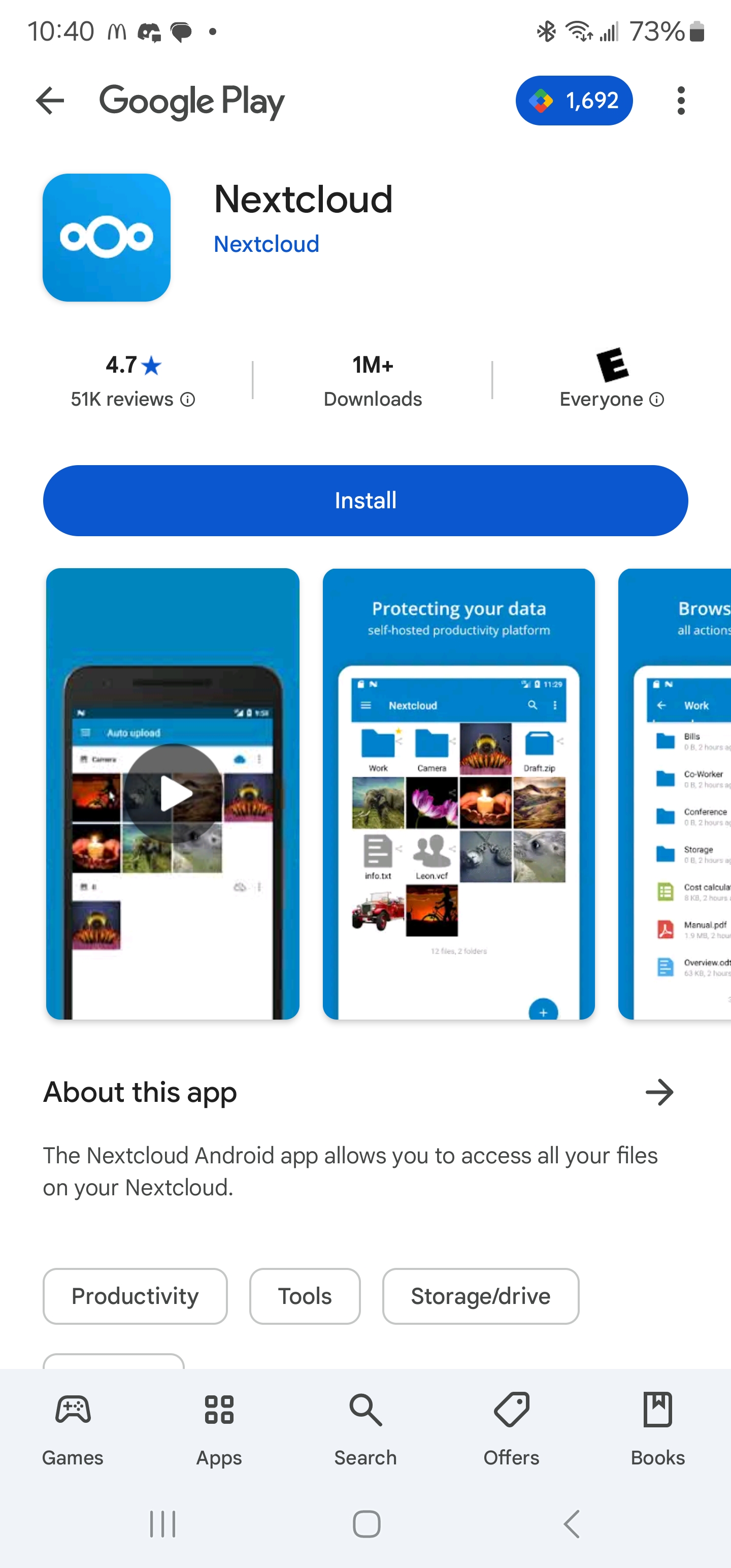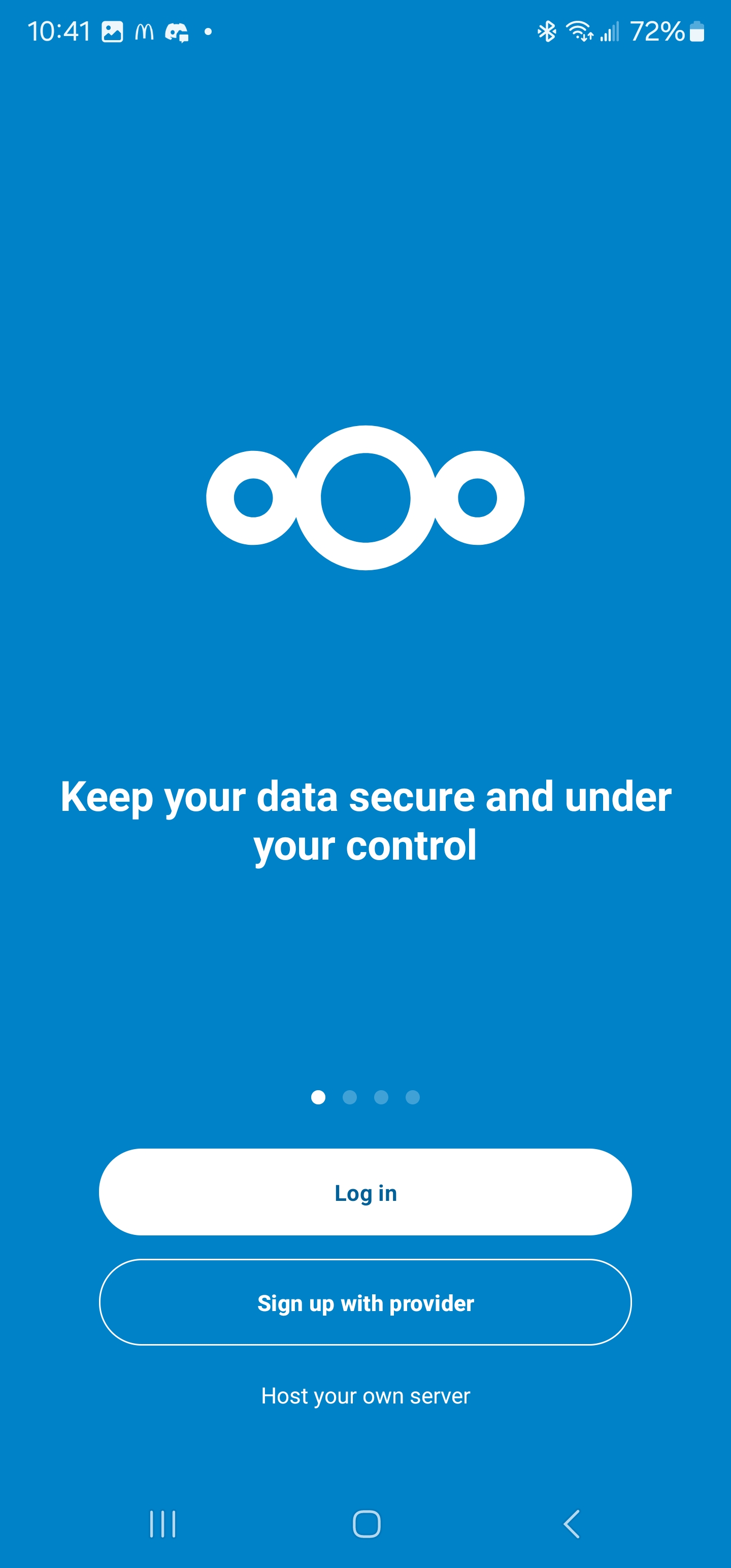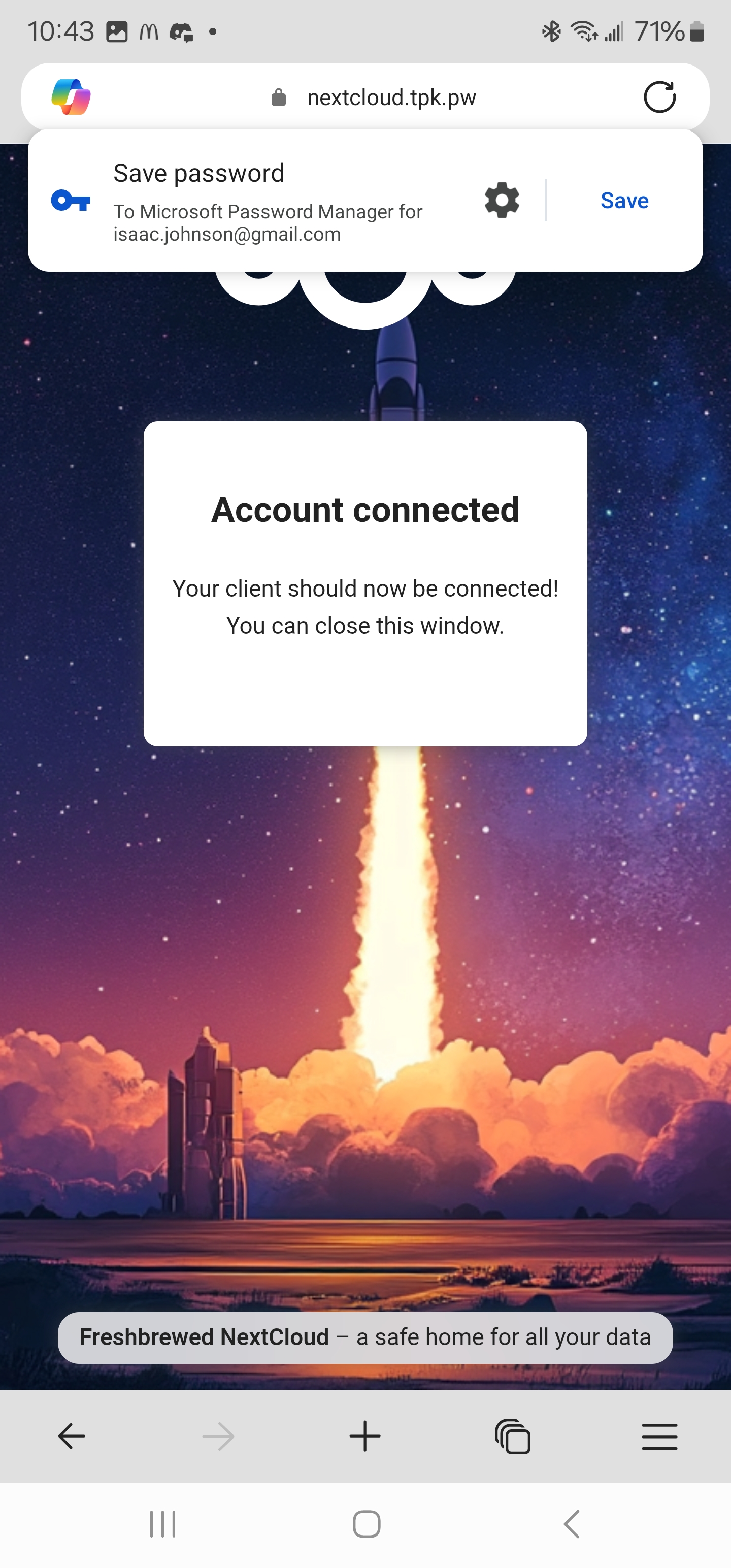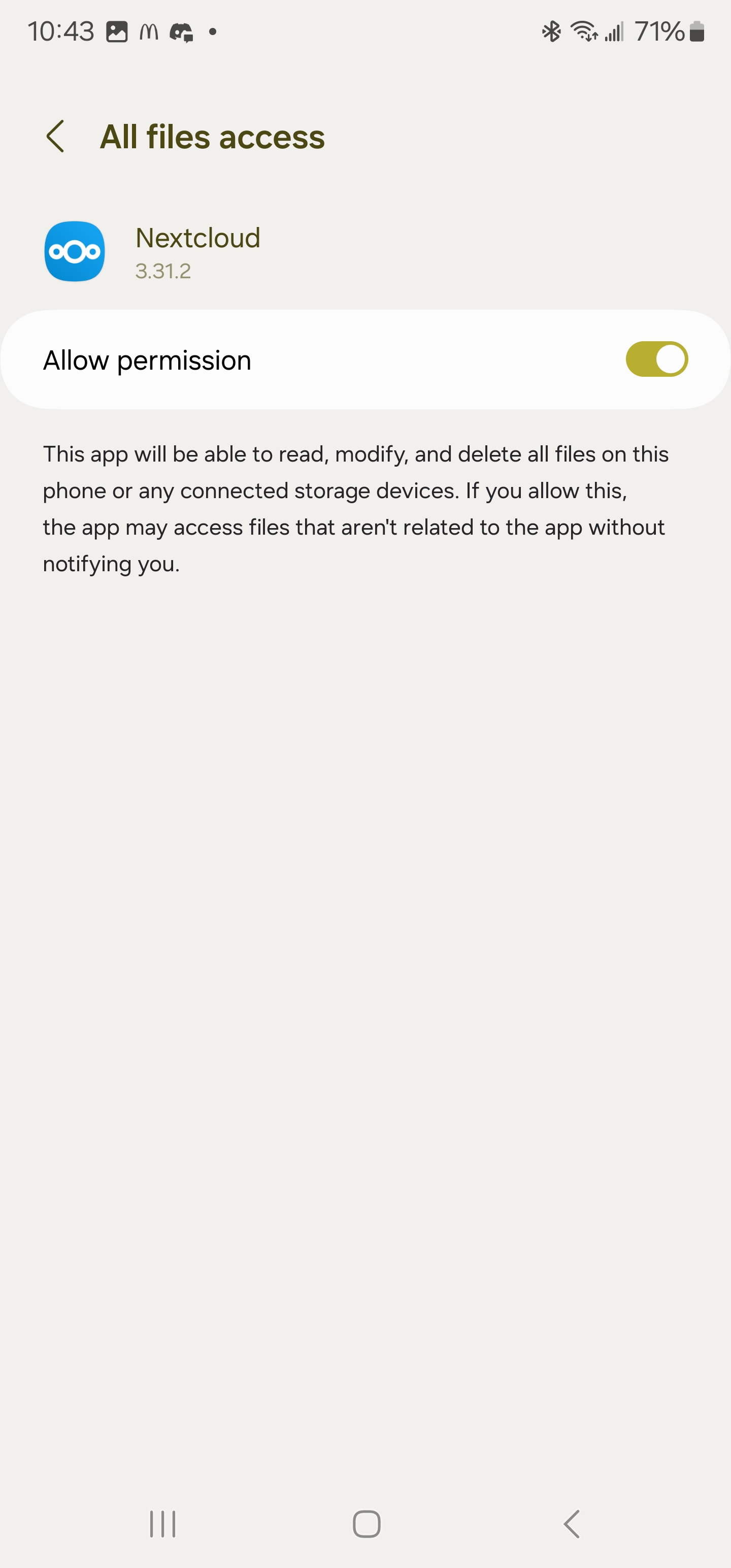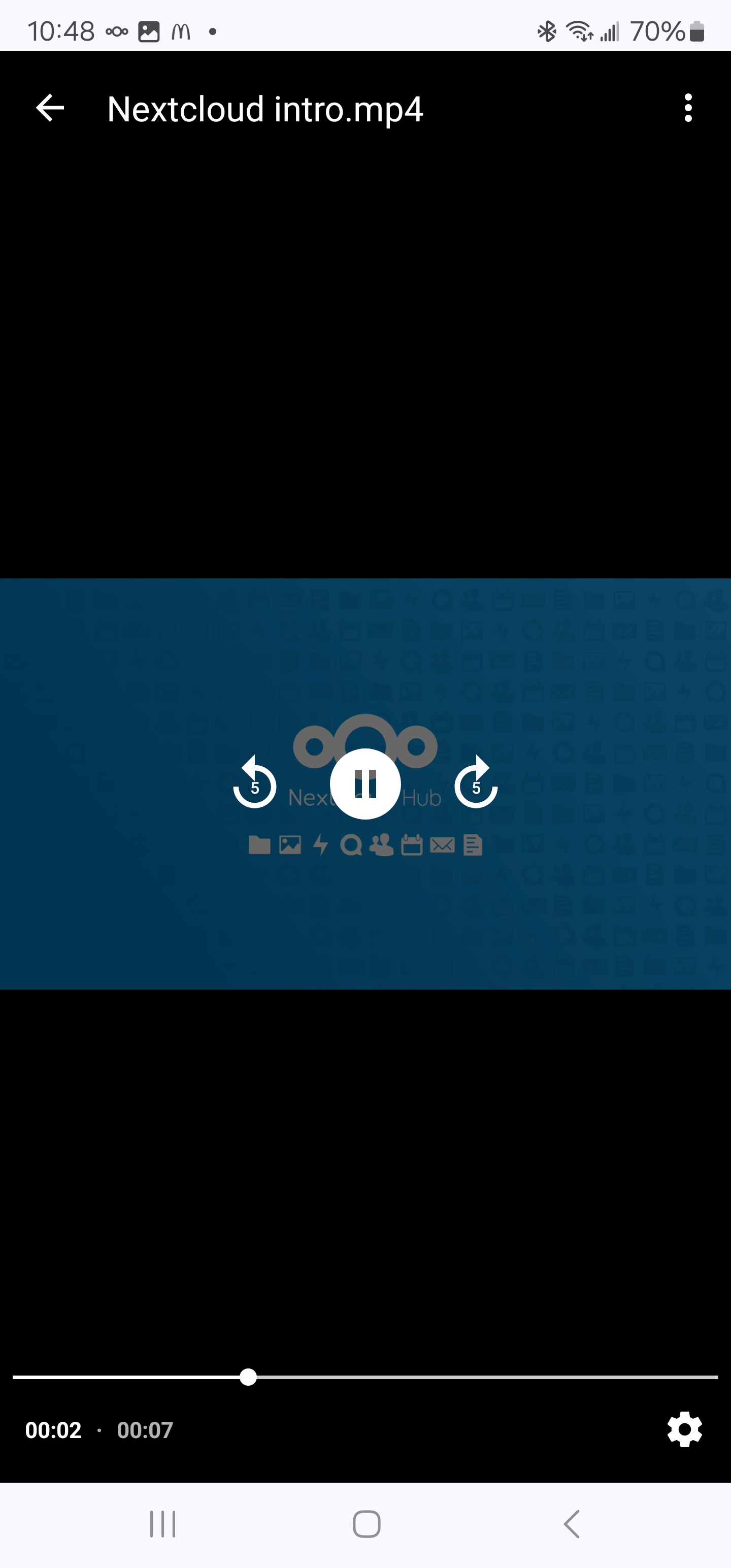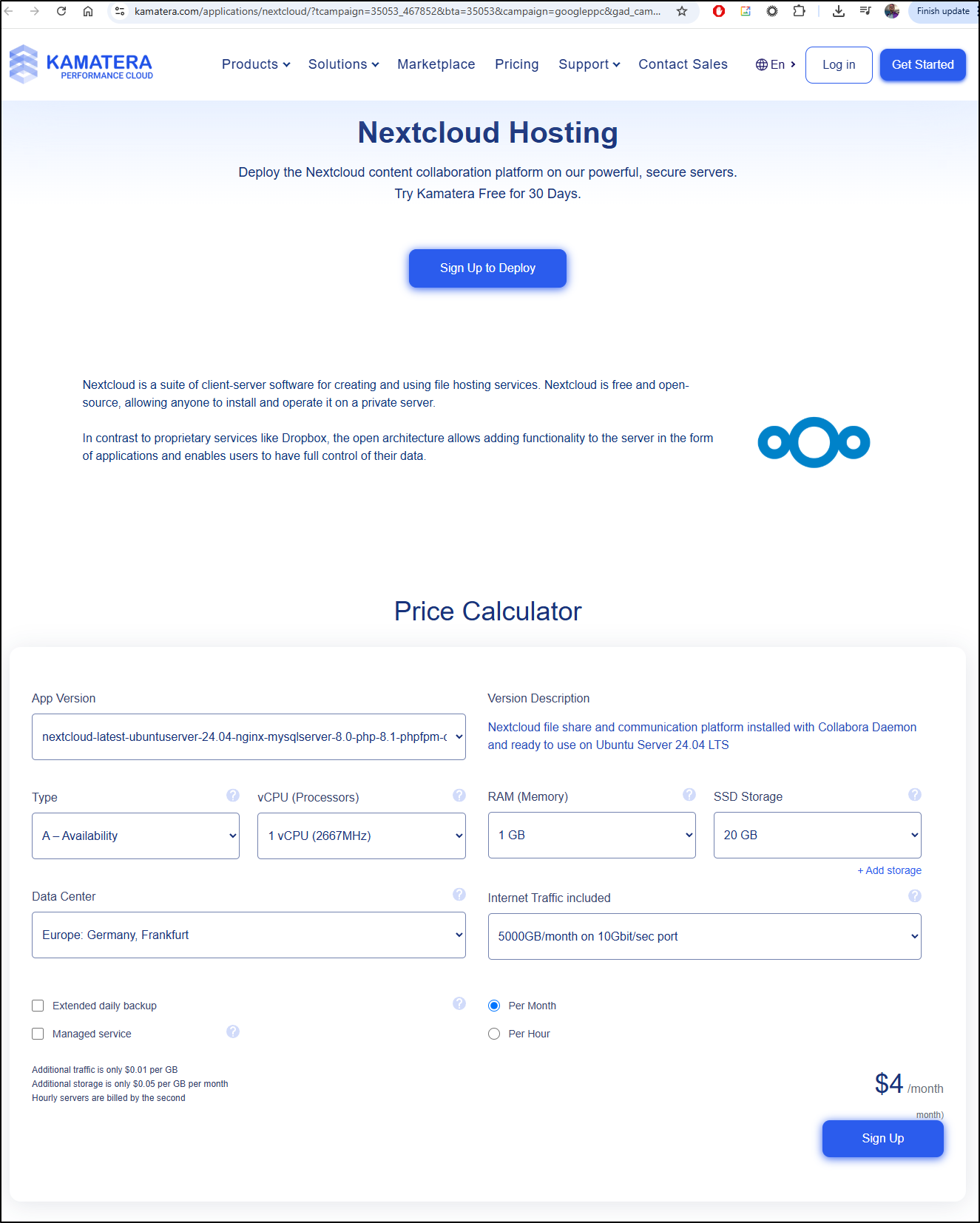Published: May 22, 2025 by Isaac Johnson
Today we are going to dig into two very cool Open-Source containerized apps. The first, which is much smaller is Airstation which is just a very simple way to fire up a containerize app to serve a stream of music (or anything mp3 - could be audiobooks, podcasts, sermons, etc).
The other app we’ll explore is much bigger, NextCloud, which has many ways to install and configure. We’ll look at a few including Kubernetes with helm. I’ll just cover some of the basics as well as mobile app usage. I’ll wrap with some notes on costs and hosting options.
Let’s get some tunes going first…
Airstation
I saw a MariousHosting article on Airstation recently and wanted to check into it.
We can see Airstation on Github and the Installation Docs.
We can see the docker-compose file in the Github repo
builder@DESKTOP-QADGF36:~/Workspaces$ git clone https://github.com/cheatsnake/airstation.git
Cloning into 'airstation'...
remote: Enumerating objects: 1816, done.
remote: Counting objects: 100% (253/253), done.
remote: Compressing objects: 100% (165/165), done.
remote: Total 1816 (delta 110), reused 197 (delta 65), pack-reused 1563 (from 1)
Receiving objects: 100% (1816/1816), 2.89 MiB | 11.10 MiB/s, done.
Resolving deltas: 100% (1013/1013), done.
builder@DESKTOP-QADGF36:~/Workspaces$ cd airstation/
builder@DESKTOP-QADGF36:~/Workspaces/airstation$ cat docker-compose.yml
services:
app:
build:
context: .
dockerfile: Dockerfile
args:
- AIRSTATION_PLAYER_TITLE=${AIRSTATION_PLAYER_TITLE}
ports:
- "7331:7331"
volumes:
- database:/app/storage
- ./static:/app/static
restart: unless-stopped
env_file:
- .env
volumes:
database:
Let’s now create some random strings
builder@DESKTOP-QADGF36:~/Workspaces/airstation$ cat .env
AIRSTATION_SECRET_KEY=lzJtFwSMQzUKdBmAmq6b
AIRSTATION_JWT_SIGN=LUzCDDM5X2kMjrKvOHoclku
Then we can fire up docker compose
builder@DESKTOP-QADGF36:~/Workspaces/airstation$ docker compose up -d
WARN[0000] The "AIRSTATION_PLAYER_TITLE" variable is not set. Defaulting to a blank string.
Compose can now delegate builds to bake for better performance.
To do so, set COMPOSE_BAKE=true.
[+] Building 45.8s (34/34) FINISHED docker:default
=> [app internal] load build definition from Dockerfile 0.1s
=> => transferring dockerfile: 830B 0.0s
=> [app internal] load metadata for docker.io/library/node:22-alpine 1.4s
=> [app internal] load metadata for docker.io/library/golang:1.24-alpine 1.4s
=> [app internal] load metadata for docker.io/library/alpine:latest 1.4s
=> [app auth] library/golang:pull token for registry-1.docker.io 0.0s
=> [app auth] library/alpine:pull token for registry-1.docker.io 0.0s
=> [app auth] library/node:pull token for registry-1.docker.io 0.0s
=> [app internal] load .dockerignore 0.0s
=> => transferring context: 85B 0.0s
=> [app server 1/7] FROM docker.io/library/golang:1.24-alpine@sha256:ef18ee7117463ac1055f5a370ed18b8750f01589f13ea0b48642f5792b234044 17.6s
=> => resolve docker.io/library/golang:1.24-alpine@sha256:ef18ee7117463ac1055f5a370ed18b8750f01589f13ea0b48642f5792b234044 0.0s
=> => sha256:ef18ee7117463ac1055f5a370ed18b8750f01589f13ea0b48642f5792b234044 10.29kB / 10.29kB 0.0s
=> => sha256:be1cf73ca9fbe9c5108691405b627cf68b654fb6838a17bc1e95cc48593e70da 1.92kB / 1.92kB 0.0s
=> => sha256:68d4da47fd566b8a125df912bff4ab337355b1f6b2c478f5e8593cb98b4d1563 2.08kB / 2.08kB 0.0s
=> => sha256:bcde94e77dfab30cceb8ba9b43d3c7ac5efb03bcd79b63cf02b60a0c23261582 294.91kB / 294.91kB 0.4s
=> => extracting sha256:bcde94e77dfab30cceb8ba9b43d3c7ac5efb03bcd79b63cf02b60a0c23261582 0.2s
=> => sha256:92b00dc8dfbaa6cd7e39d09d4f1c726259b4d9a29c697192955da032f472d642 78.98MB / 78.98MB 4.5s
=> => sha256:9b664c7c39c20f5e319a449219b9641bd2fdf7325727a3f69abe1e81bf0f726a 126B / 126B 0.7s
=> => sha256:4f4fb700ef54461cfa02571ae0db9a0dc1e0cdb5577484a6d75e68dc38e8acc1 32B / 32B 0.8s
=> => extracting sha256:92b00dc8dfbaa6cd7e39d09d4f1c726259b4d9a29c697192955da032f472d642 12.3s
=> => extracting sha256:9b664c7c39c20f5e319a449219b9641bd2fdf7325727a3f69abe1e81bf0f726a 0.0s
=> => extracting sha256:4f4fb700ef54461cfa02571ae0db9a0dc1e0cdb5577484a6d75e68dc38e8acc1 0.0s
=> [app stage-3 1/6] FROM docker.io/library/alpine:latest@sha256:a8560b36e8b8210634f77d9f7f9efd7ffa463e380b75e2e74aff4511df3ef88c 0.1s
=> => resolve docker.io/library/alpine:latest@sha256:a8560b36e8b8210634f77d9f7f9efd7ffa463e380b75e2e74aff4511df3ef88c 0.0s
=> => sha256:1c4eef651f65e2f7daee7ee785882ac164b02b78fb74503052a26dc061c90474 1.02kB / 1.02kB 0.0s
=> => sha256:aded1e1a5b3705116fa0a92ba074a5e0b0031647d9c315983ccba2ee5428ec8b 581B / 581B 0.0s
=> => sha256:a8560b36e8b8210634f77d9f7f9efd7ffa463e380b75e2e74aff4511df3ef88c 9.22kB / 9.22kB 0.0s
=> [app internal] load build context 0.1s
=> => transferring context: 764.21kB 0.1s
=> [app studio 1/6] FROM docker.io/library/node:22-alpine@sha256:152270cd4bd094d216a84cbc3c5eb1791afb05af00b811e2f0f04bdc6c473602 7.8s
=> => resolve docker.io/library/node:22-alpine@sha256:152270cd4bd094d216a84cbc3c5eb1791afb05af00b811e2f0f04bdc6c473602 0.0s
=> => sha256:97c5ed51c64a35c1695315012fd56021ad6b3135a30b6a82a84b414fd6f65851 6.21kB / 6.21kB 0.0s
=> => sha256:f3bde9621711f54e446f593ab1fb00d66aad452bb83a5417a77c5b37bbdb4874 50.42MB / 50.42MB 3.1s
=> => sha256:e7db676aa884bcad4c892a937041d52418dd738c1e0a8347868c9a3f996a9b6a 1.26MB / 1.26MB 0.4s
=> => sha256:28e4c8cb54c6966a37f792aa8b3fe9b8b4e6957eb2957dac0c99ade5fb2350b2 447B / 447B 0.3s
=> => sha256:152270cd4bd094d216a84cbc3c5eb1791afb05af00b811e2f0f04bdc6c473602 6.41kB / 6.41kB 0.0s
=> => sha256:d1068d8b737ffed2b8e9d0e9313177a2e2786c36780c5467ac818232e603ccd0 1.72kB / 1.72kB 0.0s
=> => extracting sha256:f3bde9621711f54e446f593ab1fb00d66aad452bb83a5417a77c5b37bbdb4874 4.2s
=> => extracting sha256:e7db676aa884bcad4c892a937041d52418dd738c1e0a8347868c9a3f996a9b6a 0.1s
=> => extracting sha256:28e4c8cb54c6966a37f792aa8b3fe9b8b4e6957eb2957dac0c99ade5fb2350b2 0.0s
=> [app stage-3 2/6] WORKDIR /app 0.1s
=> [app stage-3 3/6] RUN apk add --no-cache ffmpeg 8.8s
=> [app studio 2/6] WORKDIR /app 1.1s
=> [app player 3/6] COPY ./web/player/package*.json ./ 0.1s
=> [app studio 3/6] COPY ./web/studio/package*.json ./ 0.1s
=> [app player 4/6] RUN npm install 10.7s
=> [app studio 4/6] RUN npm install 13.6s
=> [app server 2/7] WORKDIR /app 1.3s
=> [app server 3/7] COPY go.mod go.sum ./ 0.1s
=> [app server 4/7] RUN go mod download 8.1s
=> [app player 5/6] COPY ./web/player . 0.0s
=> [app player 6/6] RUN npm run build 11.0s
=> [app studio 5/6] COPY ./web/studio . 0.1s
=> [app studio 6/6] RUN npm run build 16.2s
=> [app server 5/7] COPY cmd/ ./cmd/ 0.0s
=> [app server 6/7] COPY internal/ ./internal/ 0.0s
=> [app server 7/7] RUN CGO_ENABLED=0 GOOS=linux go build -ldflags="-s -w" -o /app/bin/main ./cmd/main.go 15.8s
=> [app stage-3 4/6] COPY --from=server /app/bin/main . 0.1s
=> [app stage-3 5/6] COPY --from=player /app/dist ./web/player/dist 0.0s
=> [app stage-3 6/6] COPY --from=studio /app/dist ./web/studio/dist 0.0s
=> [app] exporting to image 0.9s
=> => exporting layers 0.9s
=> => writing image sha256:905fd2440aae135199581fb7a9b22c18e2621b5688e74a3e573dc913fc45dc6e 0.0s
=> => naming to docker.io/library/airstation-app 0.0s
=> [app] resolving provenance for metadata file 0.0s
[+] Running 4/4
✔ app Built 0.0s
✔ Network airstation_default Created 0.1s
✔ Volume "airstation_database" Created 0.0s
✔ Container airstation-app-1 Started
I can now access it from port 7331
I’ll stop it
builder@DESKTOP-QADGF36:~/Workspaces/airstation$ docker stop airstation-app-1
airstation-app-1
builder@DESKTOP-QADGF36:~/Workspaces/airstation$ docker rm airstation-app-1
airstation-app-1
We can login to the admin page
I uploaded some Mp3s (I bought on Vinyl but is also on bandcamp by the way)
builder@DESKTOP-QADGF36:~/Workspaces/airstation$ cp /mnt/c/Users/isaac/MP3/*.mp3 ./static/tracks/
cp: cannot create regular file './static/tracks/01-01 KAZU Salty.mp3': Permission denied
cp: cannot create regular file './static/tracks/01-02 KAZU Come_Behind_Me_So_Good.mp3': Permission denied
cp: cannot create regular file './static/tracks/01-03 KAZU Meo.mp3': Permission denied
cp: cannot create regular file './static/tracks/01-04 KAZU Adult_Baby.mp3': Permission denied
cp: cannot create regular file './static/tracks/01-05 KAZU Place_of_Birth.mp3': Permission denied
cp: cannot create regular file './static/tracks/01-06 KAZU Name_and_Age.mp3': Permission denied
cp: cannot create regular file './static/tracks/01-07 KAZU Unsure_in_Waves.mp3': Permission denied
cp: cannot create regular file './static/tracks/01-08 KAZU Undo.mp3': Permission denied
cp: cannot create regular file './static/tracks/01-09 KAZU Coyote.mp3': Permission denied
builder@DESKTOP-QADGF36:~/Workspaces/airstation$ sudo cp /mnt/c/Users/isaac/MP3/*.mp3 ./static/tracks/
[sudo] password for builder:
I can then see the tracks in the UI
I can queue up some tracks
which now show in the queue
I can then play the track
I can then play to connect to the track
If the window is small enough, the Admin portal will show the current track playing
Ingress
Let’s create an A record
$ az account set --subscription "Pay-As-You-Go" && az network dns record-set a add-record -g idjdnsrg -z tpk.pw -a 75.73.224.240 -n airstation
{
"ARecords": [
{
"ipv4Address": "75.73.224.240"
}
],
"TTL": 3600,
"etag": "9ba9e07f-4bc6-4018-bc1f-7a6f7427f672",
"fqdn": "airstation.tpk.pw.",
"id": "/subscriptions/d955c0ba-13dc-44cf-a29a-8fed74cbb22d/resourceGroups/idjdnsrg/providers/Microsoft.Network/dnszones/tpk.pw/A/airstation",
"name": "airstation",
"provisioningState": "Succeeded",
"resourceGroup": "idjdnsrg",
"targetResource": {},
"trafficManagementProfile": {},
"type": "Microsoft.Network/dnszones/A"
}
I’ll go to the docker host to run this.
builder@builder-T100:~/airstation$ docker compose up -d
WARN[0000] The "AIRSTATION_PLAYER_TITLE" variable is not set. Defaulting to a blank string.
[+] Building 64.4s (33/33) FINISHED
=> [app internal] load build definition from Dockerfile 0.0s
=> => transferring dockerfile: 830B 0.0s
=> [app internal] load metadata for docker.io/library/alpine:latest 1.0s
=> [app internal] load metadata for docker.io/library/node:22-alpine 1.0s
=> [app internal] load metadata for docker.io/library/golang:1.24-alpine 1.0s
=> [app auth] library/golang:pull token for registry-1.docker.io 0.0s
=> [app auth] library/alpine:pull token for registry-1.docker.io 0.0s
=> [app auth] library/node:pull token for registry-1.docker.io 0.0s
=> [app internal] load .dockerignore 0.0s
=> => transferring context: 85B 0.0s
=> [app server 1/7] FROM docker.io/library/golang:1.24-alpine@sha256:ef18ee7117463ac1055f5a370ed18b8750f01589f13ea0b48642f5792b234044 8.0s
=> => resolve docker.io/library/golang:1.24-alpine@sha256:ef18ee7117463ac1055f5a370ed18b8750f01589f13ea0b48642f5792b234044 0.0s
=> => sha256:be1cf73ca9fbe9c5108691405b627cf68b654fb6838a17bc1e95cc48593e70da 1.92kB / 1.92kB 0.0s
=> => sha256:68d4da47fd566b8a125df912bff4ab337355b1f6b2c478f5e8593cb98b4d1563 2.08kB / 2.08kB 0.0s
=> => sha256:bcde94e77dfab30cceb8ba9b43d3c7ac5efb03bcd79b63cf02b60a0c23261582 294.91kB / 294.91kB 0.2s
=> => sha256:92b00dc8dfbaa6cd7e39d09d4f1c726259b4d9a29c697192955da032f472d642 78.98MB / 78.98MB 2.1s
=> => sha256:9b664c7c39c20f5e319a449219b9641bd2fdf7325727a3f69abe1e81bf0f726a 126B / 126B 0.2s
=> => sha256:ef18ee7117463ac1055f5a370ed18b8750f01589f13ea0b48642f5792b234044 10.29kB / 10.29kB 0.0s
=> => extracting sha256:bcde94e77dfab30cceb8ba9b43d3c7ac5efb03bcd79b63cf02b60a0c23261582 0.1s
=> => sha256:4f4fb700ef54461cfa02571ae0db9a0dc1e0cdb5577484a6d75e68dc38e8acc1 32B / 32B 0.3s
=> => extracting sha256:92b00dc8dfbaa6cd7e39d09d4f1c726259b4d9a29c697192955da032f472d642 5.4s
=> => extracting sha256:9b664c7c39c20f5e319a449219b9641bd2fdf7325727a3f69abe1e81bf0f726a 0.0s
=> => extracting sha256:4f4fb700ef54461cfa02571ae0db9a0dc1e0cdb5577484a6d75e68dc38e8acc1 0.0s
=> [app stage-3 1/6] FROM docker.io/library/alpine:latest@sha256:a8560b36e8b8210634f77d9f7f9efd7ffa463e380b75e2e74aff4511df3ef88c 0.1s
=> => resolve docker.io/library/alpine:latest@sha256:a8560b36e8b8210634f77d9f7f9efd7ffa463e380b75e2e74aff4511df3ef88c 0.0s
=> => sha256:1c4eef651f65e2f7daee7ee785882ac164b02b78fb74503052a26dc061c90474 1.02kB / 1.02kB 0.0s
=> => sha256:aded1e1a5b3705116fa0a92ba074a5e0b0031647d9c315983ccba2ee5428ec8b 581B / 581B 0.0s
=> => sha256:a8560b36e8b8210634f77d9f7f9efd7ffa463e380b75e2e74aff4511df3ef88c 9.22kB / 9.22kB 0.0s
=> [app studio 1/6] FROM docker.io/library/node:22-alpine@sha256:152270cd4bd094d216a84cbc3c5eb1791afb05af00b811e2f0f04bdc6c473602 4.3s
=> => resolve docker.io/library/node:22-alpine@sha256:152270cd4bd094d216a84cbc3c5eb1791afb05af00b811e2f0f04bdc6c473602 0.0s
=> => sha256:152270cd4bd094d216a84cbc3c5eb1791afb05af00b811e2f0f04bdc6c473602 6.41kB / 6.41kB 0.0s
=> => sha256:d1068d8b737ffed2b8e9d0e9313177a2e2786c36780c5467ac818232e603ccd0 1.72kB / 1.72kB 0.0s
=> => sha256:97c5ed51c64a35c1695315012fd56021ad6b3135a30b6a82a84b414fd6f65851 6.21kB / 6.21kB 0.0s
=> => sha256:f3bde9621711f54e446f593ab1fb00d66aad452bb83a5417a77c5b37bbdb4874 50.42MB / 50.42MB 1.9s
=> => sha256:e7db676aa884bcad4c892a937041d52418dd738c1e0a8347868c9a3f996a9b6a 1.26MB / 1.26MB 0.7s
=> => sha256:28e4c8cb54c6966a37f792aa8b3fe9b8b4e6957eb2957dac0c99ade5fb2350b2 447B / 447B 0.8s
=> => extracting sha256:f3bde9621711f54e446f593ab1fb00d66aad452bb83a5417a77c5b37bbdb4874 1.7s
=> => extracting sha256:e7db676aa884bcad4c892a937041d52418dd738c1e0a8347868c9a3f996a9b6a 0.0s
=> => extracting sha256:28e4c8cb54c6966a37f792aa8b3fe9b8b4e6957eb2957dac0c99ade5fb2350b2 0.0s
=> [app internal] load build context 0.0s
=> => transferring context: 764.21kB 0.0s
=> [app stage-3 2/6] WORKDIR /app 0.2s
=> [app stage-3 3/6] RUN apk add --no-cache ffmpeg 14.8s
=> [app studio 2/6] WORKDIR /app 0.6s
=> [app player 3/6] COPY ./web/player/package*.json ./ 0.3s
=> [app studio 3/6] COPY ./web/studio/package*.json ./ 0.3s
=> [app studio 4/6] RUN npm install 14.1s
=> [app player 4/6] RUN npm install 12.1s
=> [app server 2/7] WORKDIR /app 0.6s
=> [app server 3/7] COPY go.mod go.sum ./ 0.1s
=> [app server 4/7] RUN go mod download 9.0s
=> [app player 5/6] COPY ./web/player . 0.4s
=> [app server 5/7] COPY cmd/ ./cmd/ 0.1s
=> [app player 6/6] RUN npm run build 20.4s
=> [app server 6/7] COPY internal/ ./internal/ 0.2s
=> [app server 7/7] RUN CGO_ENABLED=0 GOOS=linux go build -ldflags="-s -w" -o /app/bin/main ./cmd/main.go 44.2s
=> [app studio 5/6] COPY ./web/studio . 0.1s
=> [app studio 6/6] RUN npm run build 31.2s
=> [app stage-3 4/6] COPY --from=server /app/bin/main . 0.1s
=> [app stage-3 5/6] COPY --from=player /app/dist ./web/player/dist 0.1s
=> [app stage-3 6/6] COPY --from=studio /app/dist ./web/studio/dist 0.0s
=> [app] exporting to image 0.6s
=> => exporting layers 0.6s
=> => writing image sha256:53501a11caf6a4714e67626e5f411171db381cf3dbe2427c0eeb55c834e302f1 0.0s
=> => naming to docker.io/library/airstation-app 0.0s
[+] Running 3/3
✔ Network airstation_default Created 0.2s
✔ Volume "airstation_database" Created 0.0s
✔ Container airstation-app-1 Started
And then use a Kubernetes Manifest to launch it
$ cat ./airstation.yaml
apiVersion: v1
kind: Endpoints
metadata:
name: airstation-external-ip
subsets:
- addresses:
- ip: 192.168.1.100
ports:
- name: airstationint
port: 7331
protocol: TCP
---
apiVersion: v1
kind: Service
metadata:
name: airstation-external-ip
spec:
clusterIP: None
clusterIPs:
- None
internalTrafficPolicy: Cluster
ipFamilies:
- IPv4
- IPv6
ipFamilyPolicy: RequireDualStack
ports:
- name: airstation
port: 80
protocol: TCP
targetPort: 7331
sessionAffinity: None
type: ClusterIP
---
apiVersion: networking.k8s.io/v1
kind: Ingress
metadata:
annotations:
cert-manager.io/cluster-issuer: azuredns-tpkpw
ingress.kubernetes.io/ssl-redirect: "true"
kubernetes.io/ingress.class: nginx
kubernetes.io/tls-acme: "true"
nginx.ingress.kubernetes.io/proxy-read-timeout: "3600"
nginx.ingress.kubernetes.io/proxy-send-timeout: "3600"
nginx.org/websocket-services: airstation-external-ip
generation: 1
name: airstationingress
spec:
rules:
- host: airstation.tpk.pw
http:
paths:
- backend:
service:
name: airstation-external-ip
port:
number: 80
path: /
pathType: ImplementationSpecific
tls:
- hosts:
- airstation.tpk.pw
secretName: airstation-tls
$ kubectl apply -f ./airstation.yaml
endpoints/airstation-external-ip created
service/airstation-external-ip created
ingress.networking.k8s.io/airstationingress created
When I see the cert is satisified
$ kubectl get cert airstation-tls
NAME READY SECRET AGE
airstation-tls False airstation-tls 63s
$ kubectl get cert airstation-tls
NAME READY SECRET AGE
airstation-tls True airstation-tls 90s
I can now view my station
I realized it was a bit slow on the older dockerhost so i moved to the Ryzen box.
While doing so, I took a moment to mount an old share that had music and mp3s
I fired it up with docker compose up but did not see the tracks
I get different results on some subsequent refreshes.
It doesn’t seem to like subfolders.
I even hopped in the container and could clearly see the files
I tried a different mount and symlinking them. but it seemed to hang up the container from indexing files. From the logs
2025-05-20 20:55:53 WARN trackservice: Failed to prepare a track for streaming: triming audio failed: exit status 254
Output: ffmpeg version 6.1.2 Copyright (c) 2000-2024 the FFmpeg developers
built with gcc 14.2.0 (Alpine 14.2.0)
configuration: --prefix=/usr --disable-librtmp --disable-lzma --disable-static --disable-stripping --enable-avfilter --enable-gpl --enable-ladspa --enable-libaom --enable-libass --enable-libbluray --enable-libdav1d --enable-libdrm --enable-libfontconfig --enable-libfreetype --enable-libfribidi --enable-libharfbuzz --enable-libmp3lame --enable-libopenmpt --enable-libopus --enable-libplacebo --enable-libpulse --enable-librav1e --enable-librist --enable-libsoxr --enable-libsrt --enable-libssh --enable-libtheora --enable-libv4l2 --enable-libvidstab --enable-libvorbis --enable-libvpx --enable-libwebp --enable-libx264 --enable-libx265 --enable-libxcb --enable-libxml2 --enable-libxvid --enable-libzimg --enable-libzmq --enable-lto=auto --enable-lv2 --enable-openssl --enable-pic --enable-postproc --enable-pthreads --enable-shared --enable-vaapi --enable-vdpau --enable-version3 --enable-vulkan --optflags=-O3 --enable-libjxl --enable-libsvtav1 --enable-libvpl
libavutil 58. 29.100 / 58. 29.100
libavcodec 60. 31.102 / 60. 31.102
libavformat 60. 16.100 / 60. 16.100
libavdevice 60. 3.100 / 60. 3.100
libavfilter 9. 12.100 / 9. 12.100
libswscale 7. 5.100 / 7. 5.100
libswresample 4. 12.100 / 4. 12.100
libpostproc 57. 3.100 / 57. 3.100
[in#0 @ 0x77784065a940] Error opening input: No such file or directory
Error opening input file static/tracks/01-The-Space-In-Between.mp3.
Error opening input files: No such file or directory
I copied some files and started the station and queued one track.
I found that it did indeed repeat the track over and over so the queue repeats indefinitely
I swapped servers by just changing the Host IP in the Endpoint
$ cat airstation.yaml | head -n 15
apiVersion: v1
kind: Endpoints
metadata:
name: airstation-external-ip
subsets:
- addresses:
- ip: 192.168.1.143
ports:
- name: airstationint
port: 7331
protocol: TCP
---
apiVersion: v1
kind: Service
metadata:
$ kubectl apply -f airstation.yaml
endpoints/airstation-external-ip configured
service/airstation-external-ip unchanged
ingress.networking.k8s.io/airstationingress unchanged
And now the Airstation looks like the one on the Ryzen
I ran into an issue where a uniqueness constraint kept failing
builder@bosgamerz9:~/airstation/static/tracks$ sudo docker logs 5d777a950376
2025-05-20 21:00:16 INFO storage: Sqlite database connected.
2025-05-20 21:00:16 WARN http: Auto start playing failed: playback queue is empty
2025-05-20 21:00:16 INFO http: Server starts on http://localhost:7331
2025-05-20 21:00:21 WARN trackservice: Failed to save track to database: tmptuduf7tq.mp3 is too short for streaming
2025-05-20 21:23:32 INFO http: New login succeed from airstation.tpk.pw with secureCookie=false
2025-05-20 21:30:13 WARN trackservice: Failed to save track to database: failed to insert track: constraint failed: UNIQUE constraint failed: tracks.name (2067)
2025-05-20 21:32:35 WARN trackservice: Failed to save track to database: failed to insert track: constraint failed: UNIQUE constraint failed: tracks.name (2067)
2025-05-20 21:33:20 WARN trackservice: Failed to save track to database: failed to insert track: constraint failed: UNIQUE constraint failed: tracks.name (2067)
Should you need to reset things, you need to remember to wipe the DB too or it will be all for naught
builder@bosgamerz9:~/airstation$ sudo docker compose down
WARN[0000] The "AIRSTATION_PLAYER_TITLE" variable is not set. Defaulting to a blank string.
[+] Running 2/2
✔ Container airstation-app-1 Removed 0.2s
✔ Network airstation_default Removed 0.2s
builder@bosgamerz9:~/airstation$ sudo docker volume remove airstation_database
airstation_database
This time it came up without issue
I then queued the free 2010 How to Destroy Angles NIN EP and a 1908 phonograph recording I made, both of which shouldn’t get me in trouble for streaming.
Then started the stream
I can join the stream to listen at https://airstation.tpk.pw/
Nextcloud
I had come across a few good tools from this article including n8n. The other tool he wrote on was Nextcloud
The setup involved a docker compose on a Hetzner VM.
services:
nextcloud:
depends_on:
- postgres
image: nextcloud:apache
environment:
- POSTGRES_HOST=postgres
- POSTGRES_PASSWORD=nextcloud
- POSTGRES_DB=nextcloud
- POSTGRES_USER=nextcloud
ports:
- 8000:80
restart: always
volumes:
- nc_data:/var/www/html
postgres:
image: postgres:alpine
environment:
- POSTGRES_PASSWORD=nextcloud
- POSTGRES_DB=nextcloud
- POSTGRES_USER=nextcloud
restart: always
volumes:
- db_data:/var/lib/postgresql/data
expose:
- 5432
volumes:
db_data:
nc_data:
This seemed overly complicated to me. I was about to convert the Docker-compose to a manifest when i did a quick search and found this chart repo
We can add the repo and update
helm repo add nextcloud https://nextcloud.github.io/helm/
helm repo update
I can now install with helm install my-release nextcloud/nextcloud
$ helm install my-nc-release nextcloud/nextcloud
NAME: my-nc-release
LAST DEPLOYED: Mon May 19 19:12:06 2025
NAMESPACE: default
STATUS: deployed
REVISION: 1
TEST SUITE: None
NOTES:
#######################################################################################################
## WARNING: You did not provide an external database host in your 'helm install' call ##
## Running Nextcloud with the integrated sqlite database is not recommended for production instances ##
#######################################################################################################
For better performance etc. you have to configure nextcloud with a resolvable database
host. To configure nextcloud to use and external database host:
1. Complete your nextcloud deployment by running:
export APP_HOST=127.0.0.1
export APP_PASSWORD=$(kubectl get secret --namespace default my-nc-release-nextcloud -o jsonpath="{.data.nextcloud-password}" | base64 --decode)
## PLEASE UPDATE THE EXTERNAL DATABASE CONNECTION PARAMETERS IN THE FOLLOWING COMMAND AS NEEDED ##
helm upgrade my-nc-release nextcloud/nextcloud \
--set nextcloud.password=$APP_PASSWORD,nextcloud.host=$APP_HOST,service.type=ClusterIP,mariadb.enabled=false,externalDatabase.user=nextcloud,externalDatabase.database=nextcloud,externalDatabase.host=YOUR_EXTERNAL_DATABASE_HOST
I checked on the pod
$ kubectl get po -l app.kubernetes.io/name=nextcloud
NAME READY STATUS RESTARTS AGE
my-nc-release-nextcloud-8b479f744-vjk7m 0/1 Running 0 74s
$ kubectl get po -l app.kubernetes.io/name=nextcloud
NAME READY STATUS RESTARTS AGE
my-nc-release-nextcloud-8b479f744-vjk7m 1/1 Running 0 99s
I can see a service created
$ kubectl get svc my-nc-release-nextcloud
NAME TYPE CLUSTER-IP EXTERNAL-IP PORT(S) AGE
my-nc-release-nextcloud ClusterIP 10.43.203.50 <none> 8080/TCP 2m9s
$ kubectl port-forward svc/my-nc-release-nextcloud 8888:8080 Forwarding from 127.0.0.1:8888 -> 80 Forwarding from [::1]:8888 -> 80
I can now try the web ui
I logged in with admin and the password from the kubectl command (changeme)
Once through a bit of a slide show I was presented with the dashboard
My first step was to change the password
Once I verified that, I decided to pivot to setting up the ingress.
$ az account set --subscription "Pay-As-You-Go" && az network dns record-set a add-record -g idjdnsrg -z tpk.pw -a 75.73.224.240 -n nextcloud
{
"ARecords": [
{
"ipv4Address": "75.73.224.240"
}
],
"TTL": 3600,
"etag": "9a9ec82c-b78b-4a3c-bc50-635adfcc535b",
"fqdn": "nextcloud.tpk.pw.",
"id": "/subscriptions/d955c0ba-13dc-44cf-a29a-8fed74cbb22d/resourceGroups/idjdnsrg/providers/Microsoft.Network/dnszones/tpk.pw/A/nextcloud",
"name": "nextcloud",
"provisioningState": "Succeeded",
"resourceGroup": "idjdnsrg",
"targetResource": {},
"trafficManagementProfile": {},
"type": "Microsoft.Network/dnszones/A"
}
Since we have a CluusterIP service already, adding an Ingress is easy
$ cat ./nextcloud.yaml
apiVersion: networking.k8s.io/v1
kind: Ingress
metadata:
annotations:
cert-manager.io/cluster-issuer: azuredns-tpkpw
ingress.kubernetes.io/ssl-redirect: "true"
kubernetes.io/ingress.class: nginx
kubernetes.io/tls-acme: "true"
nginx.ingress.kubernetes.io/proxy-read-timeout: "3600"
nginx.ingress.kubernetes.io/proxy-send-timeout: "3600"
nginx.org/websocket-services: my-nc-release-nextcloud
name: nextcloudingress
spec:
rules:
- host: nextcloud.tpk.pw
http:
paths:
- backend:
service:
name: my-nc-release-nextcloud
port:
number: 8080
path: /
pathType: ImplementationSpecific
tls:
- hosts:
- nextcloud.tpk.pw
secretName: nextcloud-tls
$ kubectl apply -f ./nextcloud.yaml
ingress.networking.k8s.io/nextcloudingress created
When I saw the cert satisified
$ kubectl get cert nextcloud-tls
NAME READY SECRET AGE
nextcloud-tls False nextcloud-tls 43s
$ kubectl get cert nextcloud-tls
NAME READY SECRET AGE
nextcloud-tls True nextcloud-tls 2m29s
However, it seems we need to set a trusted domain setting somewhere to make this work
I’m going to try a quick upgrade via the helm chart
$ helm upgrade my-nc-release --set nextcloud.trustedDomains[0]=nextcloud.tpk.pw nextcloud/nextcloud
Release "my-nc-release" has been upgraded. Happy Helming!
NAME: my-nc-release
LAST DEPLOYED: Mon May 19 19:29:15 2025
NAMESPACE: default
STATUS: deployed
REVISION: 3
TEST SUITE: None
NOTES:
#######################################################################################################
## WARNING: You did not provide an external database host in your 'helm install' call ##
## Running Nextcloud with the integrated sqlite database is not recommended for production instances ##
#######################################################################################################
For better performance etc. you have to configure nextcloud with a resolvable database
host. To configure nextcloud to use and external database host:
1. Complete your nextcloud deployment by running:
export APP_HOST=127.0.0.1
export APP_PASSWORD=$(kubectl get secret --namespace default my-nc-release-nextcloud -o jsonpath="{.data.nextcloud-password}" | base64 --decode)
## PLEASE UPDATE THE EXTERNAL DATABASE CONNECTION PARAMETERS IN THE FOLLOWING COMMAND AS NEEDED ##
helm upgrade my-nc-release nextcloud/nextcloud \
--set nextcloud.password=$APP_PASSWORD,nextcloud.host=$APP_HOST,service.type=ClusterIP,mariadb.enabled=false,externalDatabase.user=nextcloud,externalDatabase.database=nextcloud,externalDatabase.host=YOUR_EXTERNAL_DATABASE_HOST
Even though the values looks right
$ helm get values my-nc-release
USER-SUPPLIED VALUES:
nextcloud:
trustedDomains:
- nextcloud.tpk.pw
it seems to just keep resetting.
$ kubectl get po -l app.kubernetes.io/name=nextcloud
NAME READY STATUS RESTARTS AGE
my-nc-release-nextcloud-68d944595b-qhbcb 0/1 Running 5 (33s ago) 4m14s
$ kubectl logs my-nc-release-nextcloud-68d944595b-qhbcb --previous
=> Searching for hook scripts (*.sh) to run, located in the folder "/docker-entrypoint-hooks.d/before-starting"
==> Skipped: the "before-starting" folder is empty (or does not exist)
AH00558: apache2: Could not reliably determine the server's fully qualified domain name, using 10.42.1.192. Set the 'ServerName' directive globally to suppress this message
AH00558: apache2: Could not reliably determine the server's fully qualified domain name, using 10.42.1.192. Set the 'ServerName' directive globally to suppress this message
[Tue May 20 00:33:03.363636 2025] [mpm_prefork:notice] [pid 1:tid 1] AH00163: Apache/2.4.62 (Debian) PHP/8.3.21 configured -- resuming normal operations
[Tue May 20 00:33:03.363683 2025] [core:notice] [pid 1:tid 1] AH00094: Command line: 'apache2 -D FOREGROUND'
10.42.1.1 - - [20/May/2025:00:33:21 +0000] "GET /status.php HTTP/1.1" 400 1416 "-" "kube-probe/1.26"
10.42.1.1 - - [20/May/2025:00:33:21 +0000] "GET /status.php HTTP/1.1" 400 1422 "-" "kube-probe/1.26"
10.42.1.1 - - [20/May/2025:00:33:31 +0000] "GET /status.php HTTP/1.1" 400 1420 "-" "kube-probe/1.26"
10.42.1.1 - - [20/May/2025:00:33:31 +0000] "GET /status.php HTTP/1.1" 400 1424 "-" "kube-probe/1.26"
10.42.1.1 - - [20/May/2025:00:33:41 +0000] "GET /status.php HTTP/1.1" 400 1412 "-" "kube-probe/1.26"
10.42.1.1 - - [20/May/2025:00:33:41 +0000] "GET /status.php HTTP/1.1" 400 1410 "-" "kube-probe/1.26"
[Tue May 20 00:33:41.727923 2025] [mpm_prefork:notice] [pid 1:tid 1] AH00170: caught SIGWINCH, shutting down gracefully
10.42.1.1 - - [20/May/2025:00:33:41 +0000] "GET /status.php HTTP/1.1" 400 1416 "-" "kube-probe/1.26"
I’ll try a delete and restart
$ helm delete my-nc-release
release "my-nc-release" uninstalled
builder@LuiGi:~/Workspaces/jekyll-blog$ helm upgrade --install my-nc-release --set nextcloud.trustedDomains[0]=nextcloud.tpk.pw nextcloud/nextcloud
Release "my-nc-release" does not exist. Installing it now.
NAME: my-nc-release
LAST DEPLOYED: Mon May 19 19:35:18 2025
NAMESPACE: default
STATUS: deployed
REVISION: 1
TEST SUITE: None
NOTES:
#######################################################################################################
## WARNING: You did not provide an external database host in your 'helm install' call ##
## Running Nextcloud with the integrated sqlite database is not recommended for production instances ##
#######################################################################################################
For better performance etc. you have to configure nextcloud with a resolvable database
host. To configure nextcloud to use and external database host:
1. Complete your nextcloud deployment by running:
export APP_HOST=127.0.0.1
export APP_PASSWORD=$(kubectl get secret --namespace default my-nc-release-nextcloud -o jsonpath="{.data.nextcloud-password}" | base64 --decode)
## PLEASE UPDATE THE EXTERNAL DATABASE CONNECTION PARAMETERS IN THE FOLLOWING COMMAND AS NEEDED ##
helm upgrade my-nc-release nextcloud/nextcloud \
--set nextcloud.password=$APP_PASSWORD,nextcloud.host=$APP_HOST,service.type=ClusterIP,mariadb.enabled=false,externalDatabase.user=nextcloud,externalDatabase.database=nextcloud,externalDatabase.host=YOUR_EXTERNAL_DATABASE_HOST
That seemed to work
$ kubectl get po -l app.kubernetes.io/name=nextcloud
NAME READY STATUS RESTARTS AGE
my-nc-release-nextcloud-68d944595b-wk9wn 0/1 Running 2 (19s ago) 100s
I tried fixing the values, including host then trying again. I also defined my ingress in the values file and deleted the one I had made manually
$ helm upgrade --install my-nc-release --values nc.values.yaml nextcloud/nextcloud
Release "my-nc-release" does not exist. Installing it now.
NAME: my-nc-release
LAST DEPLOYED: Mon May 19 20:21:31 2025
NAMESPACE: default
STATUS: deployed
REVISION: 1
TEST SUITE: None
NOTES:
#######################################################################################################
## WARNING: You did not provide an external database host in your 'helm install' call ##
## Running Nextcloud with the integrated sqlite database is not recommended for production instances ##
#######################################################################################################
For better performance etc. you have to configure nextcloud with a resolvable database
host. To configure nextcloud to use and external database host:
1. Complete your nextcloud deployment by running:
export APP_HOST=127.0.0.1
export APP_PASSWORD=$(kubectl get secret --namespace default my-nc-release-nextcloud -o jsonpath="{.data.nextcloud-password}" | base64 --decode)
## PLEASE UPDATE THE EXTERNAL DATABASE CONNECTION PARAMETERS IN THE FOLLOWING COMMAND AS NEEDED ##
helm upgrade my-nc-release nextcloud/nextcloud \
--set nextcloud.password=$APP_PASSWORD,nextcloud.host=$APP_HOST,service.type=ClusterIP,mariadb.enabled=false,externalDatabase.user=nextcloud,externalDatabase.database=nextcloud,externalDatabase.host=YOUR_EXTERNAL_DATABASE_HOST
$ kubectl get po -l app.kubernetes.io/name=nextcloud
NAME READY STATUS RESTARTS AGE
my-nc-release-nextcloud-6947bd695-jgw4x 1/1 Running 0 50s
Logging in, however, just seems to time out
I actually had to fight this for a bit to get the helm values to work since most tips I found online dealt with the local VM install.
My values ended up as:
$ cat values.yaml
affinity: {}
collabora:
autoscaling:
enabled: false
collabora:
aliasgroups: []
existingSecret:
enabled: false
passwordKey: password
secretName: ""
usernameKey: username
extra_params: --o:ssl.enable=false
password: examplepass
server_name: null
username: admin
enabled: false
ingress:
annotations: {}
className: ""
enabled: false
hosts:
- host: chart-example.local
paths:
- path: /
pathType: ImplementationSpecific
tls: []
resources: {}
cronjob:
command:
- /cron.sh
enabled: false
lifecycle: {}
resources: {}
securityContext: {}
deploymentAnnotations: {}
deploymentLabels: {}
dnsConfig: {}
externalDatabase:
database: nextcloud
enabled: false
existingSecret:
enabled: false
passwordKey: db-password
usernameKey: db-username
host: ""
password: ""
type: mysql
user: nextcloud
fullnameOverride: ""
hpa:
cputhreshold: 60
enabled: false
maxPods: 10
minPods: 1
image:
flavor: apache
pullPolicy: IfNotPresent
repository: nextcloud
tag: null
imaginary:
enabled: false
image:
pullPolicy: IfNotPresent
pullSecrets: []
registry: docker.io
repository: h2non/imaginary
tag: 1.2.4
livenessProbe:
enabled: true
failureThreshold: 3
periodSeconds: 10
successThreshold: 1
timeoutSeconds: 1
nodeSelector: {}
podAnnotations: {}
podLabels: {}
podSecurityContext: {}
readinessProbe:
enabled: true
failureThreshold: 3
periodSeconds: 10
successThreshold: 1
timeoutSeconds: 1
replicaCount: 1
resources: {}
securityContext:
runAsNonRoot: true
runAsUser: 1000
service:
annotations: {}
labels: {}
loadBalancerIP: null
nodePort: null
type: ClusterIP
tolerations: []
ingress:
annotations:
cert-manager.io/cluster-issuer: azuredns-tpkpw
kubernetes.io/ingress.class: nginx
kubernetes.io/tls-acme: "true"
nginx.ingress.kubernetes.io/proxy-body-size: 4G
enabled: true
labels: {}
path: /
pathType: Prefix
tls:
- hosts:
- nextcloud.tpk.pw
secretName: nextcloud-tls
internalDatabase:
enabled: true
name: nextcloud
lifecycle: {}
livenessProbe:
enabled: true
failureThreshold: 3
initialDelaySeconds: 10
periodSeconds: 10
successThreshold: 1
timeoutSeconds: 5
mariadb:
architecture: standalone
auth:
database: nextcloud
existingSecret: ""
password: changeme
username: nextcloud
enabled: false
global:
defaultStorageClass: ""
primary:
persistence:
accessMode: ReadWriteOnce
enabled: false
existingClaim: ""
size: 8Gi
storageClass: ""
metrics:
affinity: {}
enabled: false
https: false
image:
pullPolicy: IfNotPresent
repository: xperimental/nextcloud-exporter
tag: 0.6.2
info:
apps: false
nodeSelector: {}
podAnnotations: {}
podLabels: {}
podSecurityContext: {}
replicaCount: 1
resources: {}
securityContext:
runAsNonRoot: true
runAsUser: 1000
server: ""
service:
annotations:
prometheus.io/port: "9205"
prometheus.io/scrape: "true"
labels: {}
loadBalancerIP: null
type: ClusterIP
serviceMonitor:
enabled: false
interval: 30s
jobLabel: ""
labels: {}
namespace: ""
namespaceSelector: null
scrapeTimeout: ""
timeout: 5s
tlsSkipVerify: false
token: ""
tolerations: []
nameOverride: ""
nextcloud:
configs:
proxies.config.php: |-
<?php
$CONFIG = array (
'overwriteprotocol' => 'https'
);
containerPort: 80
datadir: /var/www/html/data
defaultConfigs:
.htaccess: true
apache-pretty-urls.config.php: true
apcu.config.php: true
apps.config.php: true
autoconfig.php: true
imaginary.config.php: false
redis.config.php: true
reverse-proxy.config.php: true
s3.config.php: true
smtp.config.php: true
swift.config.php: true
upgrade-disable-web.config.php: true
existingSecret:
enabled: false
passwordKey: nextcloud-password
smtpHostKey: smtp-host
smtpPasswordKey: smtp-password
smtpUsernameKey: smtp-username
tokenKey: ""
usernameKey: nextcloud-username
extraEnv: null
extraInitContainers: []
extraSidecarContainers: []
extraVolumeMounts: null
extraVolumes: null
hooks:
before-starting: null
post-installation: null
post-upgrade: null
pre-installation: null
pre-upgrade: null
host: nextcloud.tpk.pw
mail:
domain: domain.com
enabled: false
fromAddress: user
smtp:
authtype: LOGIN
host: domain.com
name: user
password: pass
port: 465
secure: ssl
mariaDbInitContainer:
resources: {}
securityContext: {}
objectStore:
s3:
accessKey: ""
autoCreate: false
bucket: ""
enabled: false
existingSecret: ""
host: ""
legacyAuth: false
port: "443"
prefix: ""
region: eu-west-1
secretKey: ""
secretKeys:
accessKey: ""
bucket: ""
host: ""
secretKey: ""
sse_c_key: ""
sse_c_key: ""
ssl: true
storageClass: STANDARD
usePathStyle: false
swift:
autoCreate: false
container: ""
enabled: false
project:
domain: Default
name: ""
region: ""
service: swift
url: ""
user:
domain: Default
name: ""
password: ""
password: changeme
persistence:
subPath: null
phpConfigs: {}
podSecurityContext: {}
postgreSqlInitContainer:
resources: {}
securityContext: {}
securityContext: {}
strategy:
type: Recreate
trustedDomains:
- nextcloud.tpk.pw
update: 0
username: admin
nginx:
config:
custom: null
default: true
headers: null
containerPort: 80
enabled: false
extraEnv: []
image:
pullPolicy: IfNotPresent
repository: nginx
tag: alpine
ipFamilies:
- IPv4
resources: {}
securityContext: {}
nodeSelector: {}
persistence:
accessMode: ReadWriteOnce
annotations: {}
enabled: false
nextcloudData:
accessMode: ReadWriteOnce
annotations: {}
enabled: false
size: 8Gi
subPath: null
size: 8Gi
phpClientHttpsFix:
enabled: false
protocol: https
podAnnotations: {}
postgresql:
enabled: false
global:
postgresql:
auth:
database: nextcloud
existingSecret: ""
password: changeme
secretKeys:
adminPasswordKey: ""
replicationPasswordKey: ""
userPasswordKey: ""
username: nextcloud
primary:
persistence:
enabled: false
rbac:
enabled: false
serviceaccount:
annotations: {}
create: true
name: nextcloud-serviceaccount
readinessProbe:
enabled: true
failureThreshold: 3
initialDelaySeconds: 10
periodSeconds: 10
successThreshold: 1
timeoutSeconds: 5
redis:
auth:
enabled: true
existingSecret: ""
existingSecretPasswordKey: ""
password: changeme
enabled: false
global:
storageClass: ""
master:
persistence:
enabled: true
replica:
persistence:
enabled: true
replicaCount: 1
resources: {}
securityContext: {}
service:
annotations: {}
loadBalancerIP: ""
nodePort: null
port: 8080
type: ClusterIP
startupProbe:
enabled: false
failureThreshold: 30
initialDelaySeconds: 30
periodSeconds: 10
successThreshold: 1
timeoutSeconds: 5
tolerations: []
But if it helps, here is just the diff with the default helm values:
$ diff myvalues defaultvalues
97,102c97,98
< annotations:
< cert-manager.io/cluster-issuer: azuredns-tpkpw
< kubernetes.io/ingress.class: nginx
< kubernetes.io/tls-acme: "true"
< nginx.ingress.kubernetes.io/proxy-body-size: 4G
< enabled: true
---
> annotations: {}
> enabled: false
106,109d101
< tls:
< - hosts:
< - nextcloud.tpk.pw
< secretName: nextcloud-tls
179,184c171
< configs:
< proxies.config.php: |-
< <?php
< $CONFIG = array (
< 'overwriteprotocol' => 'https'
< );
---
> configs: {}
219c206
< host: nextcloud.tpk.pw
---
> host: nextcloud.kube.home
282,283c269
< trustedDomains:
< - nextcloud.tpk.pw
---
> trustedDomains: []
290c276,284
< headers: null
---
> headers:
> Referrer-Policy: no-referrer
> Strict-Transport-Security: ""
> X-Content-Type-Options: nosniff
> X-Download-Options: noopen
> X-Frame-Options: SAMEORIGIN
> X-Permitted-Cross-Domain-Policies: none
> X-Robots-Tag: noindex, nofollow
> X-XSS-Protection: 1; mode=block
Once in, and having changed the admin password, we can see the landing page
If I click on Files, we can see some default files that are there for us
Video files, when clicked play in browser
I ran into issues in uploading, however. Small files (like the “FeedbackForm.json” from my n8n demo last week) were fine, but I tried a small 13Mb zip file and a 78Mb exe and both failed on upload
I thought perhaps I could port-forward to the service, but it just wants to redirect to https and gives up
However, I suspected this might be caused by some missing Ingress annotations. I added all the ones I thought might help - not very scientific, but when in doubt, add ‘em all.
apiVersion: networking.k8s.io/v1
kind: Ingress
metadata:
annotations:
cert-manager.io/cluster-issuer: azuredns-tpkpw
kubernetes.io/ingress.class: nginx
kubernetes.io/tls-acme: "true"
meta.helm.sh/release-name: my-nc-release
meta.helm.sh/release-namespace: default
ingress.kubernetes.io/proxy-body-size: "0"
nginx.ingress.kubernetes.io/proxy-body-size: "0"
nginx.ingress.kubernetes.io/proxy-read-timeout: "3600"
nginx.ingress.kubernetes.io/proxy-send-timeout: "3600"
nginx.ingress.kubernetes.io/ssl-redirect: "true"
ingress.kubernetes.io/ssl-redirect: "true"
nginx.org/client-max-body-size: "0"
nginx.org/proxy-connect-timeout: "3600"
nginx.org/proxy-read-timeout: "3600"
creationTimestamp: "2025-05-20T01:44:34Z"
generation: 1
labels:
app.kubernetes.io/component: app
app.kubernetes.io/instance: my-nc-release
app.kubernetes.io/managed-by: Helm
app.kubernetes.io/name: nextcloud
app.kubernetes.io/version: 30.0.10
helm.sh/chart: nextcloud-6.6.10
name: my-nc-release-nextcloud
namespace: default
resourceVersion: "72780184"
uid: 465c9817-403c-41d3-985d-6dbe3d057df0
... snip ...
I think the various max-body-size and timeout increases solved it.
Now the uploads went fine
Videos I found a bit tricky. There is no videos folder by default. But if you upload a video file into the “Photos” folder
Then it will show up in the Videos section of Photos
I can then make an albume (e.g. “myrecordings”), then add the video to the album
NextCloud is meant to do a whole lot more than just be a glorified Dropbox. It has an “App Store” and a lot of useful apps there.
For instance, we can to go “Office and Text” and see a Whiteboard app we can Download and enable
The docs said it requires another server to run, but i found I could create without issue:
I then tried an “untested” Markdown editor. When making a text file, i could now pick a template
Which gave me a decent WYSIWYG editor
One rather useful feature is one can create an anonymous link and it will render the MD page for people viewing. Good for notes or a presentation
I was hoping this could work for PPTX for presentations, but OOTB, it can display PDFs but not PPTx (they just download)
Users
We can add new accounts in Administration as well as set quotas
If we want things like password resets to work, we’ll need to setup the Email server, either via the helm chart or in the UI under “Basic Settings”
However, i found no working combination of settings for Sendgrid
In testing, they all gave me an AxiosError
Same with my Gmail credentials so i know its not the “.science” extension mucking things up
Themes
We can tweak a lot of settings related to look and feel under “Theming”
I noticed it picked up a better background colour after I uploaded my own background
I can customize my dashboard to have recent files, the weather and pictures from this day in the past
System settings
It’s running as a container, but it still picked up on temps and hardware configurations
Under “External Monitoring Tool”, we can pull a URL that I could put in something like Uptime Kuma
However, to use this, you have to make a serverstatus token
For a k8s deployment, this means hopping on the pod and setting a value:
$ kubectl exec -it my-nc-release-nextcloud-699865bc77-jhxpf -- /bin/bash
root@my-nc-release-nextcloud-699865bc77-jhxpf:/var/www/html# ./occ config:app:set serverinfo token --value notmyrealtokenbutusewhateverhere
Config value 'token' for app 'serverinfo' is now set to 'notmyrealtokenbutusewhateverhere', stored as mixed in fast cache
Then save it as a header in Uptime Kuma (or whatever tool you use)
Then it works
You can also just use it with curl if desired
One handy thing I didn’t realize Uptime Kuma caught was SSL cert expiries, but indeed it is correct:
Mobile
There are full apps for desktop and phones
For instance, I can install it from the Google Play store
Then when I launch and login
It pops up a web browser to do login and redirect back to the app
Like you can imagine, it needs some permissions like Notifications and storage
But then I can do interesting things like view and stream videos
I could see that as really handy to view content midflight, or in my case, I often put together videos with Powerdirector on Android which is surprisingly full featured then upload them. I tend to use Google Drive, but that has storage limits and this might be a good option for getting large files off
One issue I could see is that the deployment is using emptydir for storage
volumes:
- emptyDir: {}
name: nextcloud-main
While the helm does expose some additional volume mount settings
extraVolumeMounts: null
extraVolumes: null
I do worry that we might tip over the pod uploading a 15Gb mp4 file or something of real size.
To that end, I might stick with Immich whose helm chart has a PVC option
Summary
We took a tour of two excellent apps. The first was Airstation which is a fantastic little containerized Open-Source app for streaming an infinite playlist of music. I was actually caught in a lot of rush hour traffic this week and used my little station to pass the time.
NextCloud is an incredibly rich open-source offering. I barely scratched the surface of all it can do. The suite is big enough they have their own con in Munich this summer. From Wikipedia it seems this was formed in Germany (Nextcloud GmbH) in 2016 from some former ownCloud devs. I’m not going to repeat the wiki page, but read the “History” section as it seems a bit like a mutiny/coup took place there with devs.
The fact it is based in Germany (and not the US) as well as the AGPL licenses make NextCloud a very attractive option for those looking to get away from US-based companies and software. I really didn’t touch on the SaaS side, but they offer a Standard/Premium/Ultimate commercial instance for 67.89€/user/year to 195€/user/year. And you can start an Instant trial if you provide some contact details.
You can also use a partner provider and there are plenty of turnkey options as well, such as Kamatera
I bring this up just to say that the Open-Source model with AGPL can work and I like it when i see a “do it yourself” and supportable commercial option avaiable.


